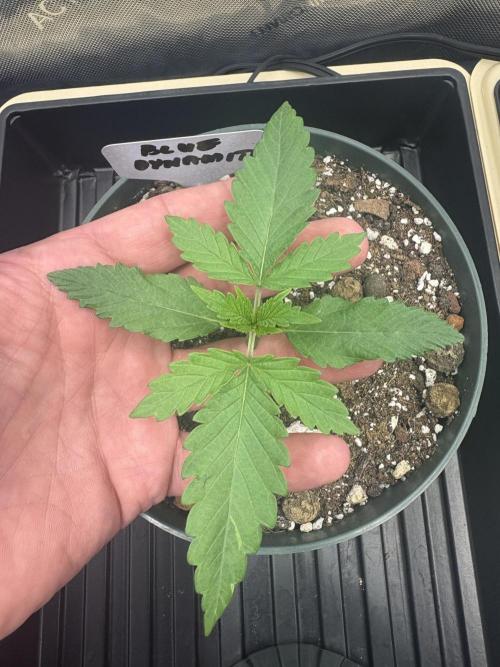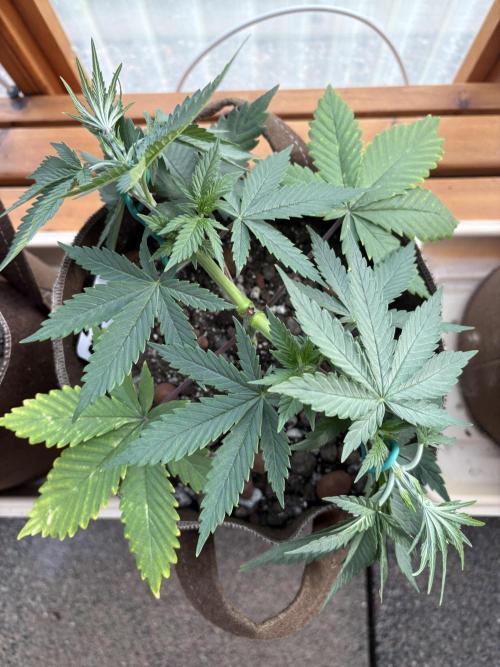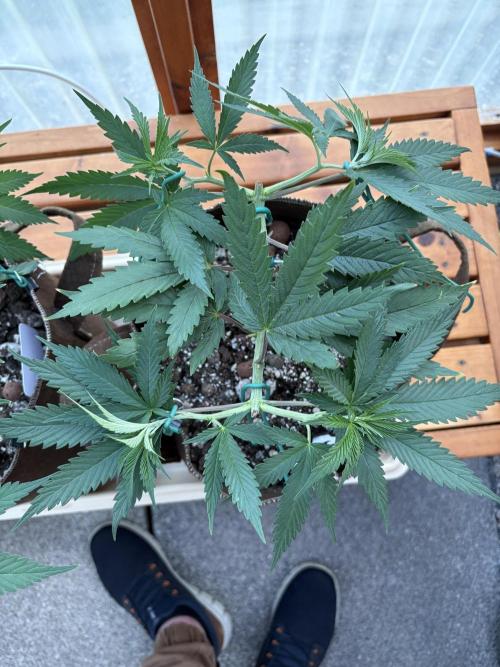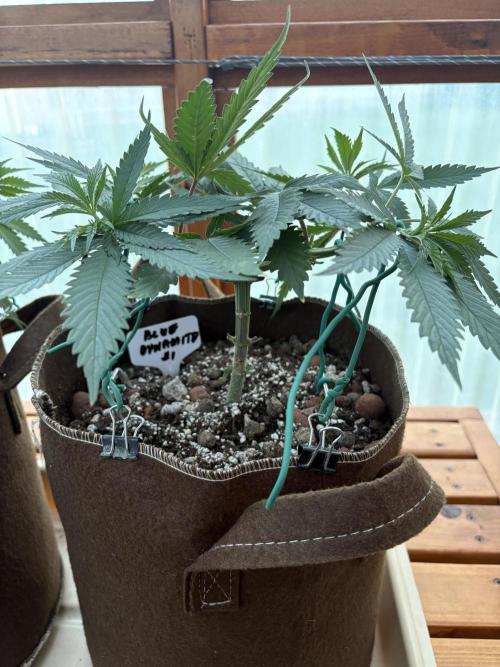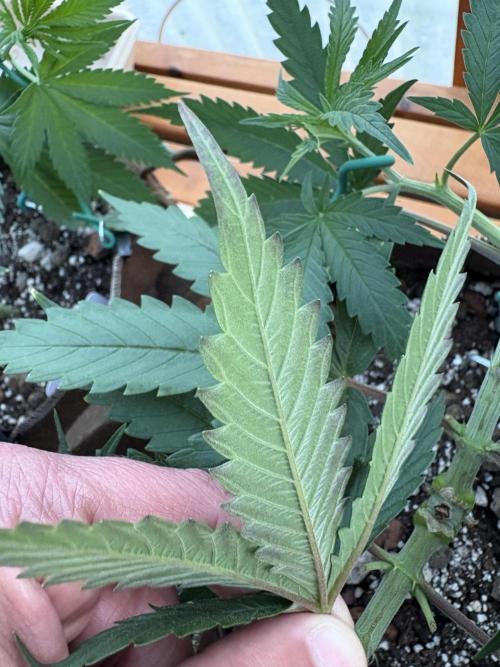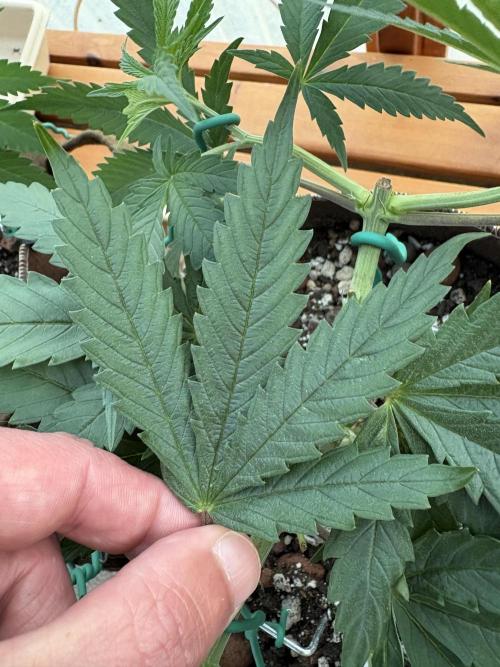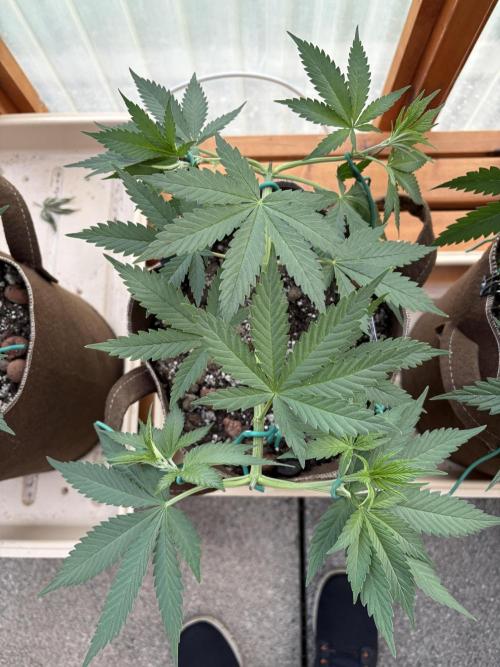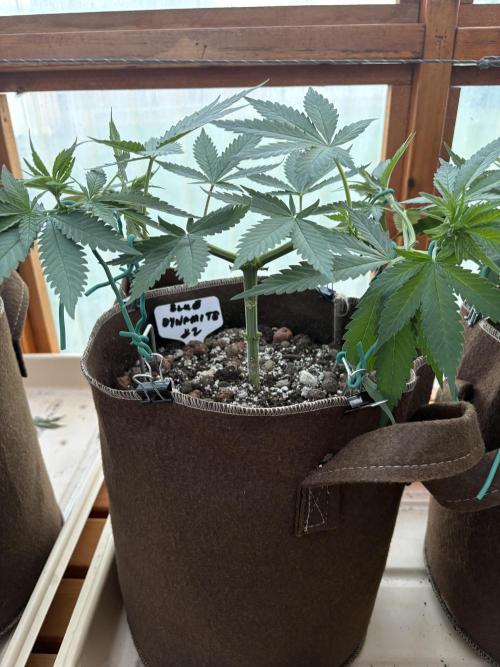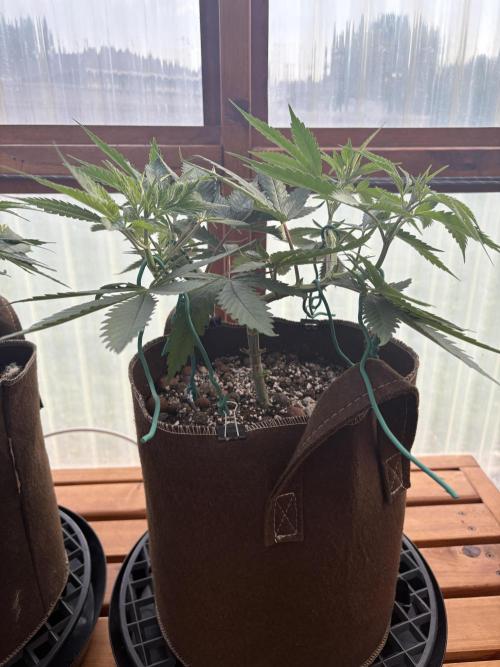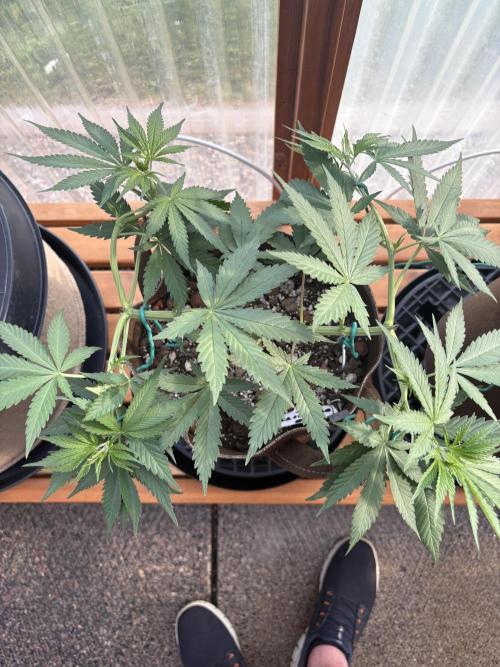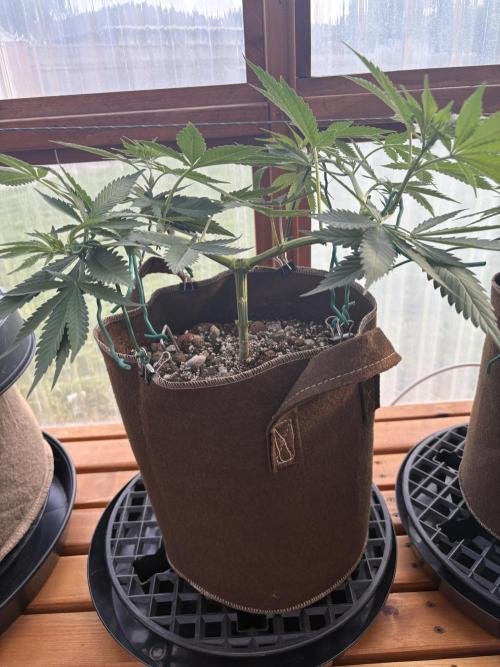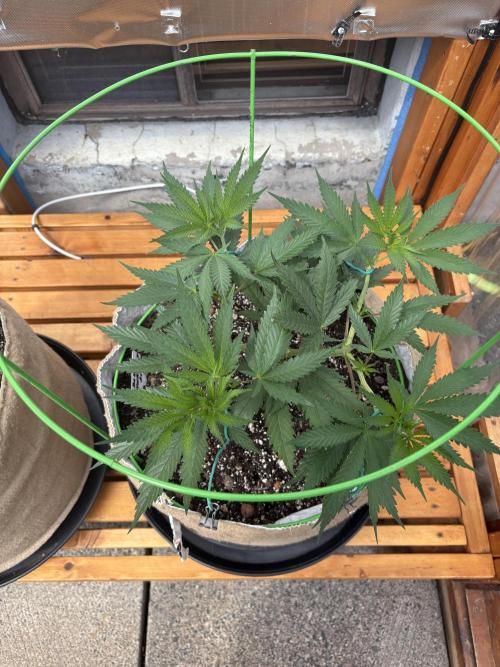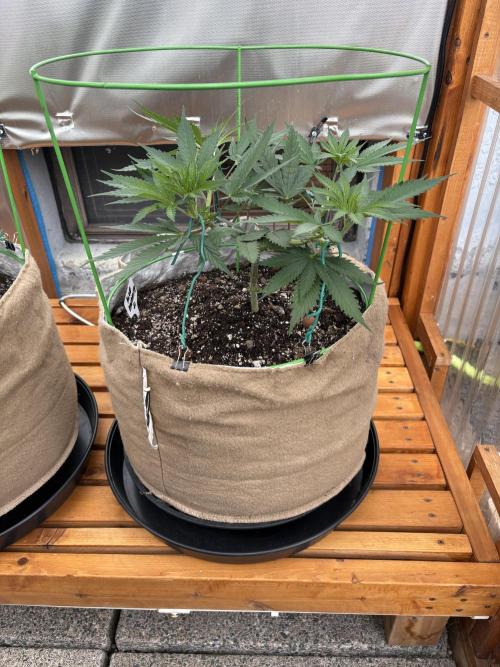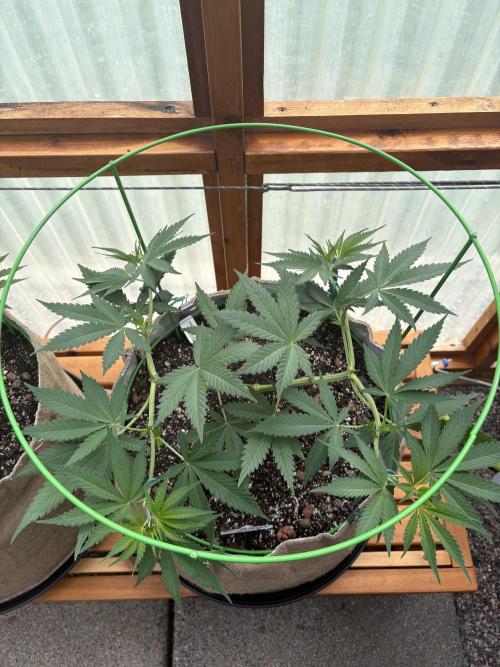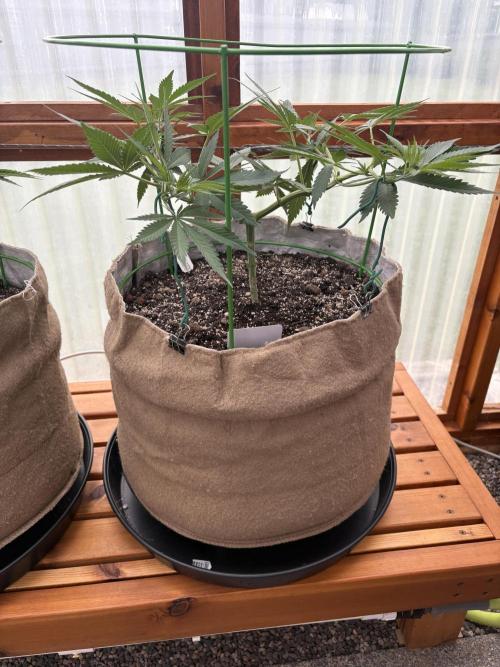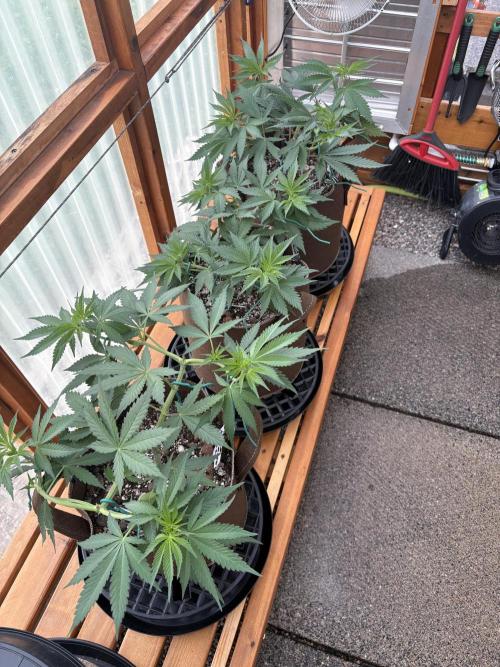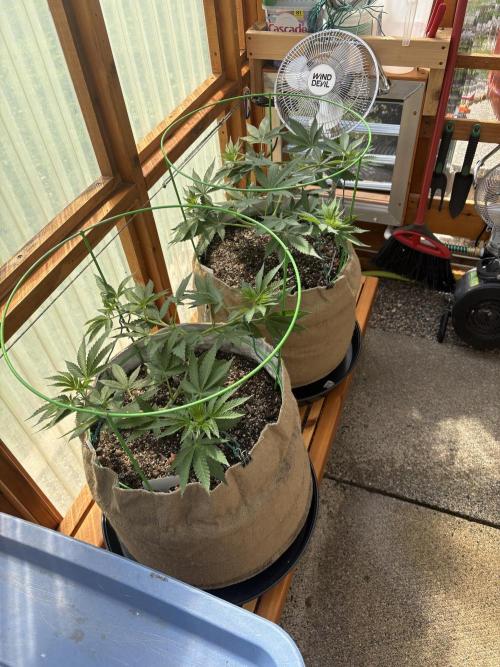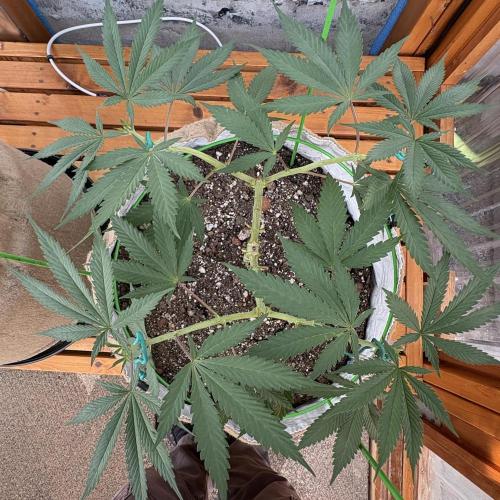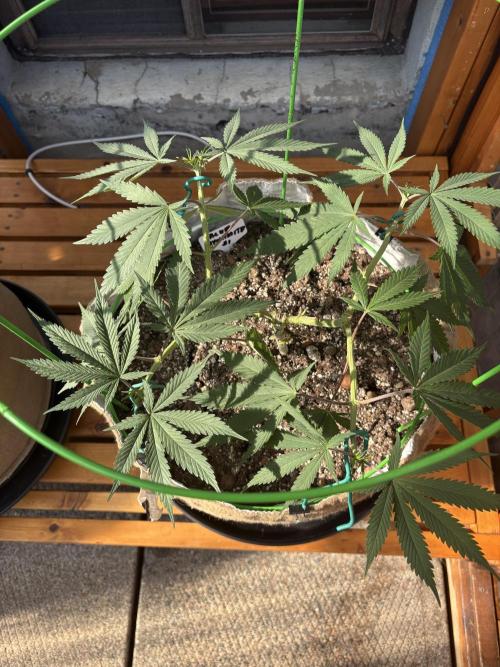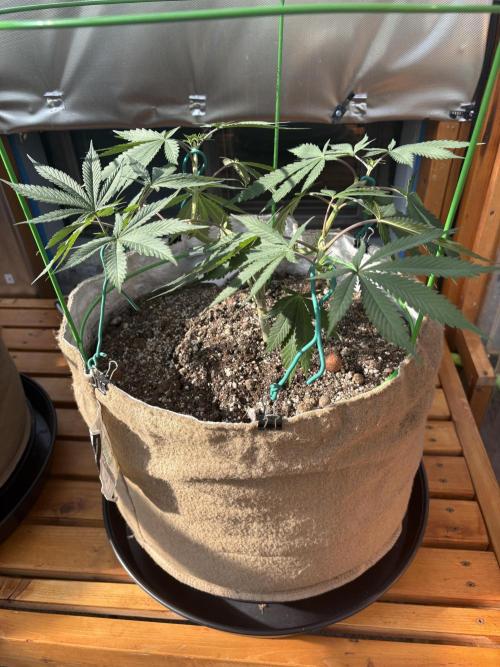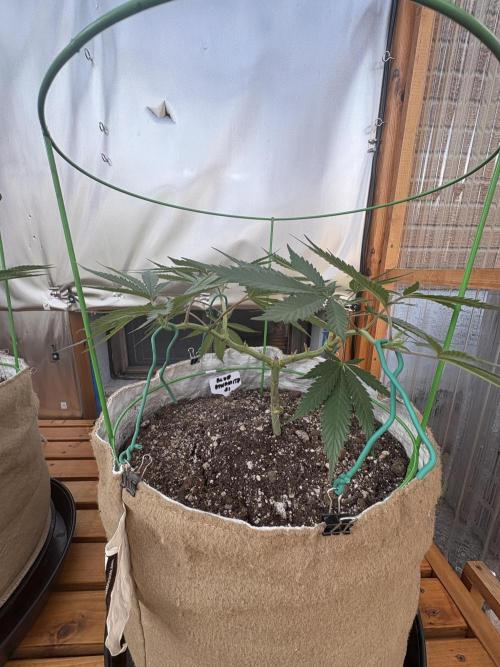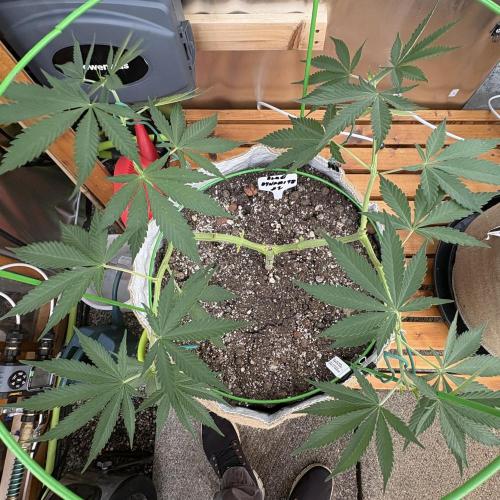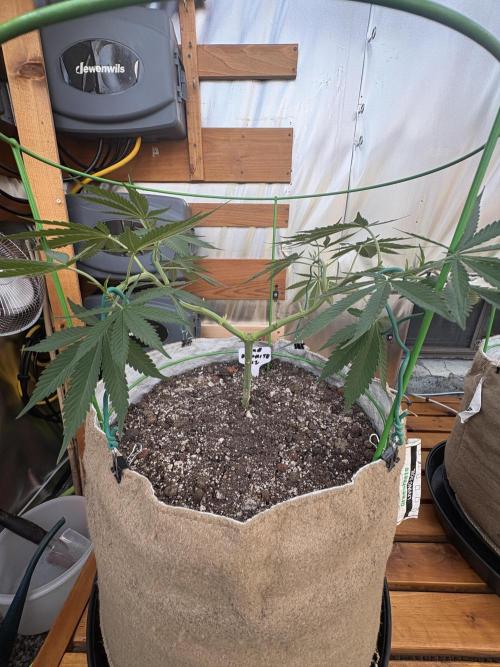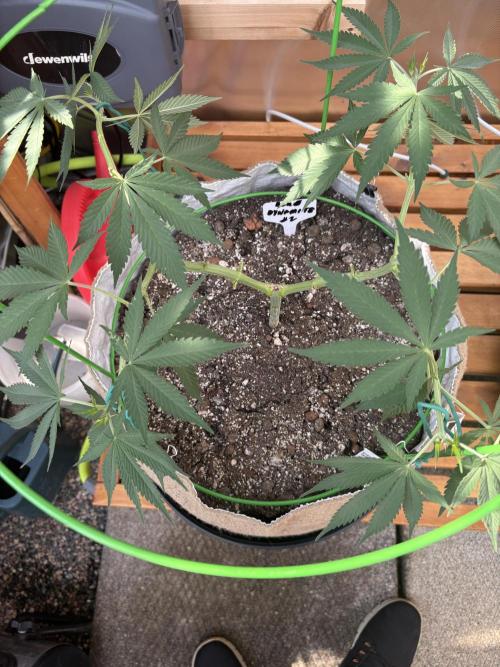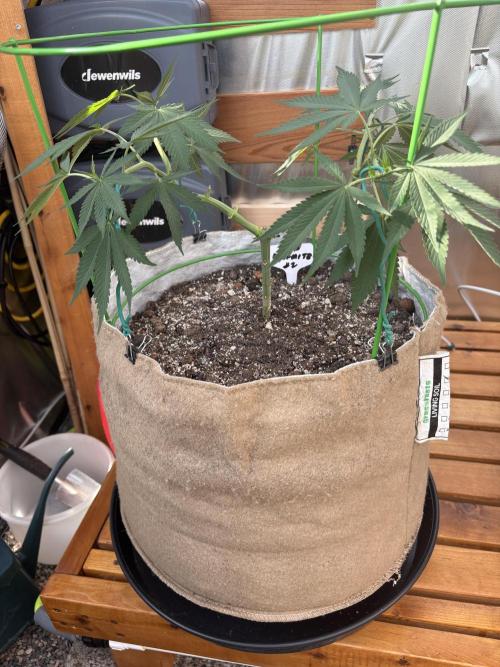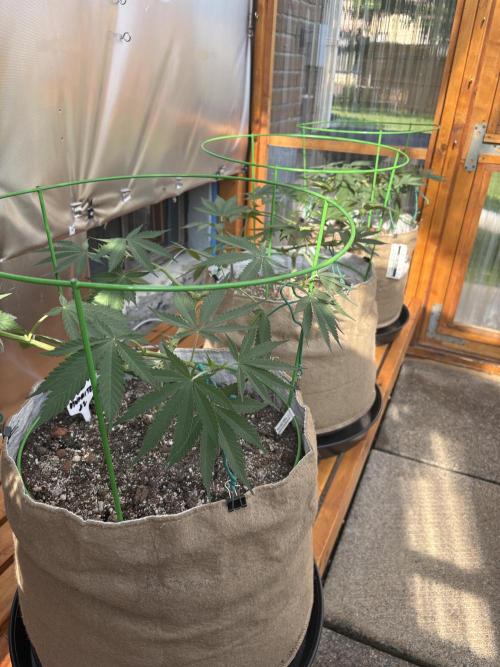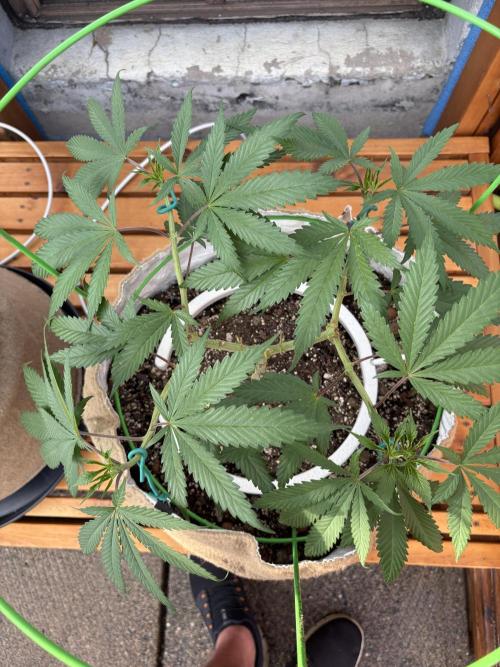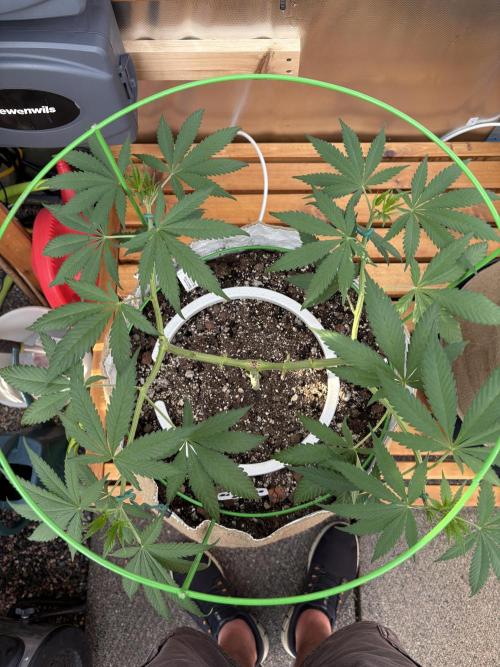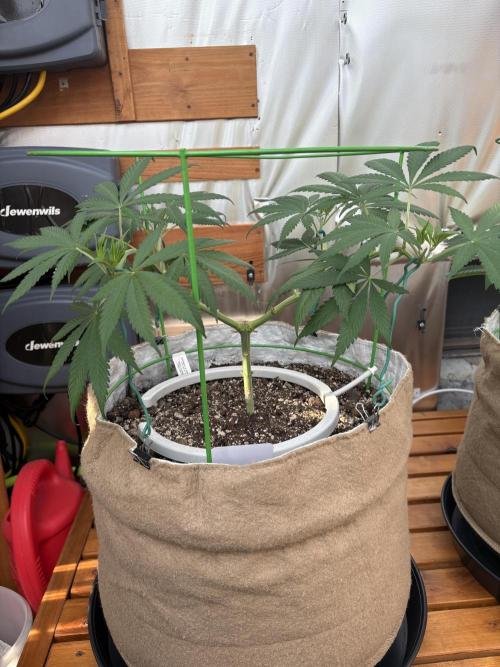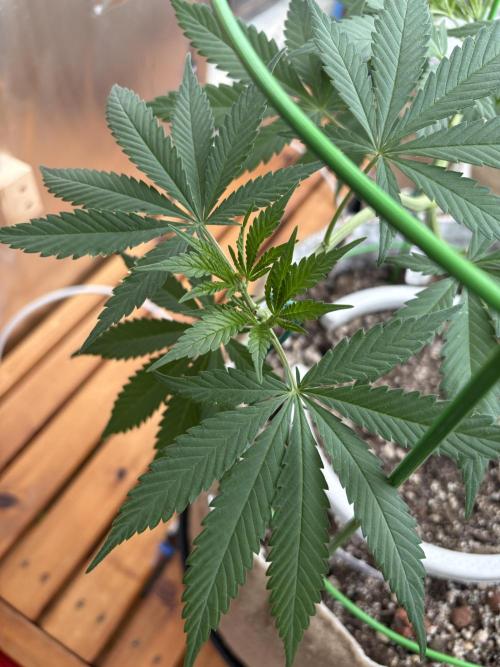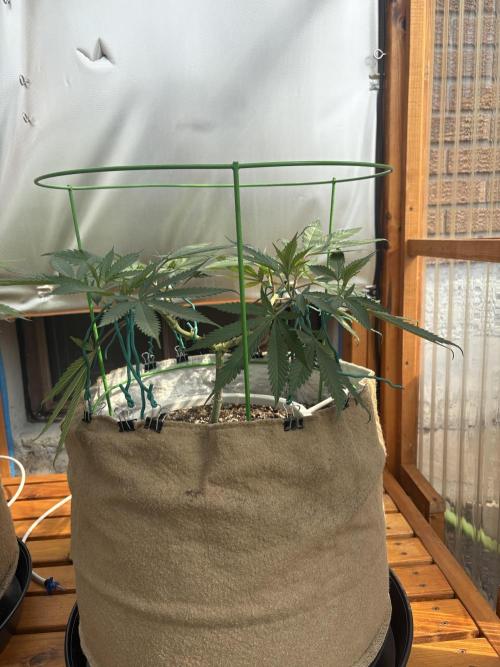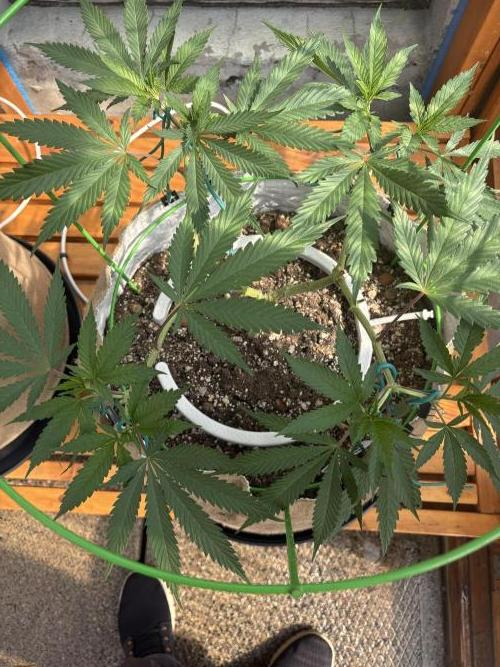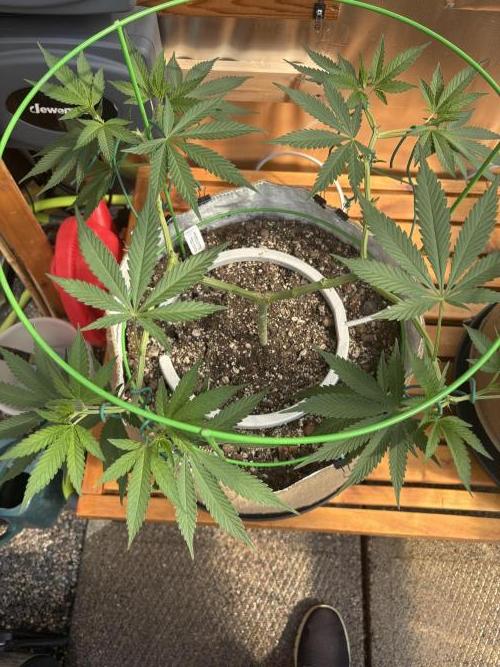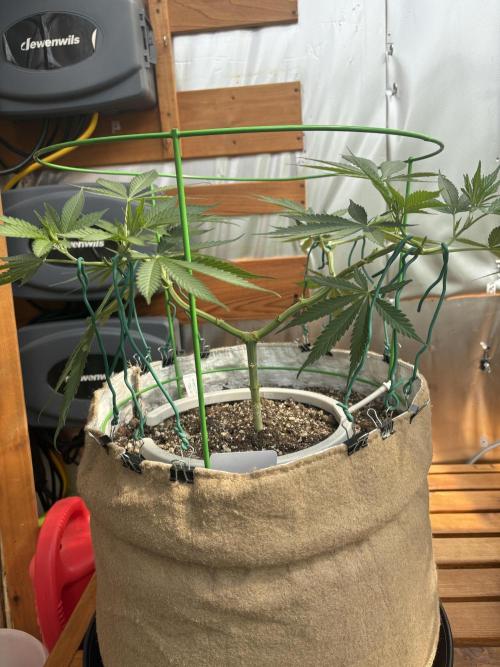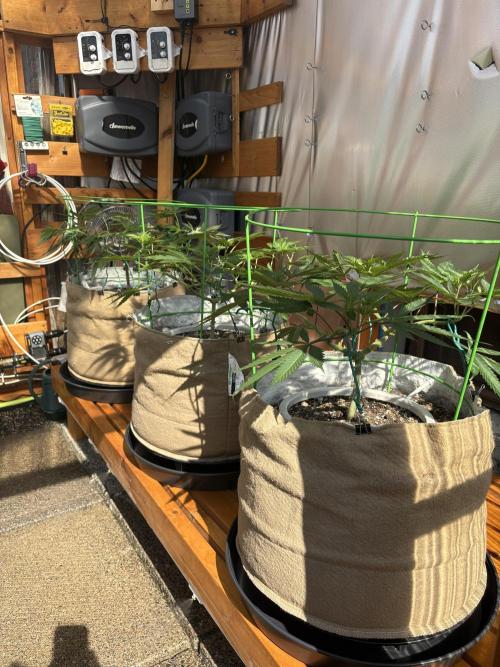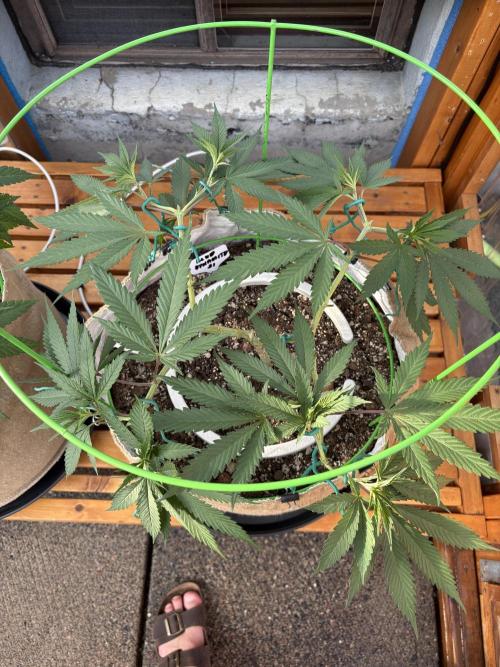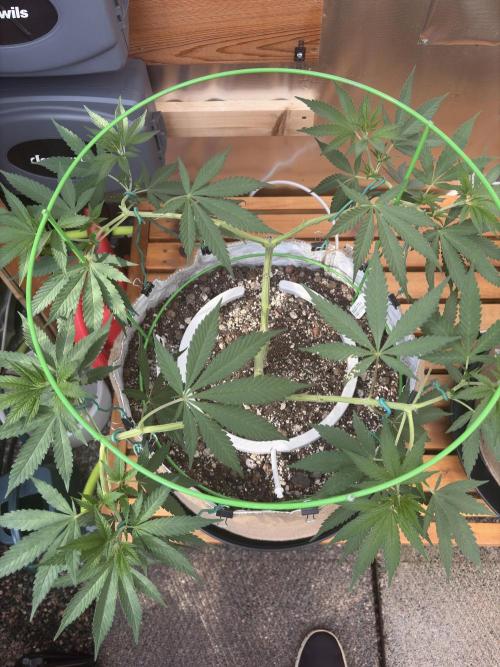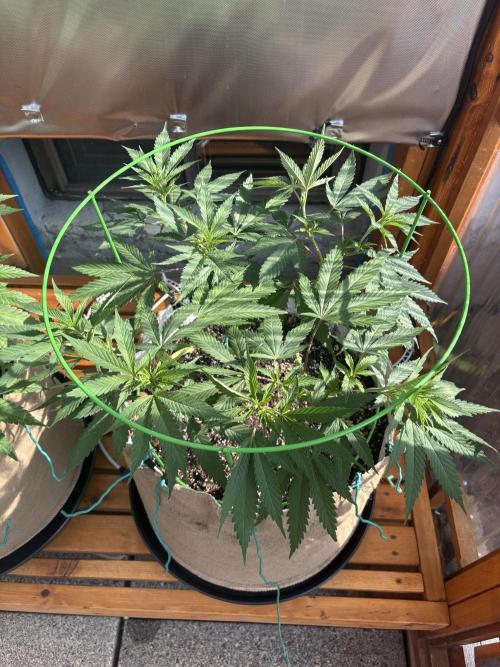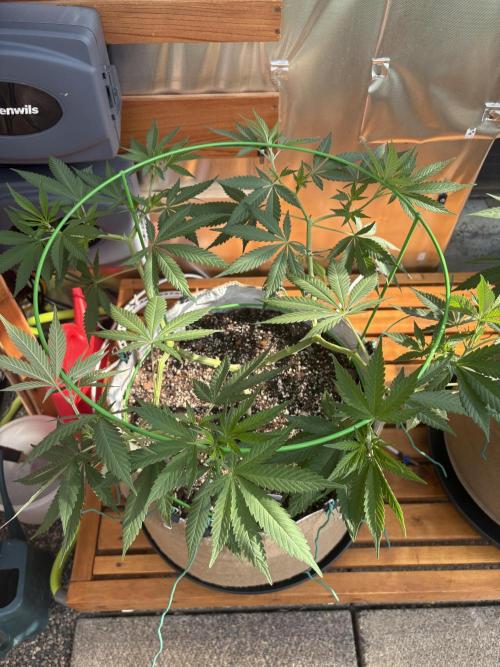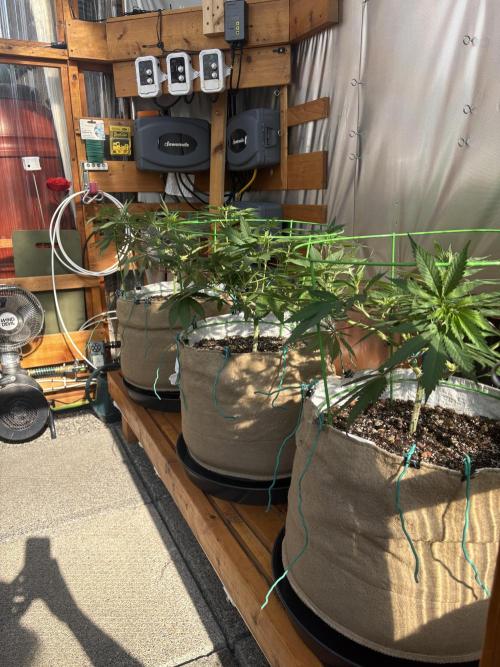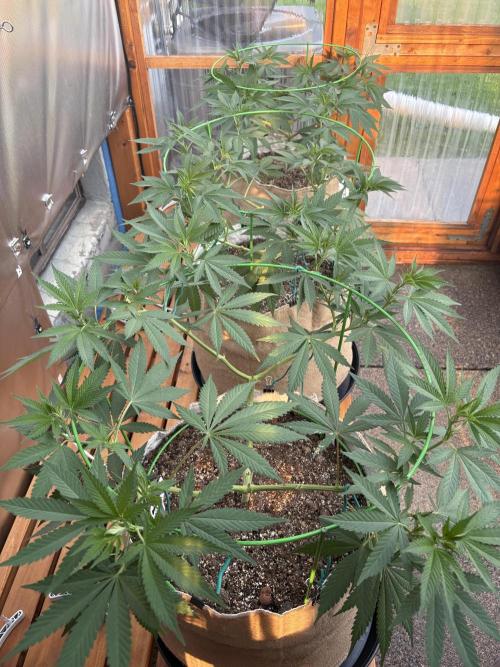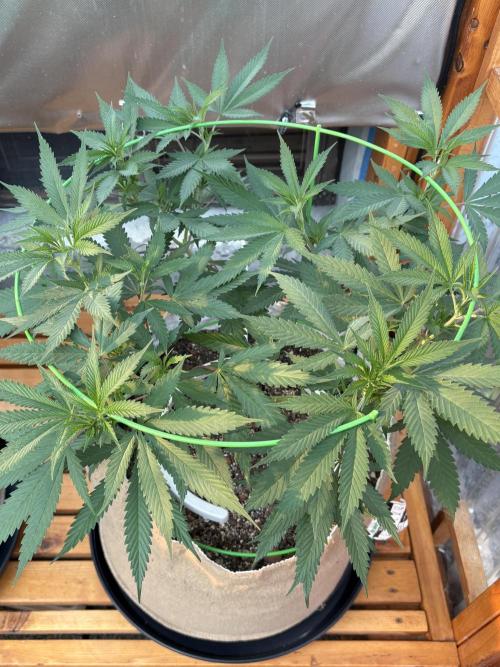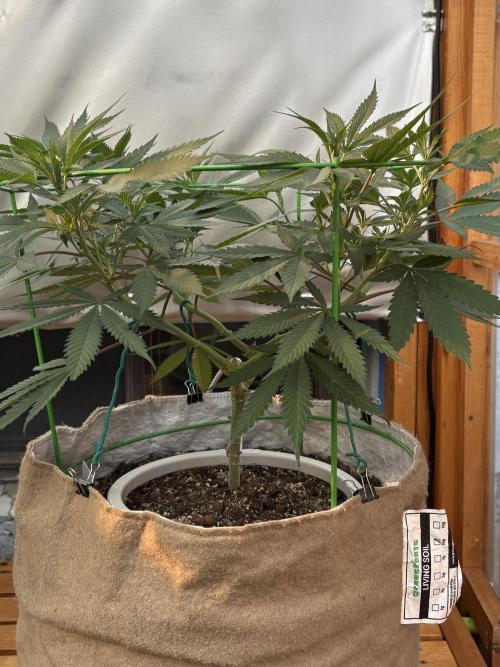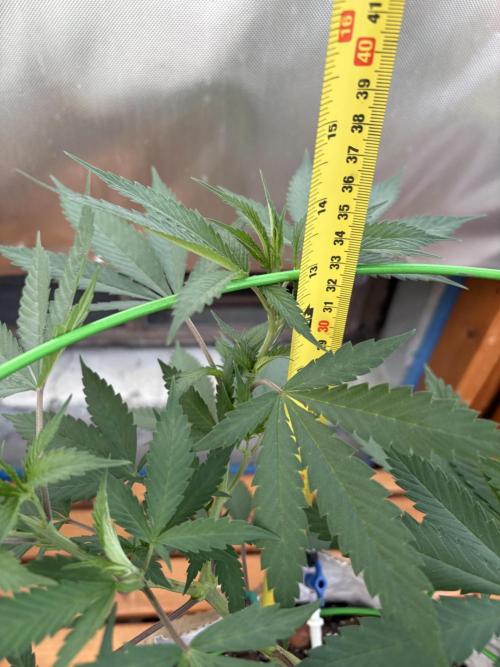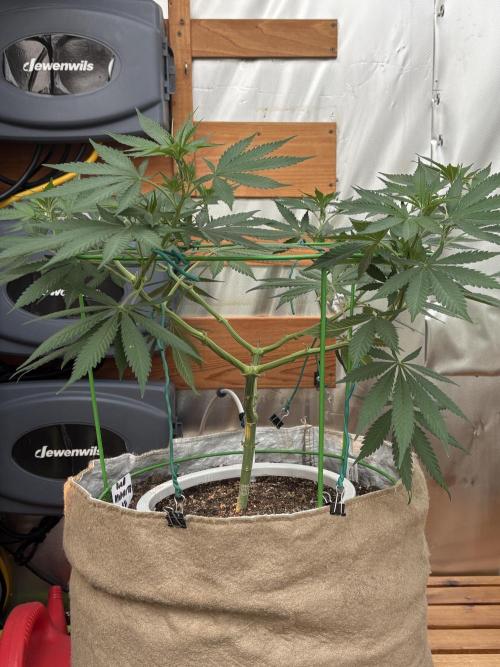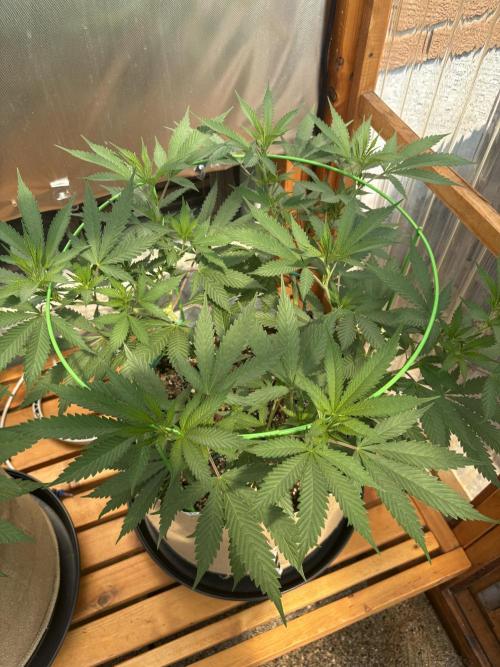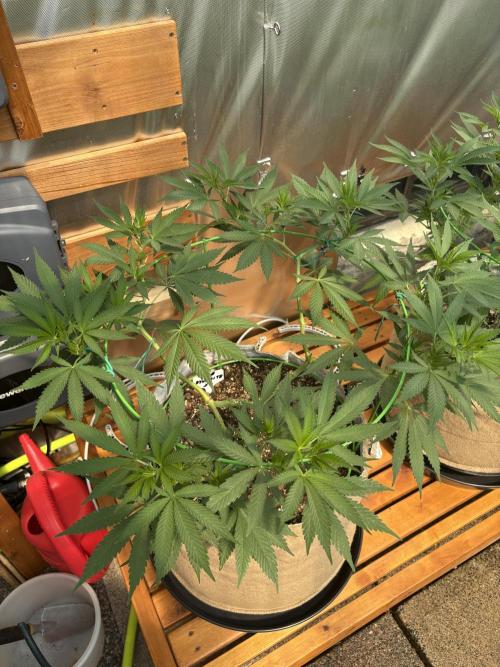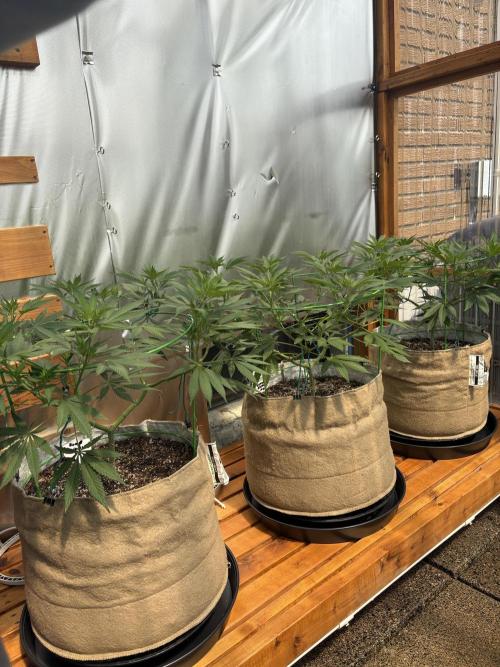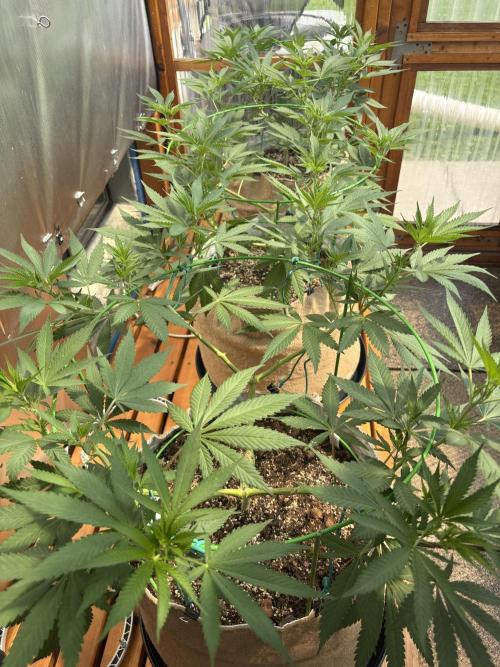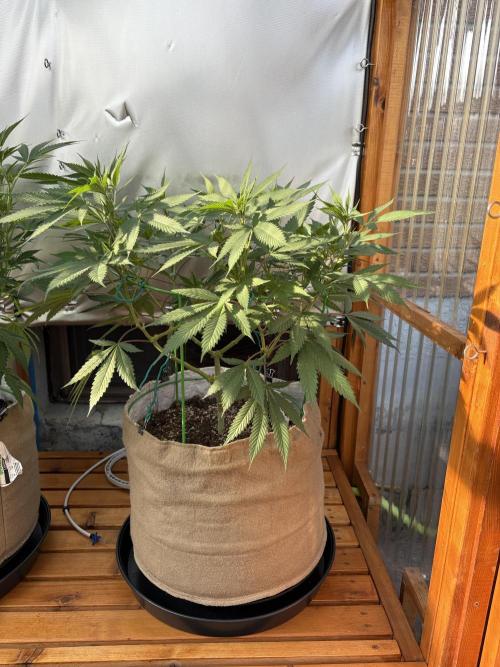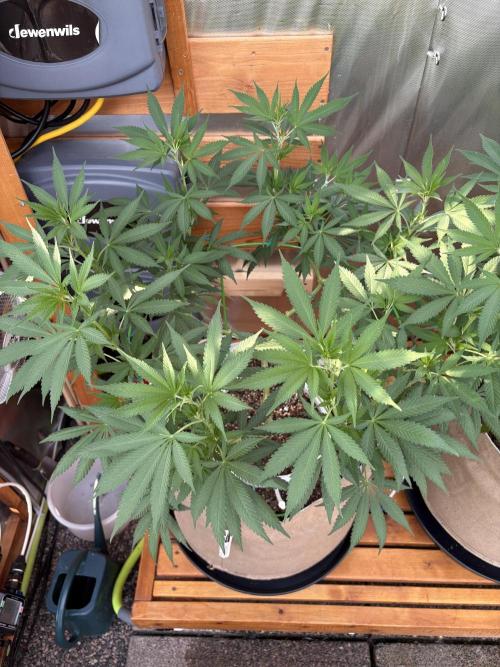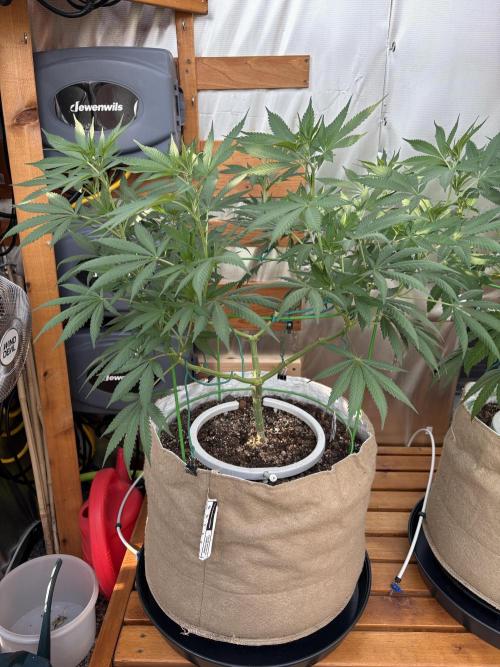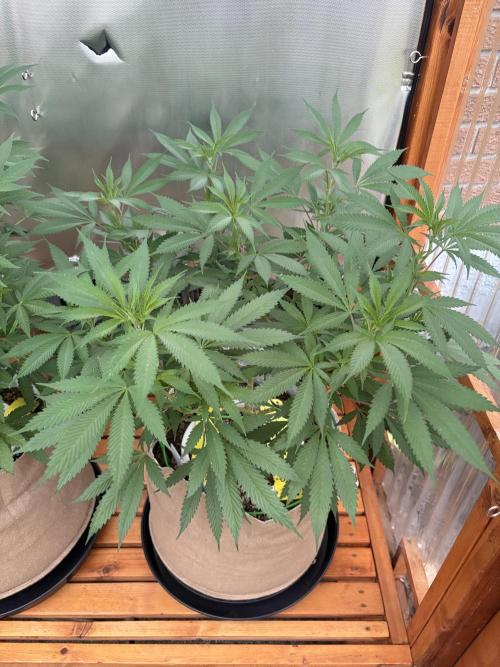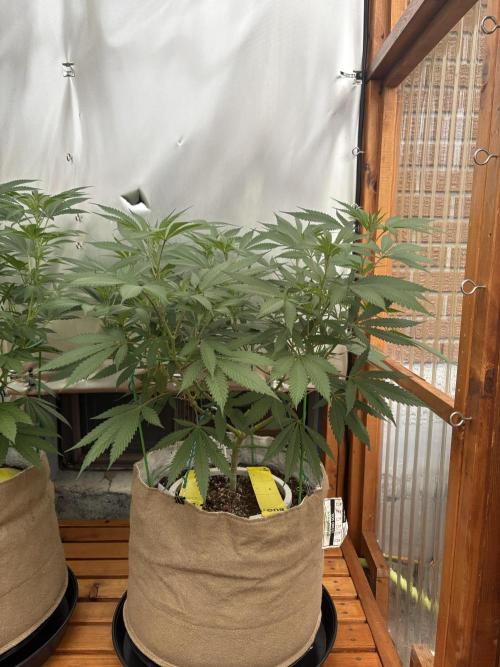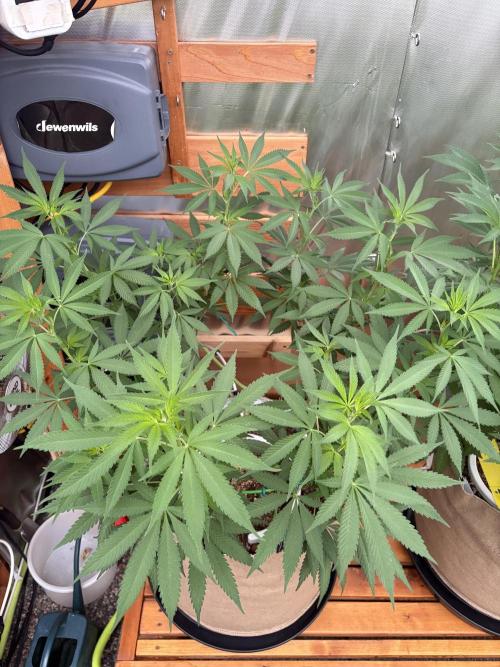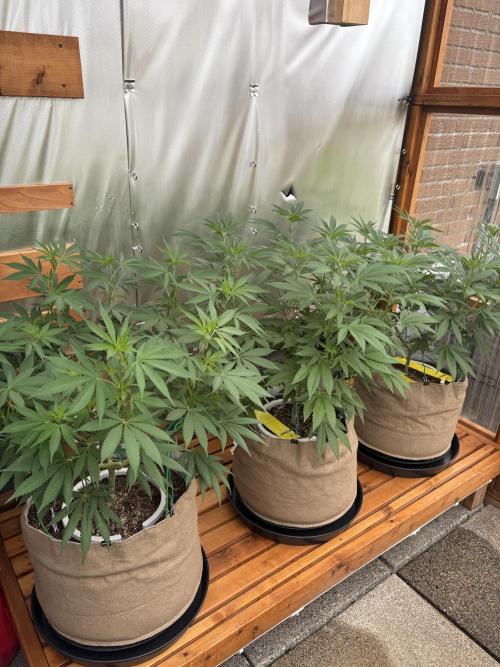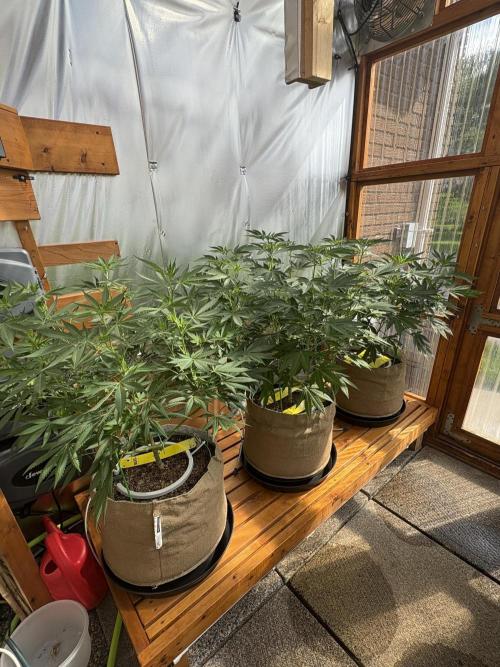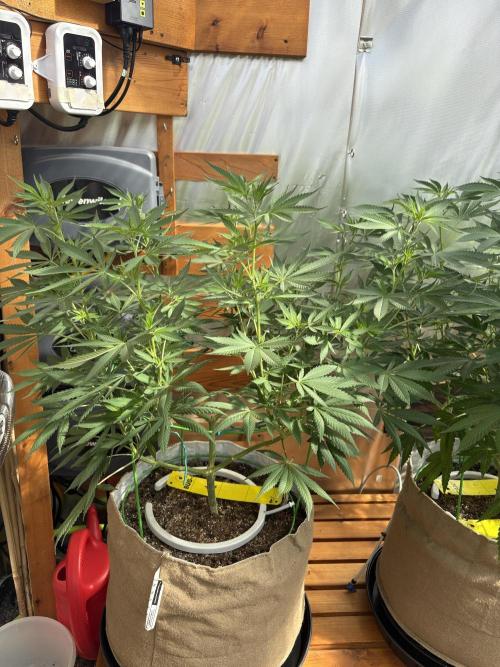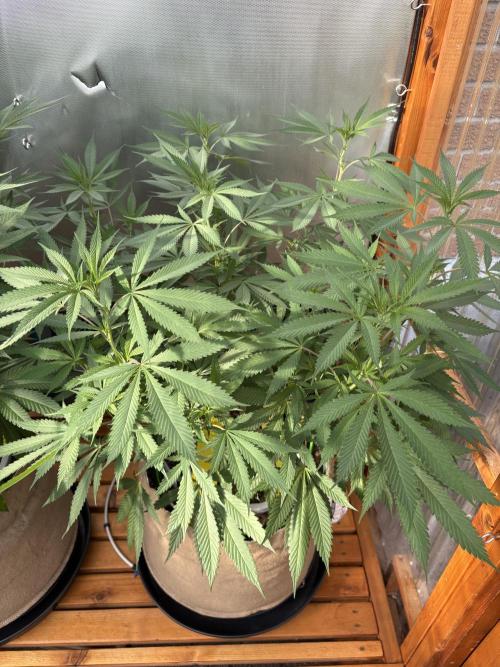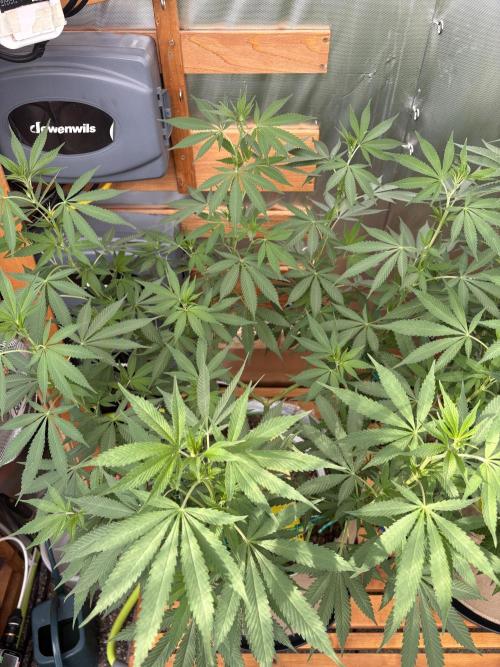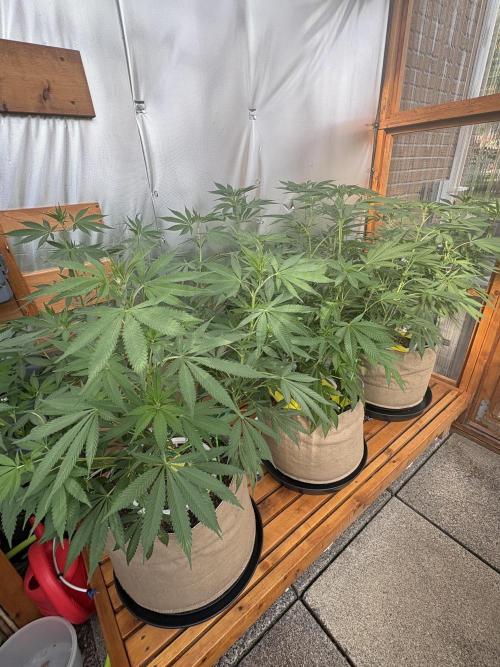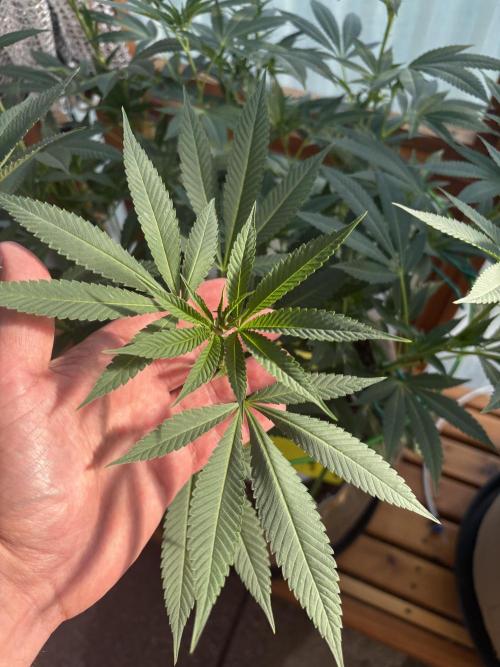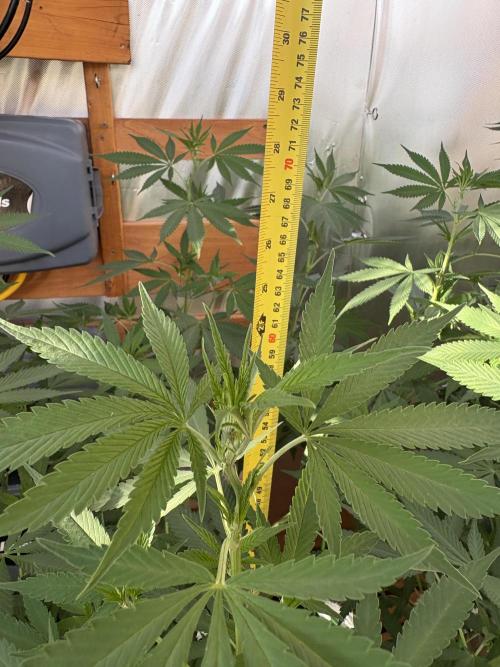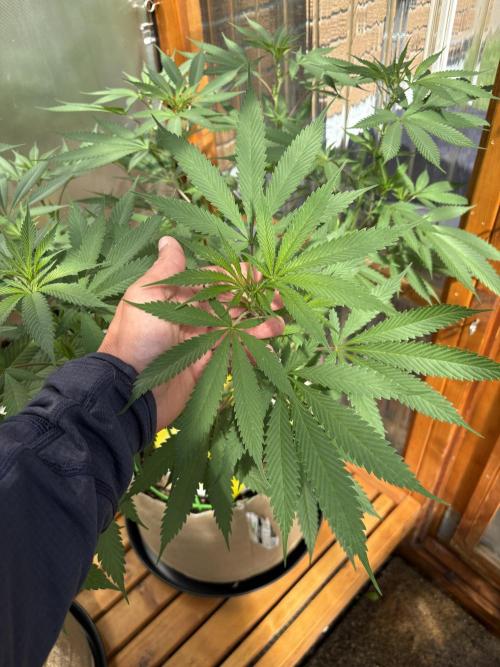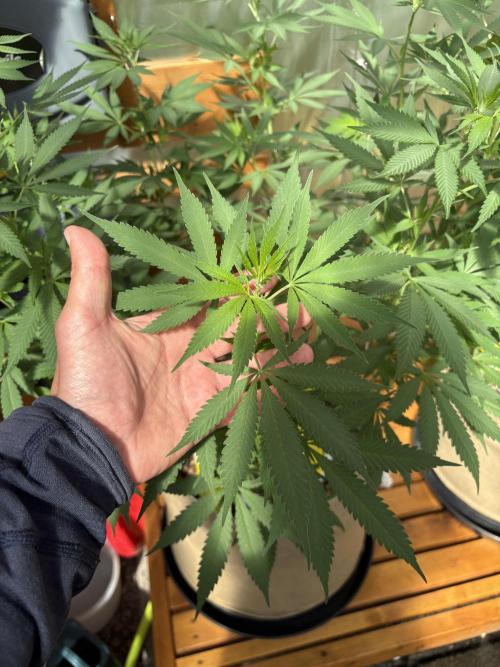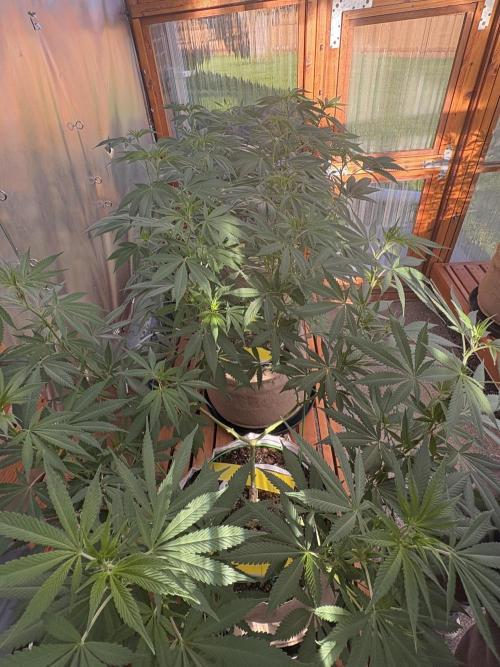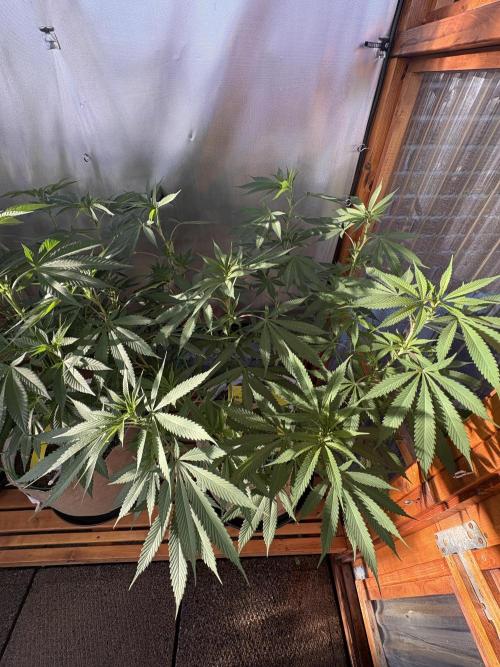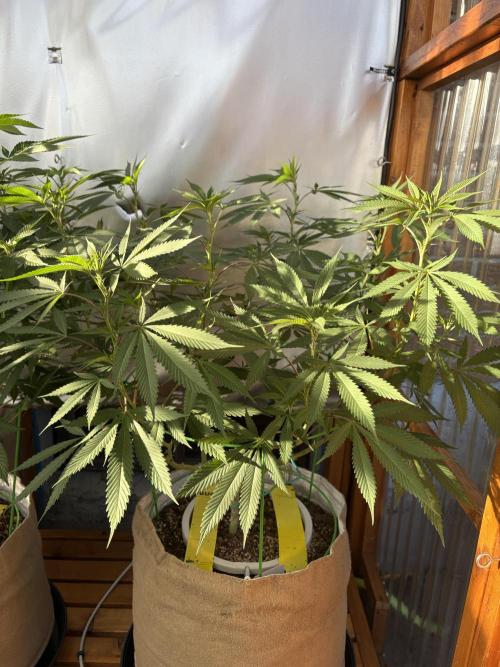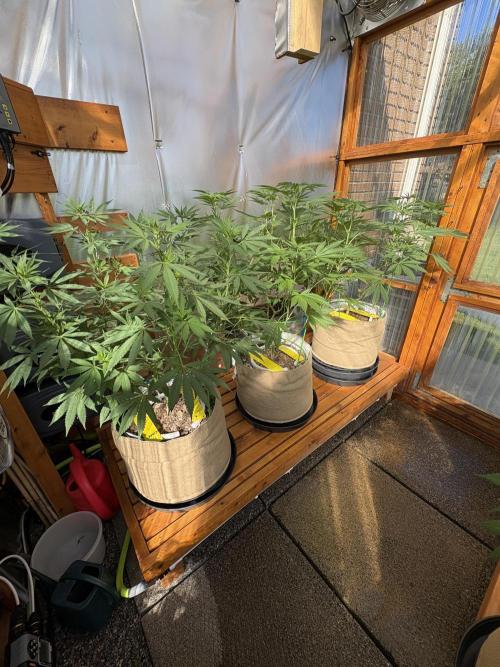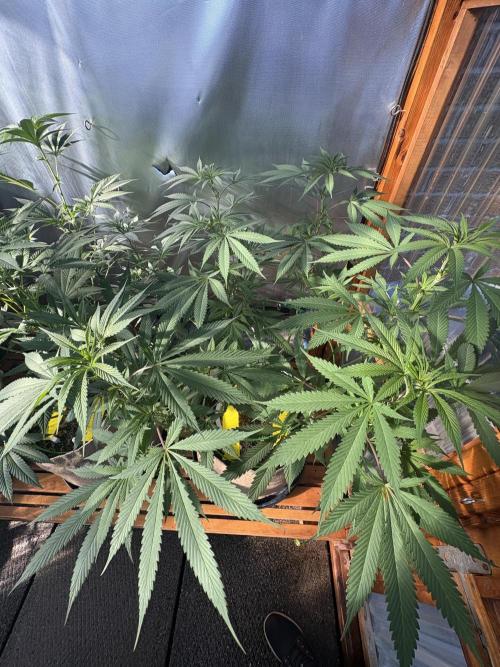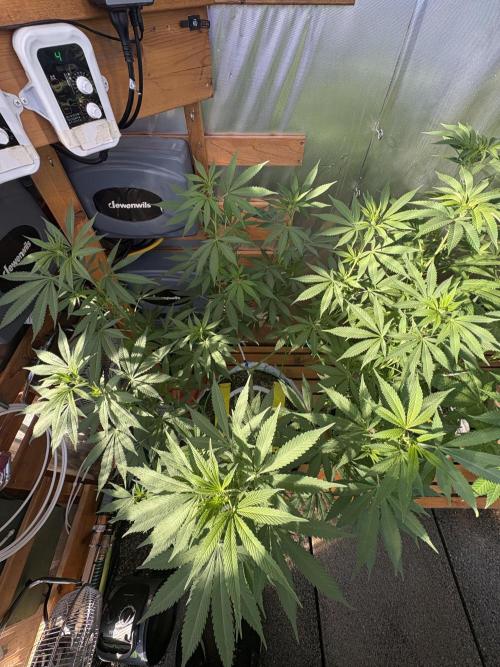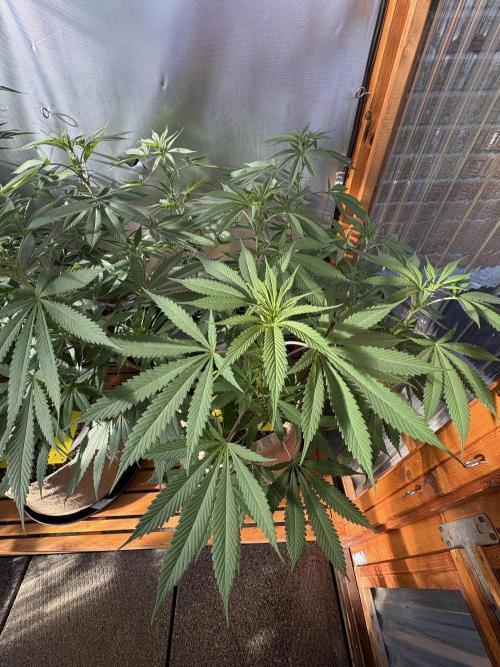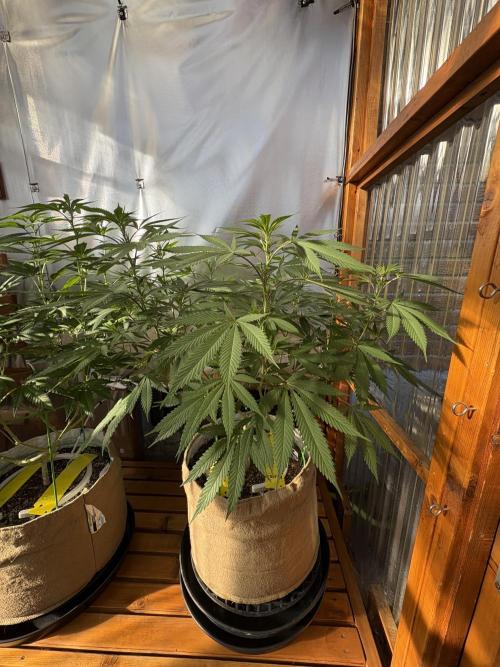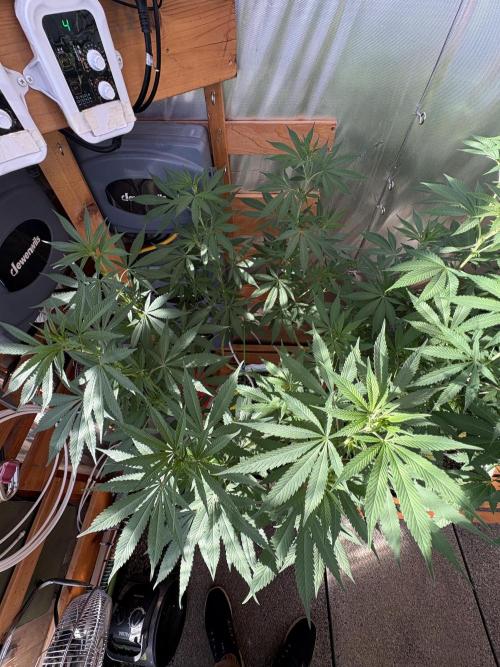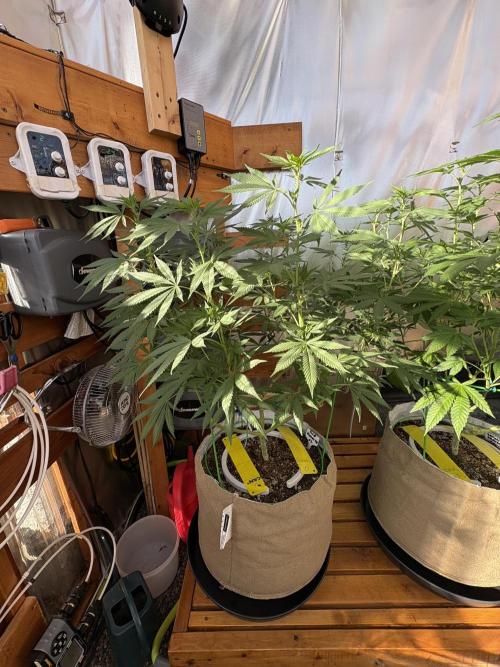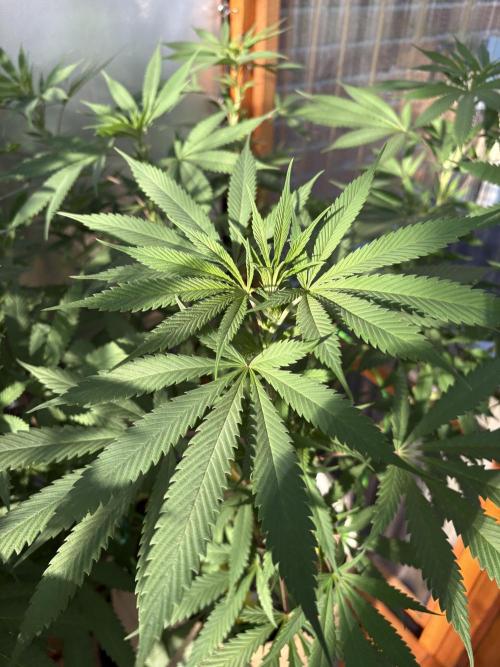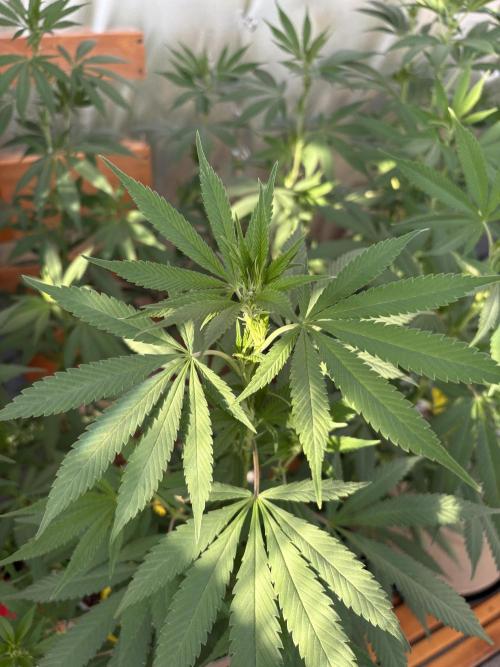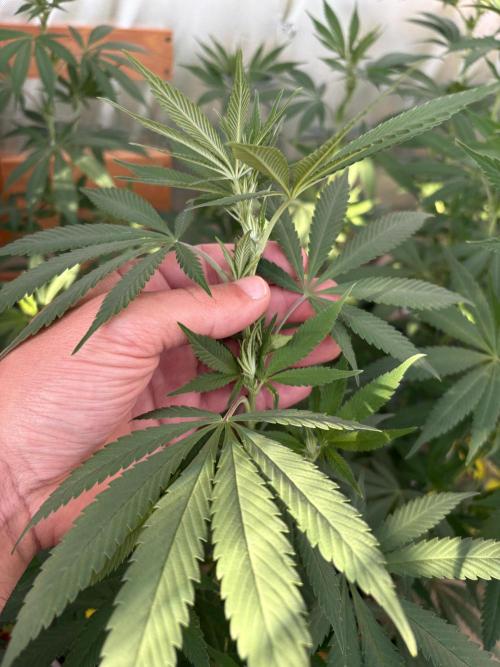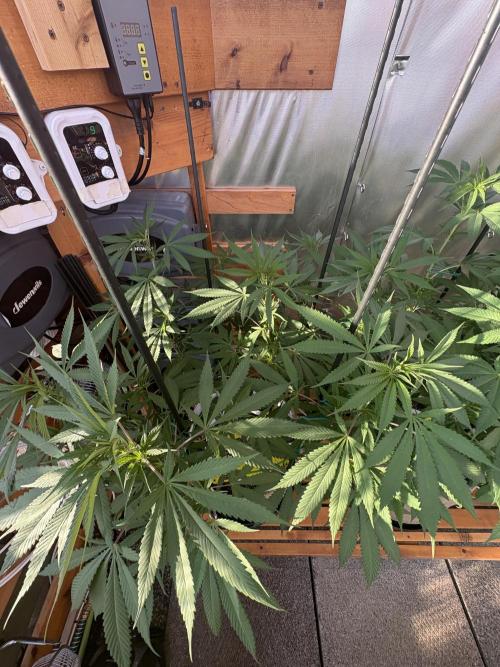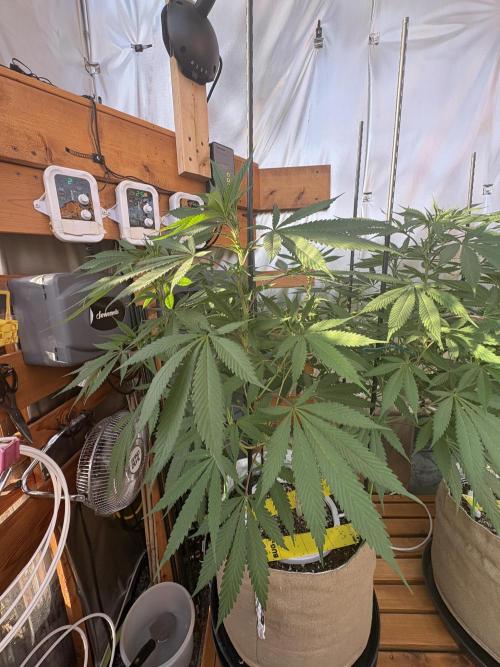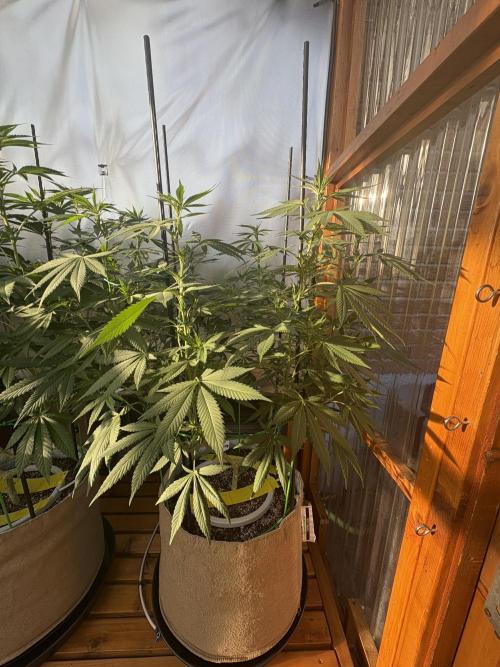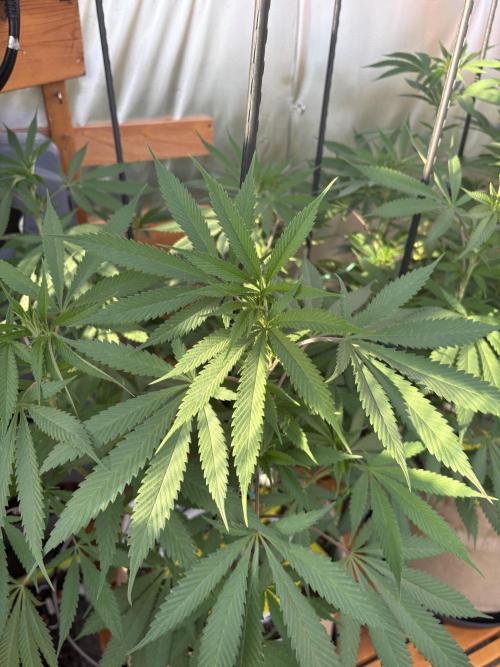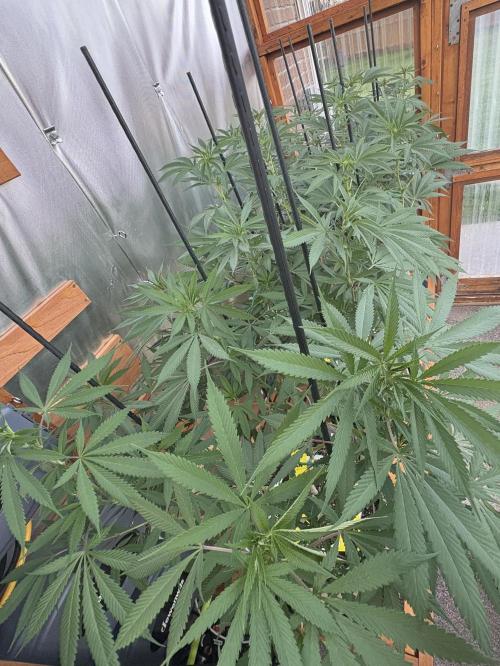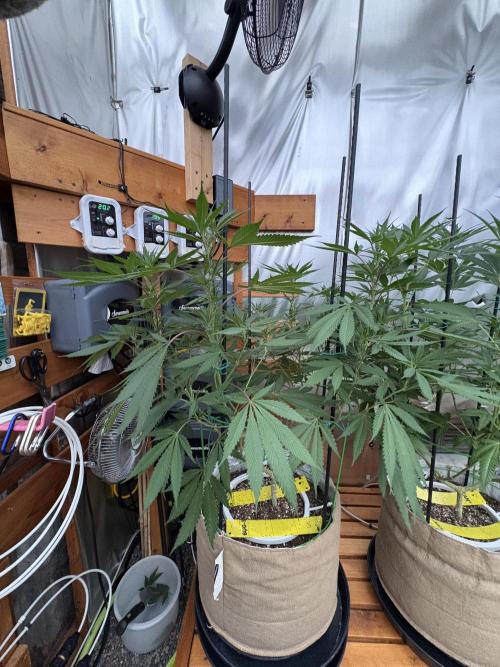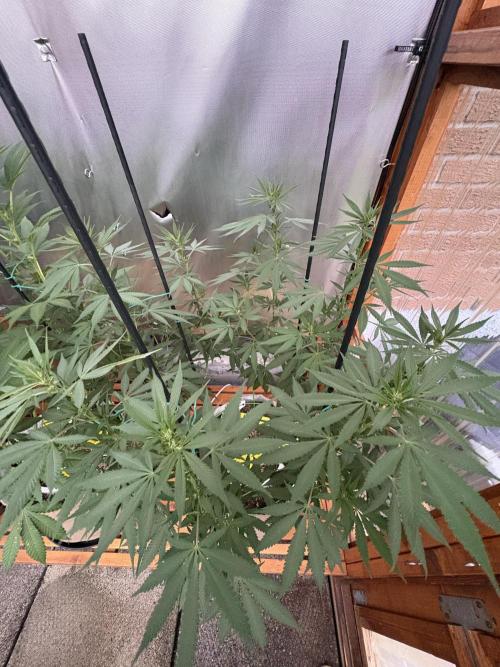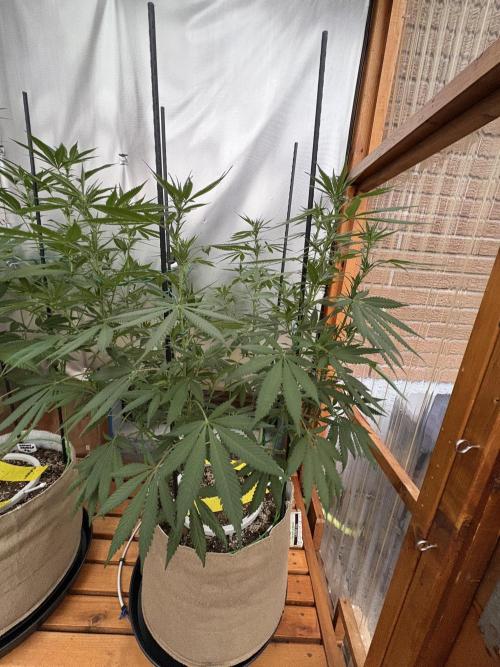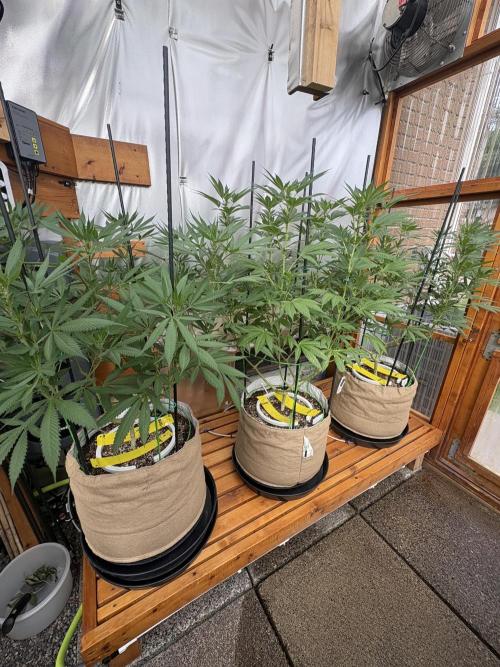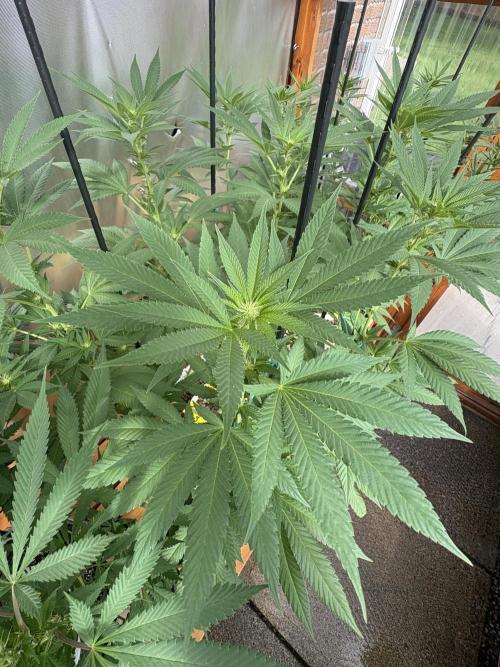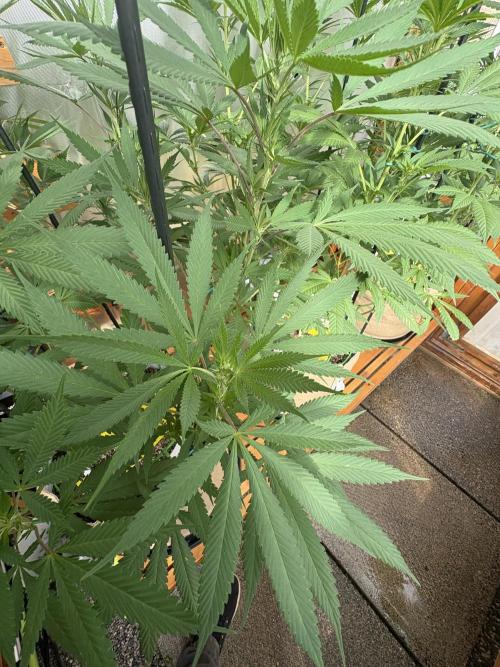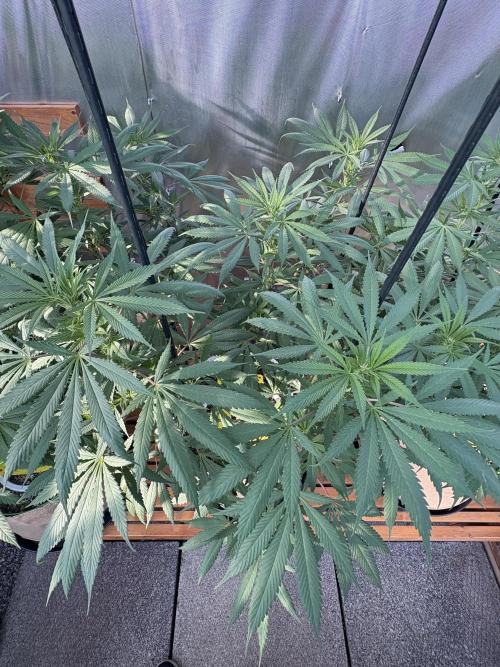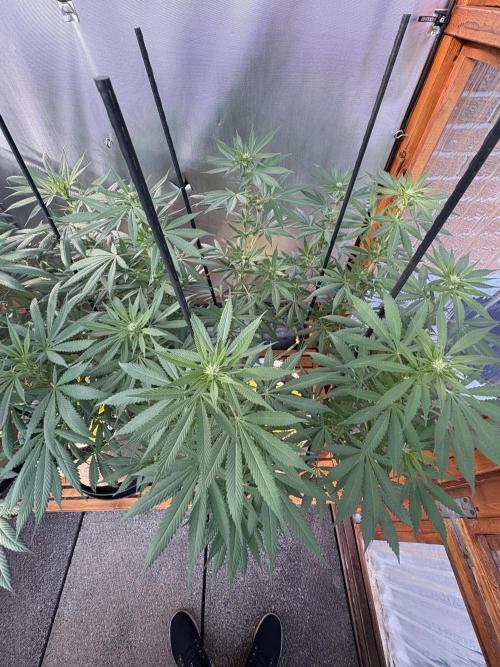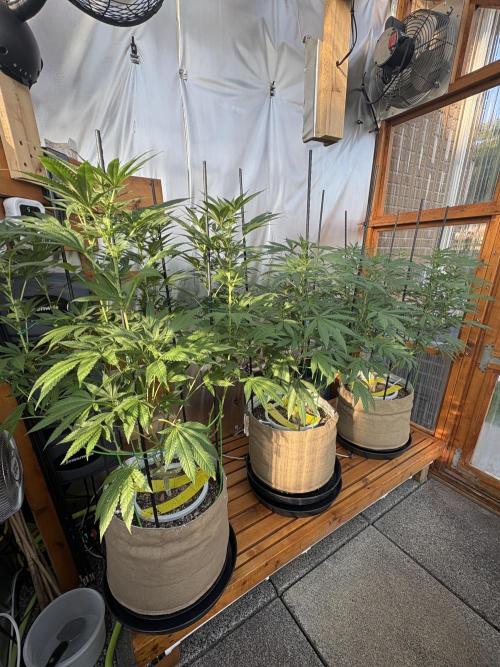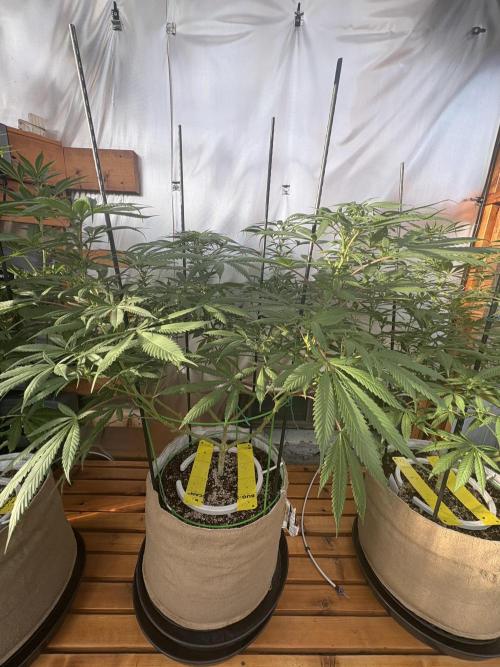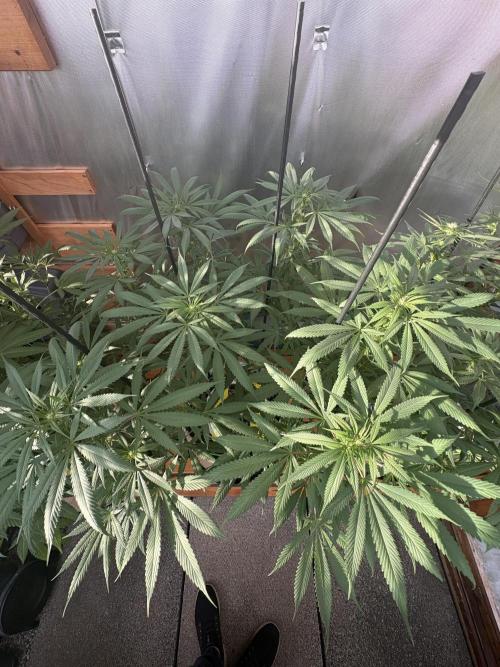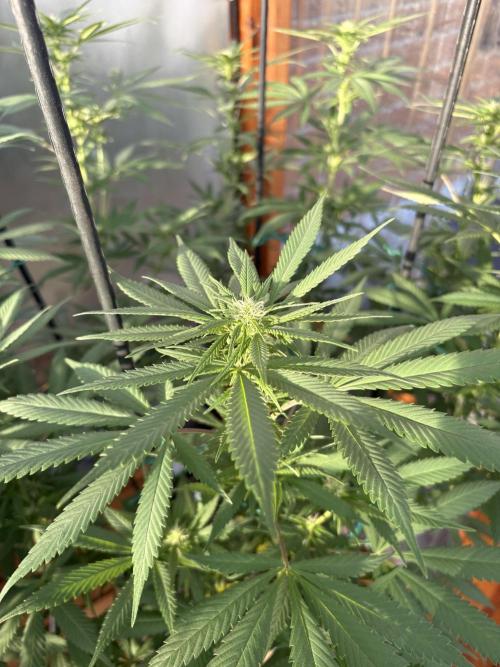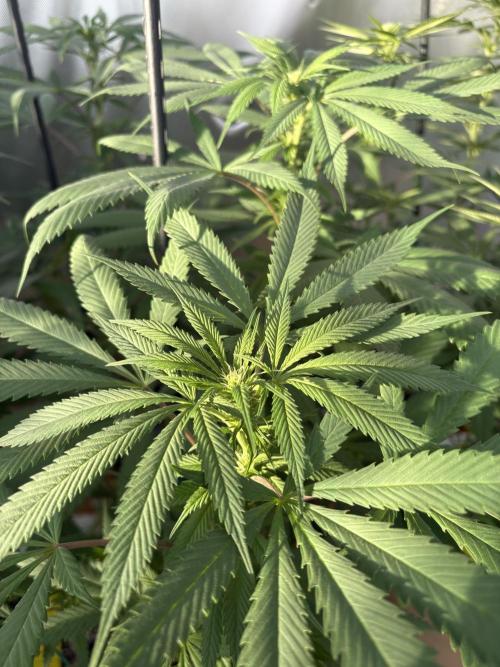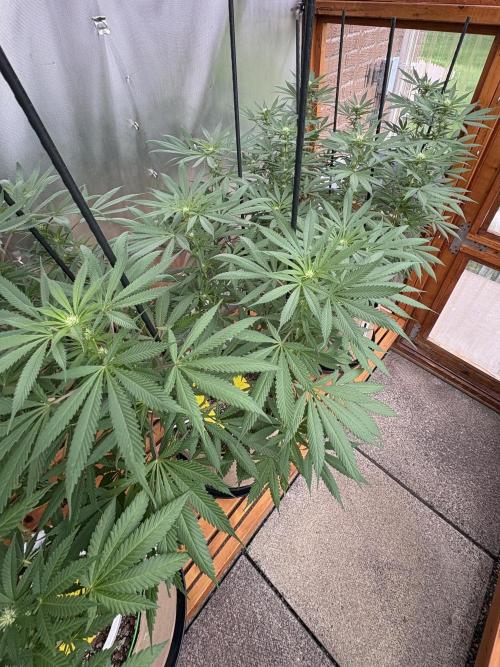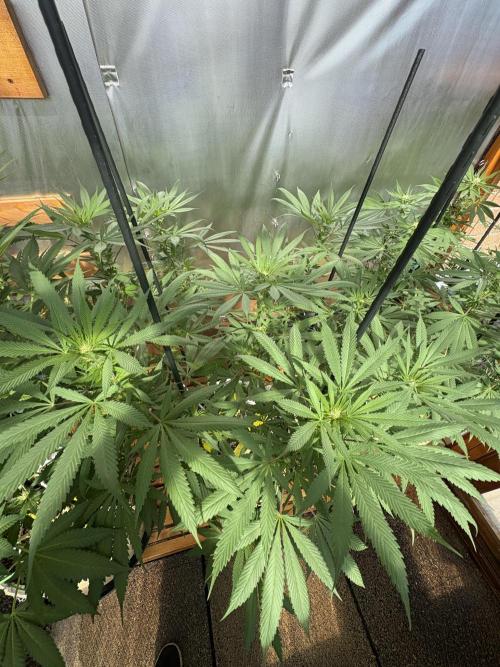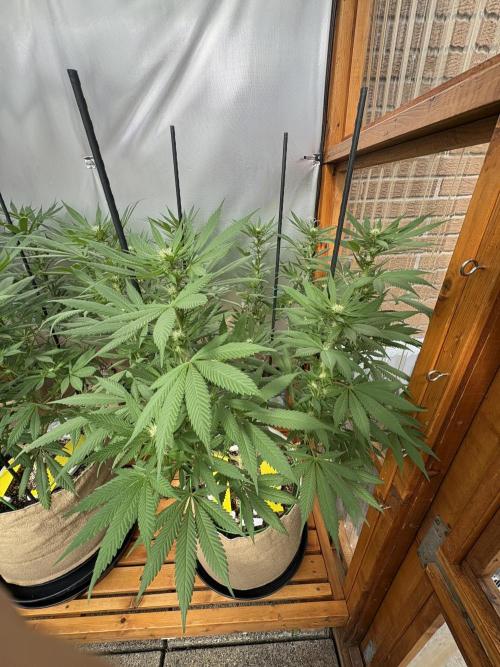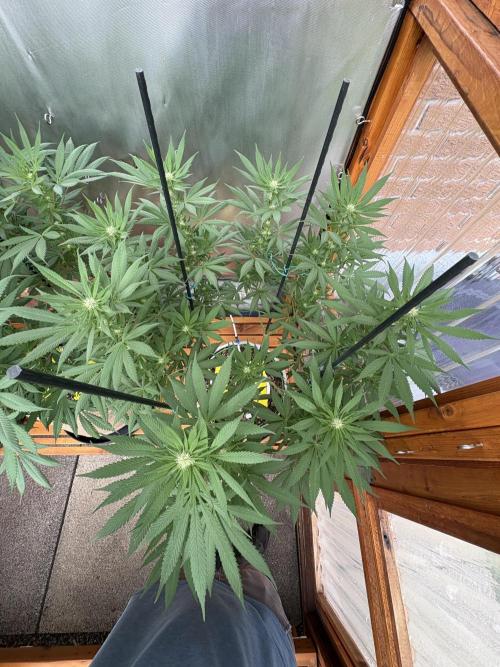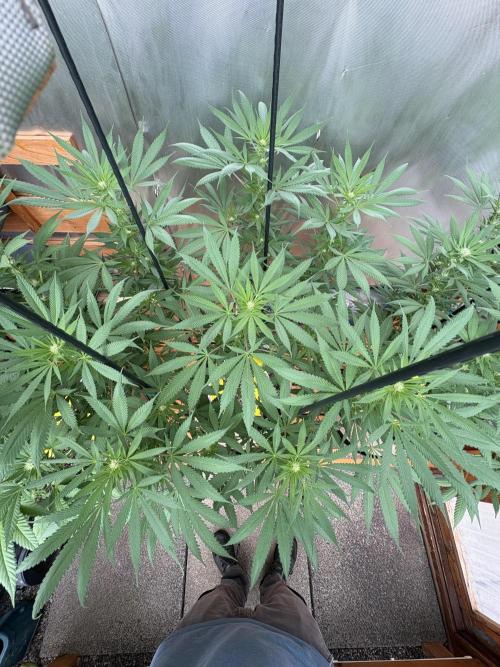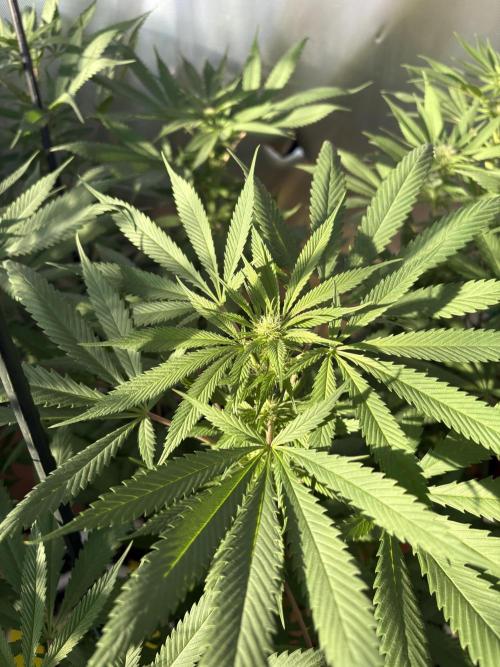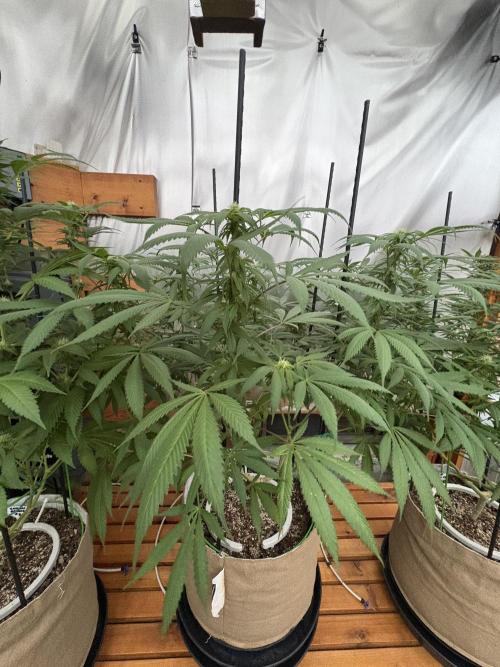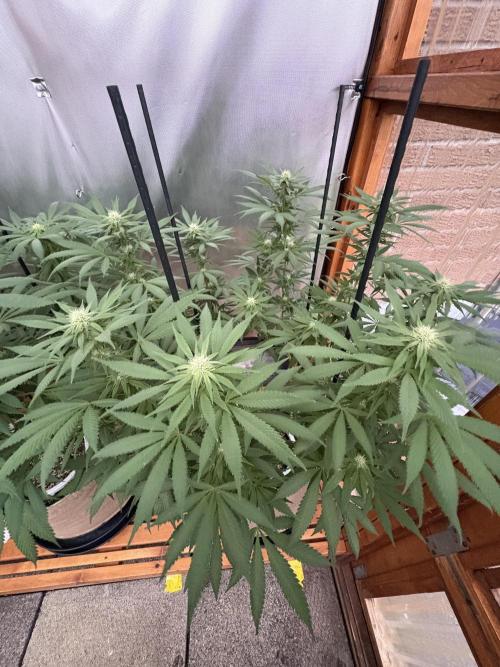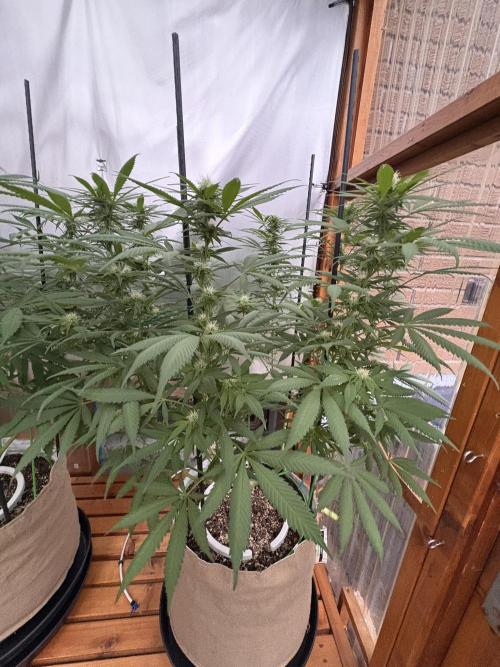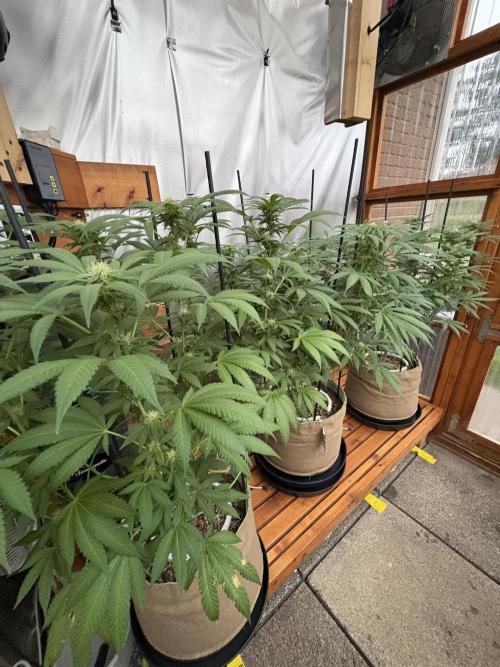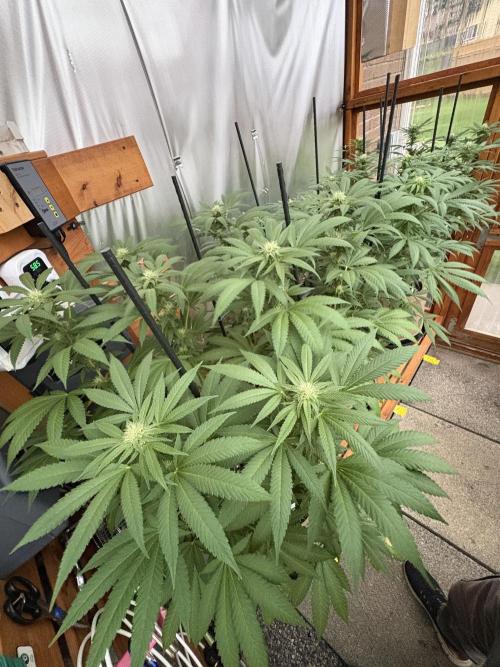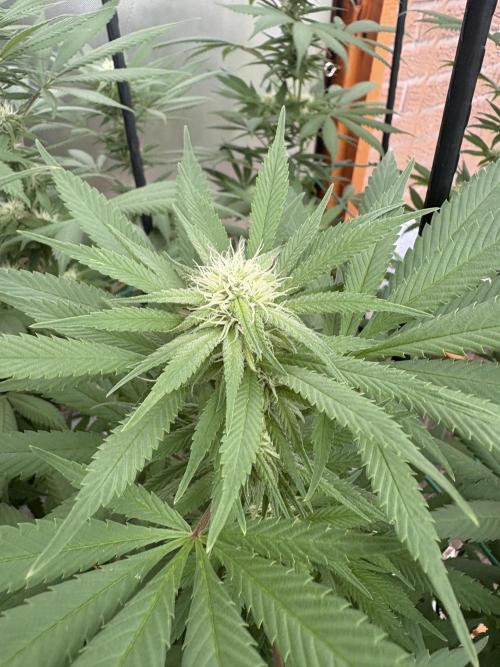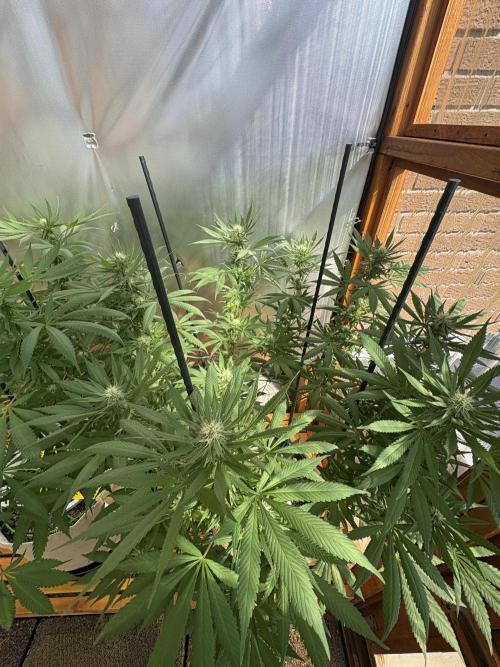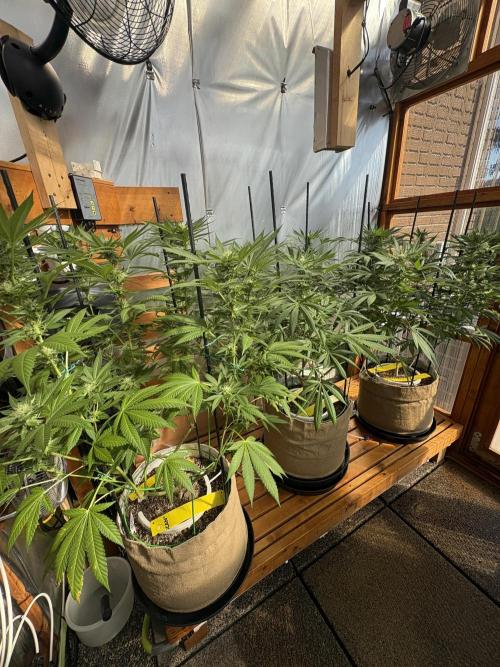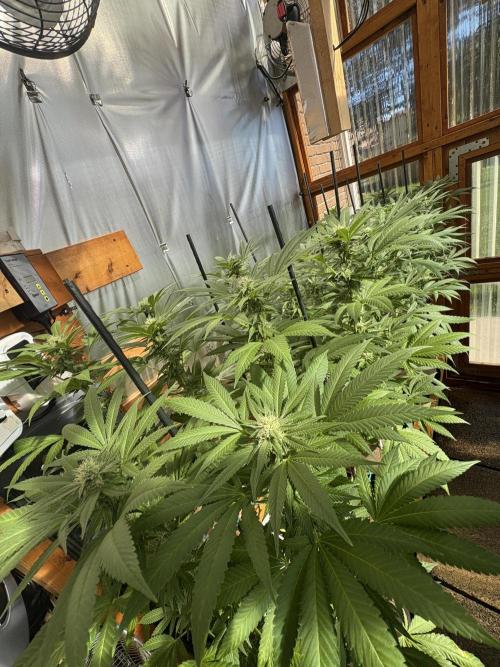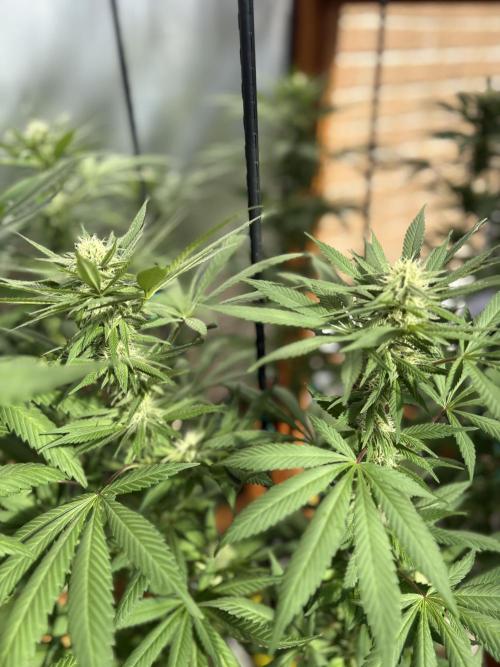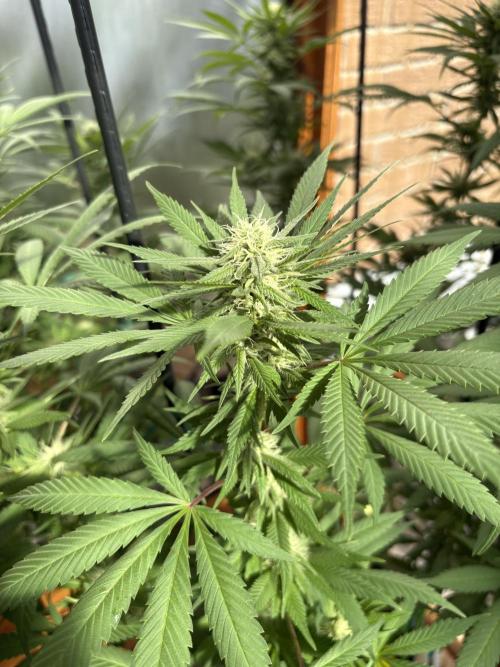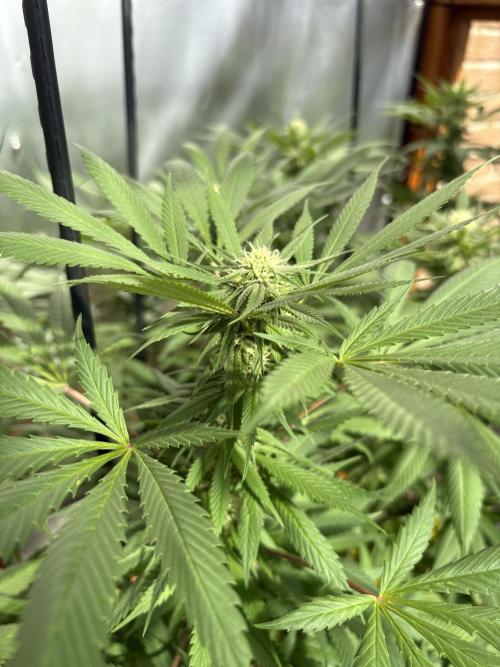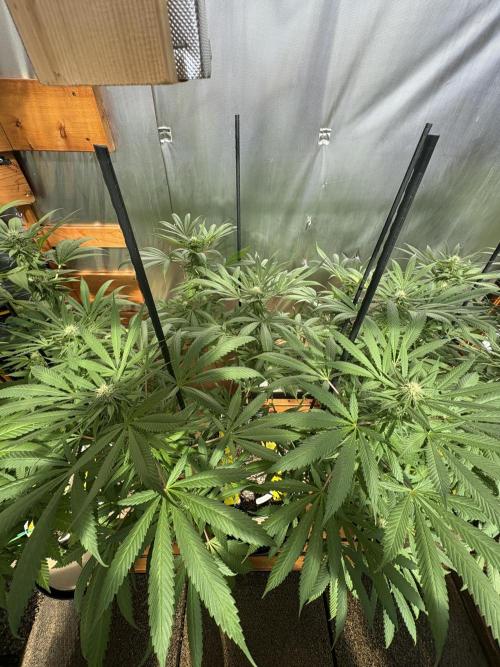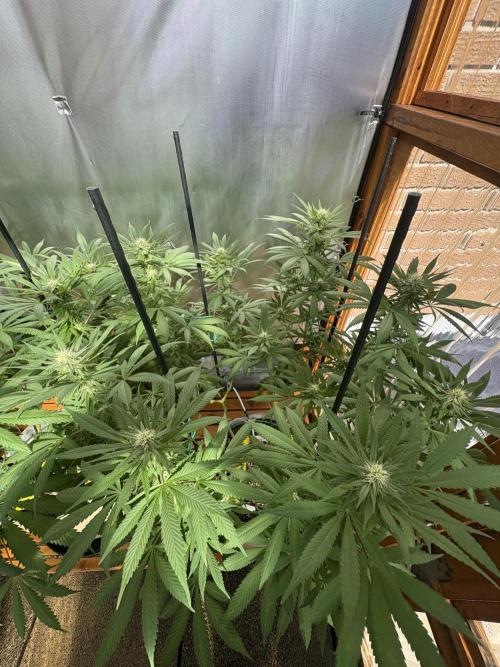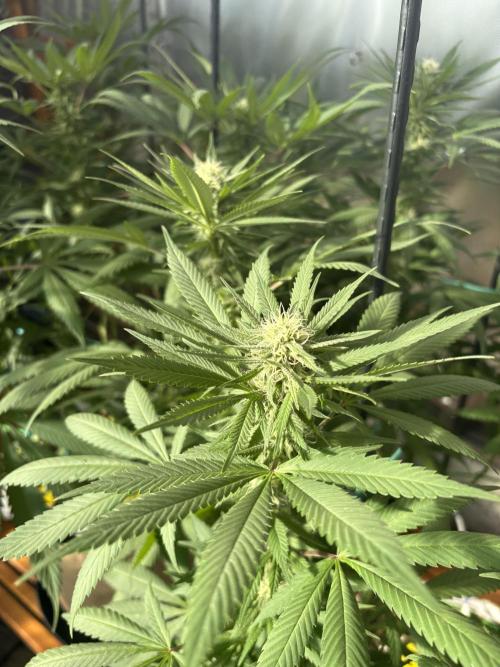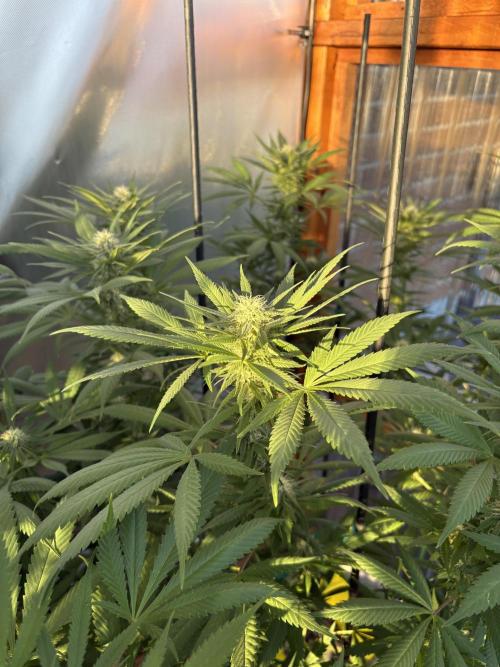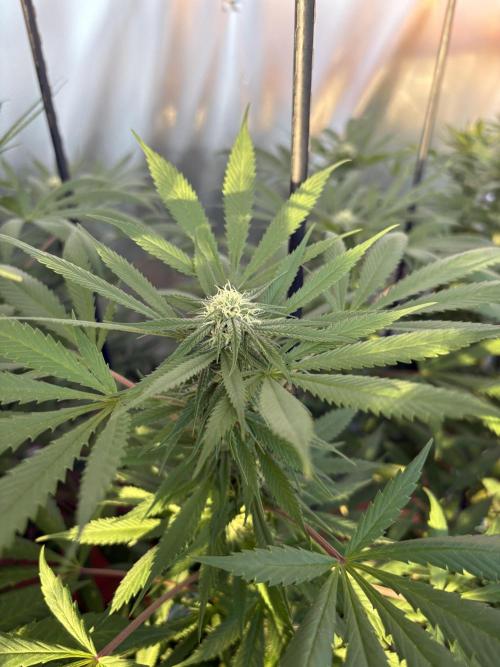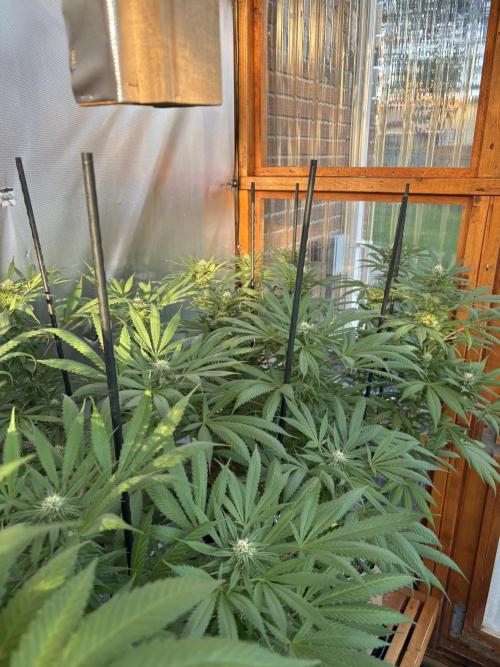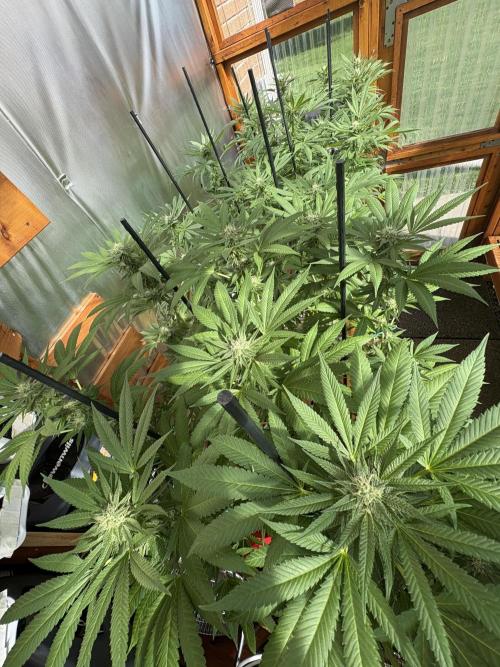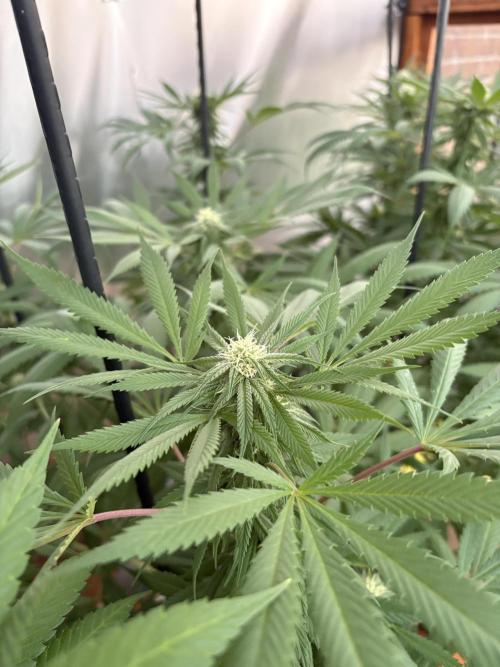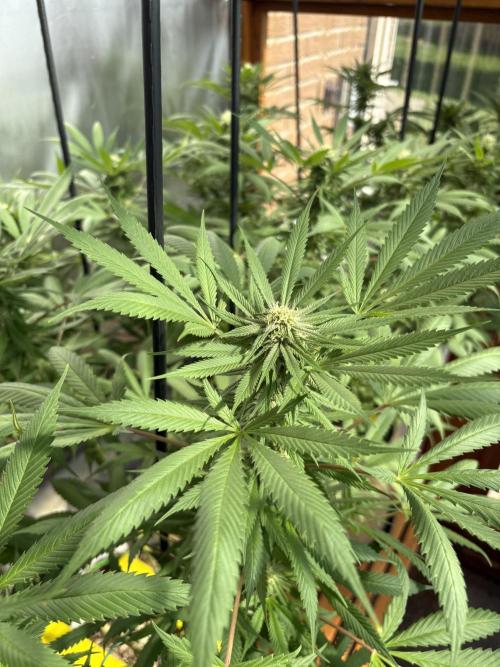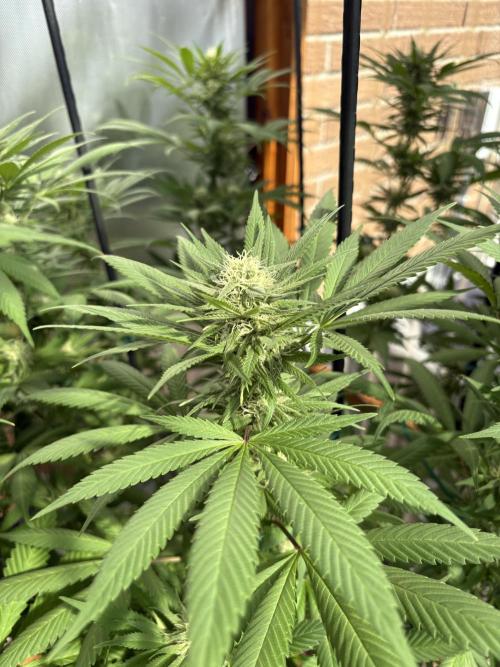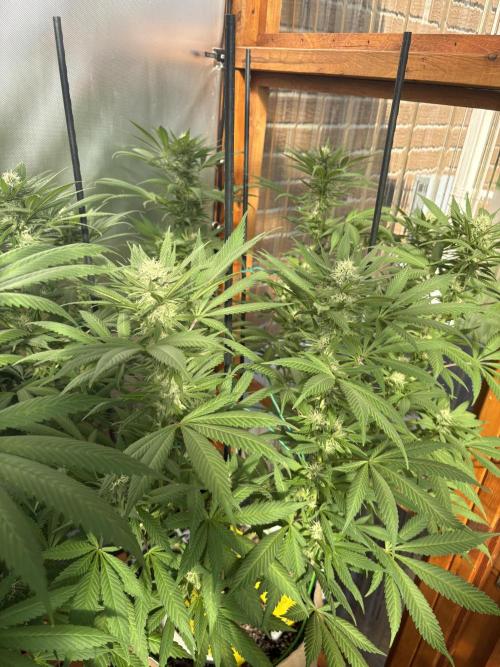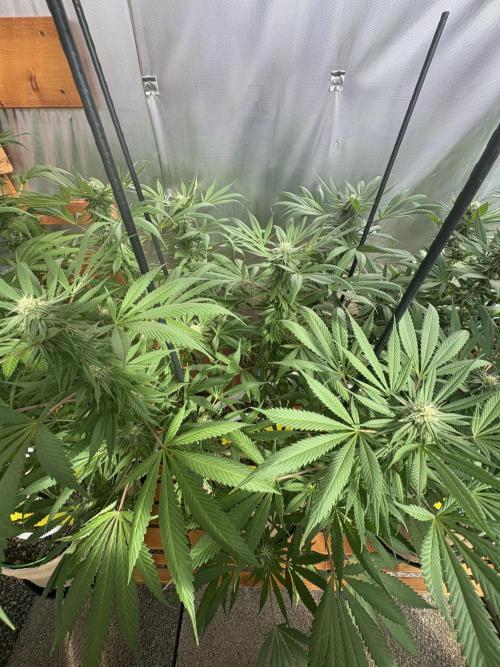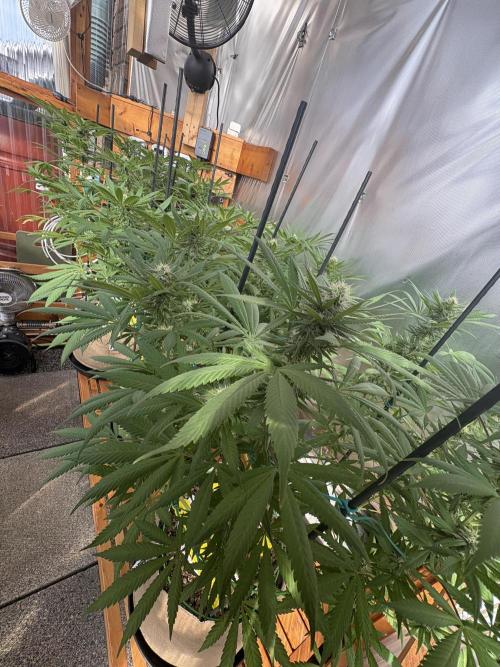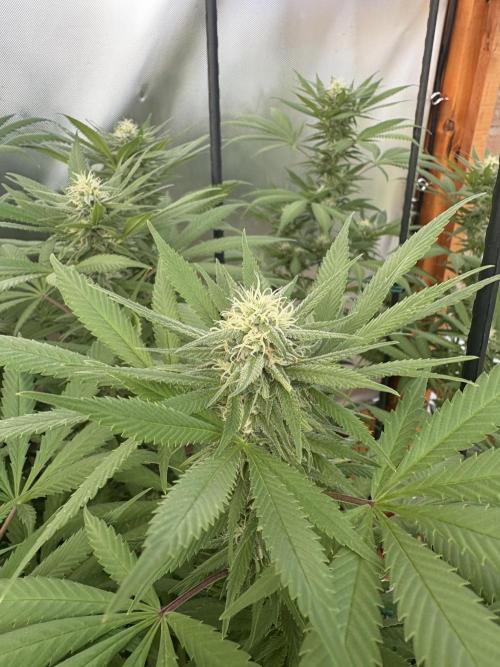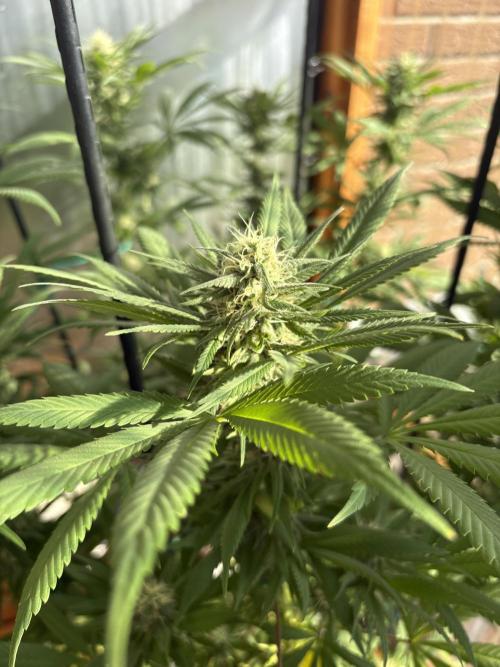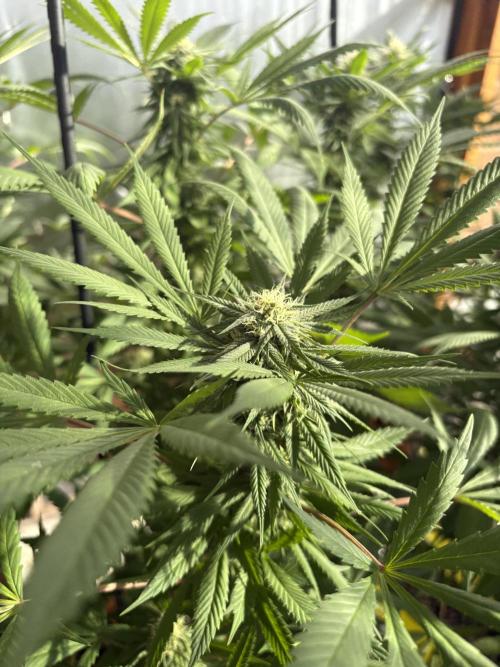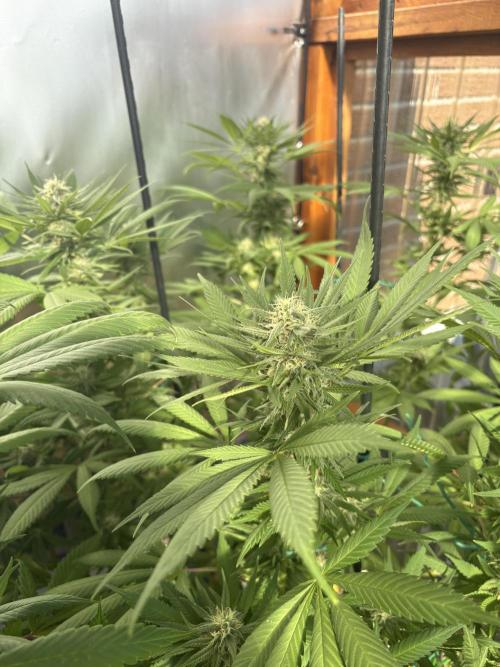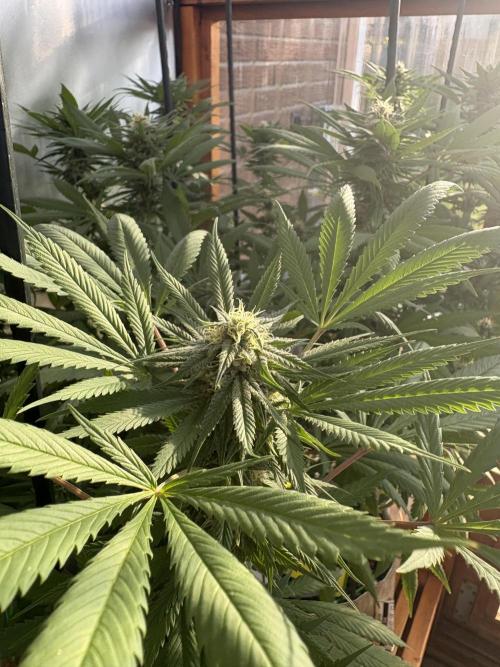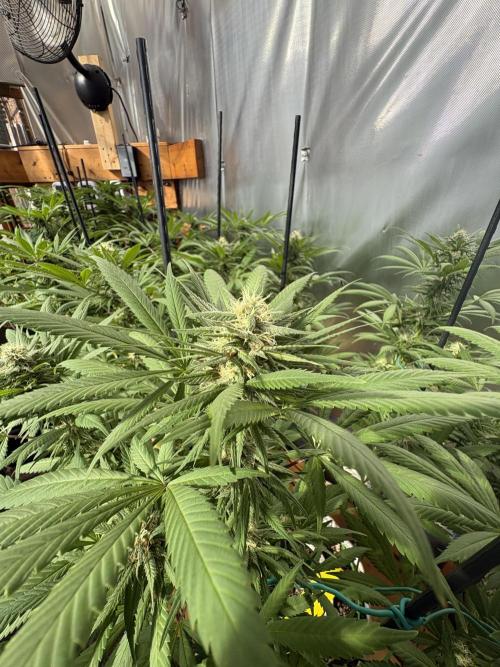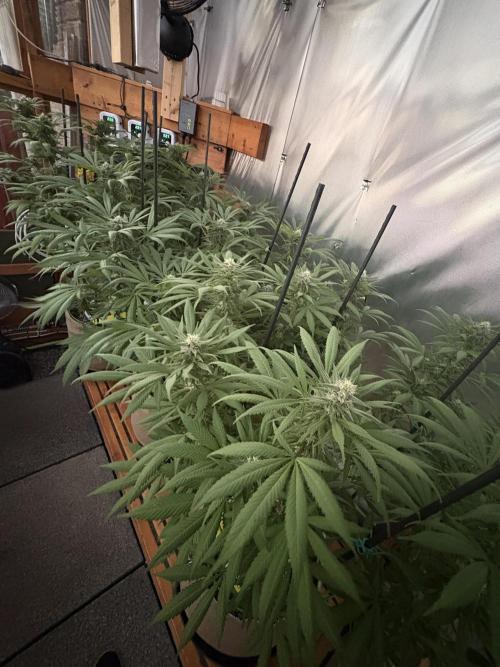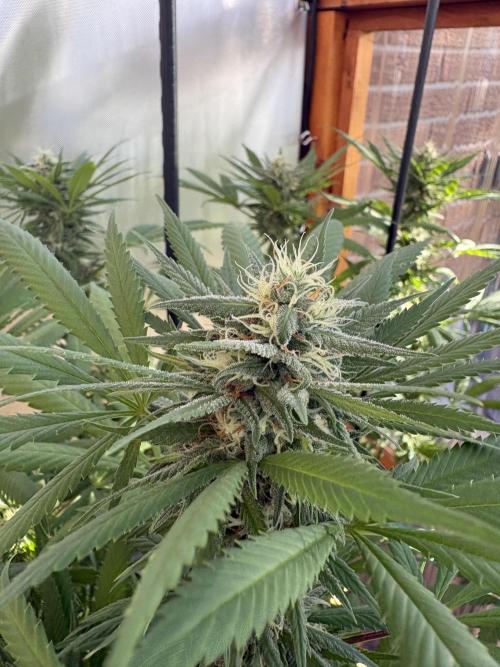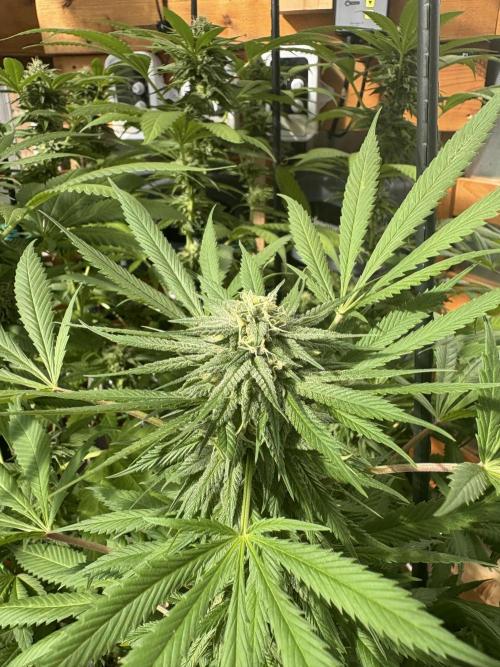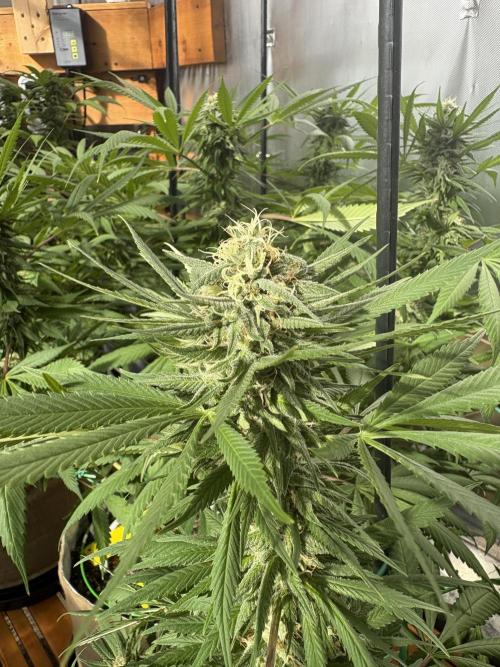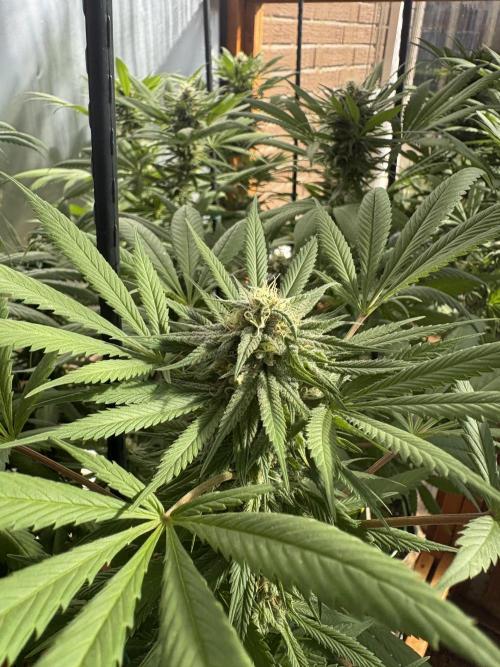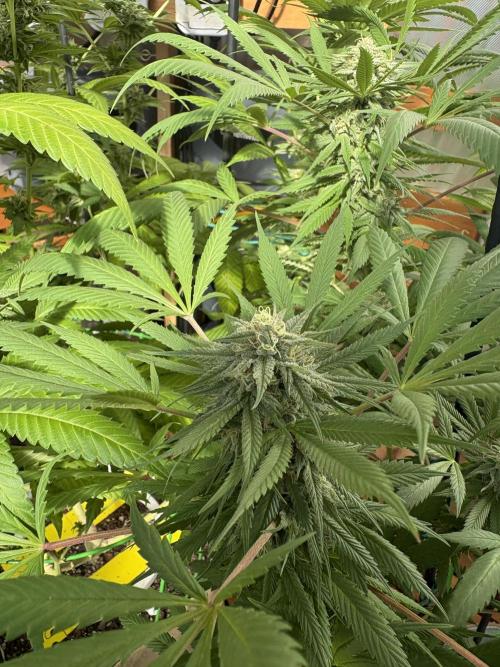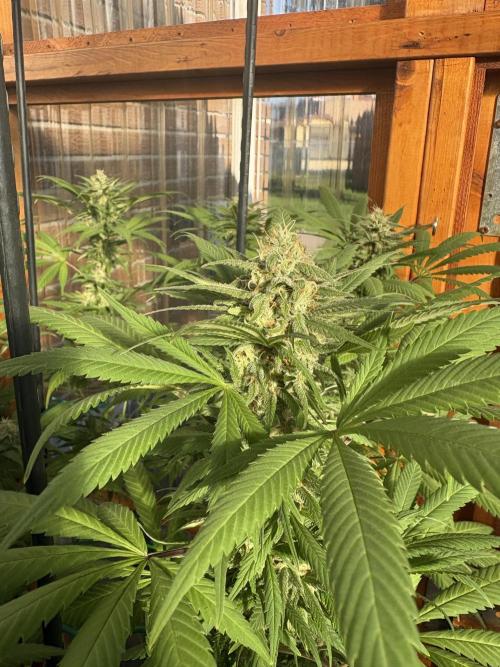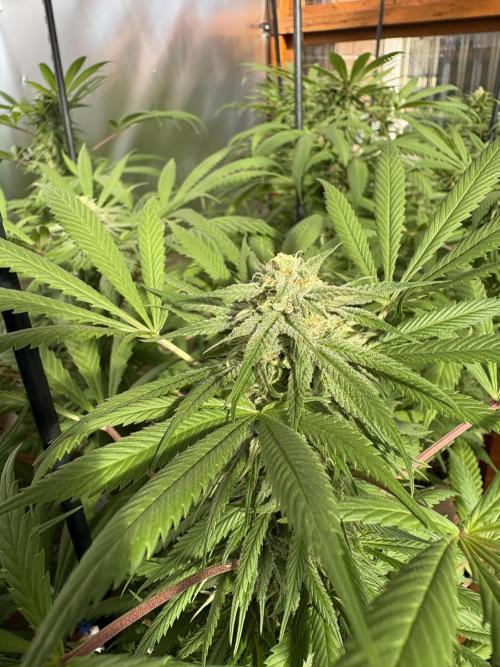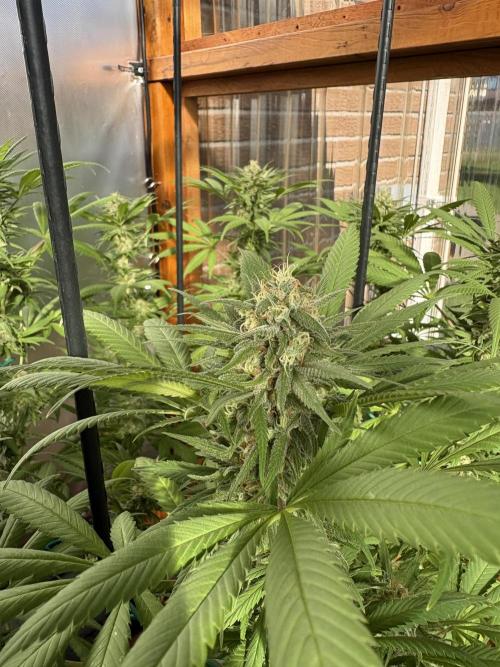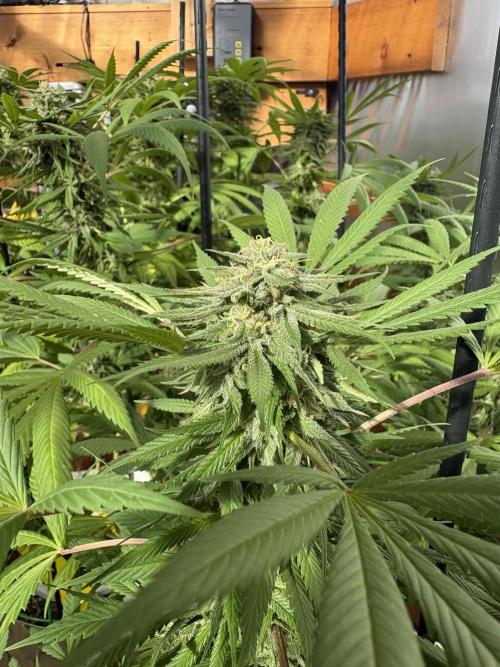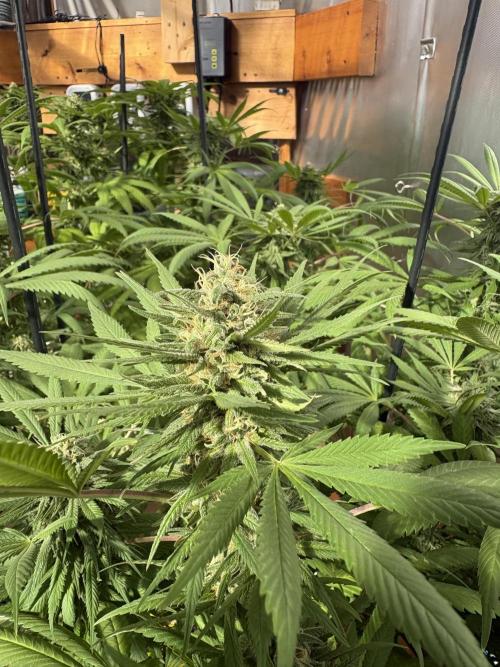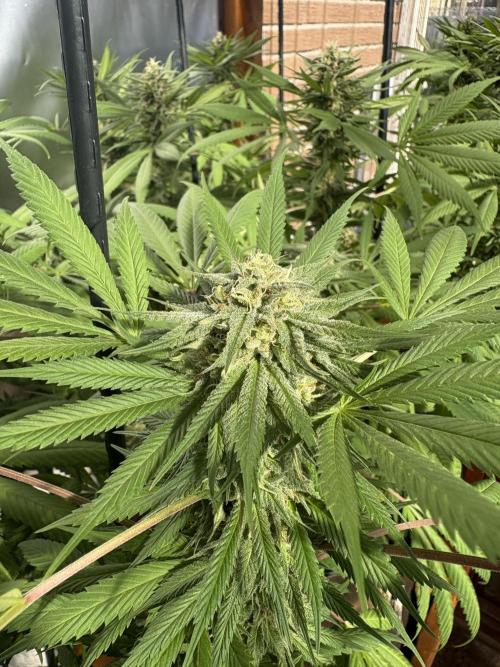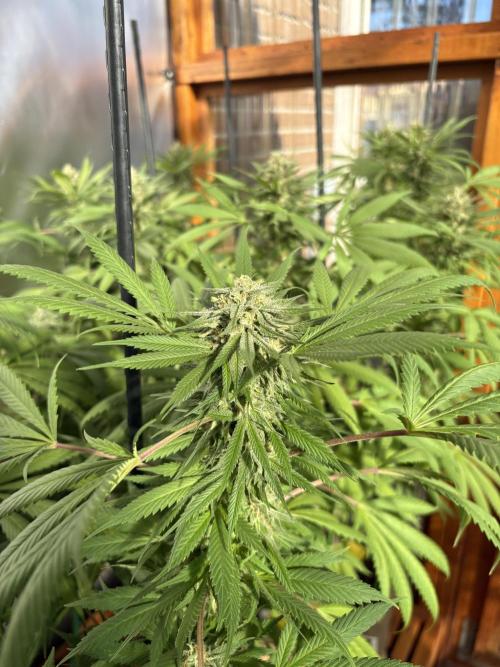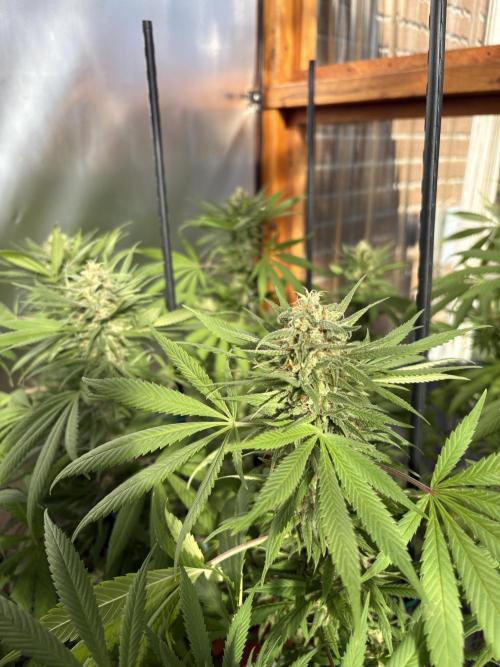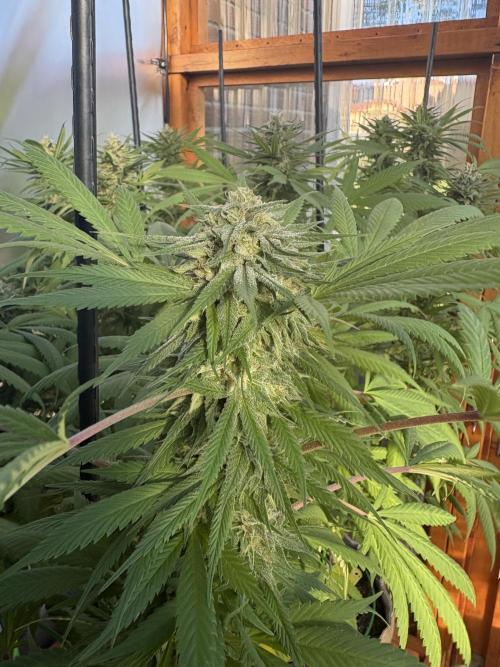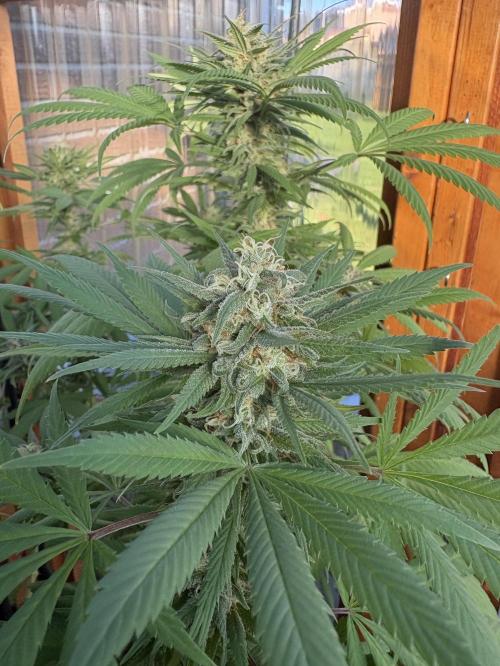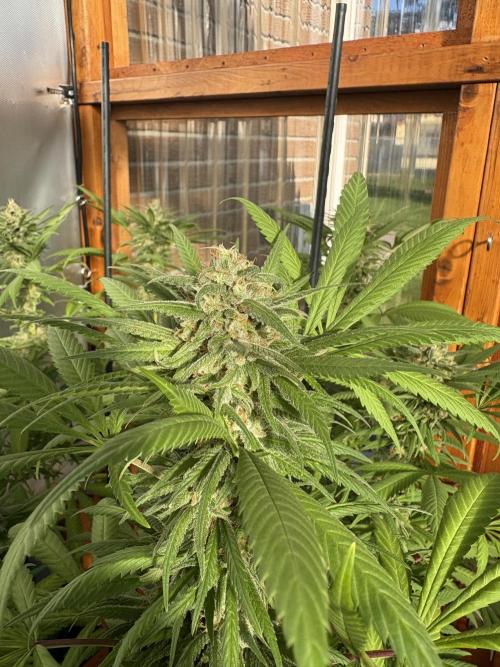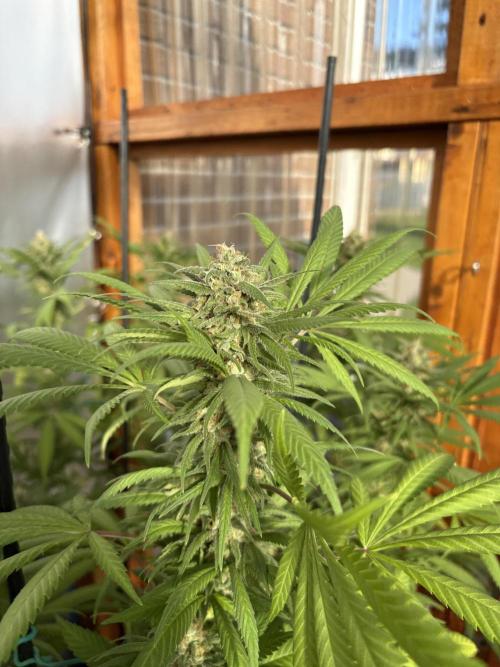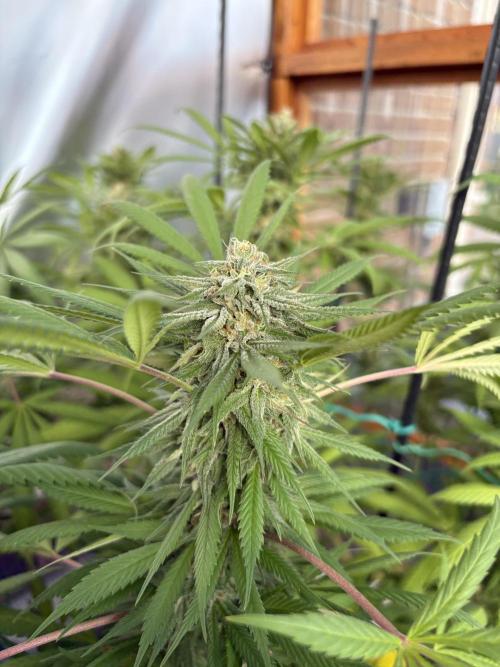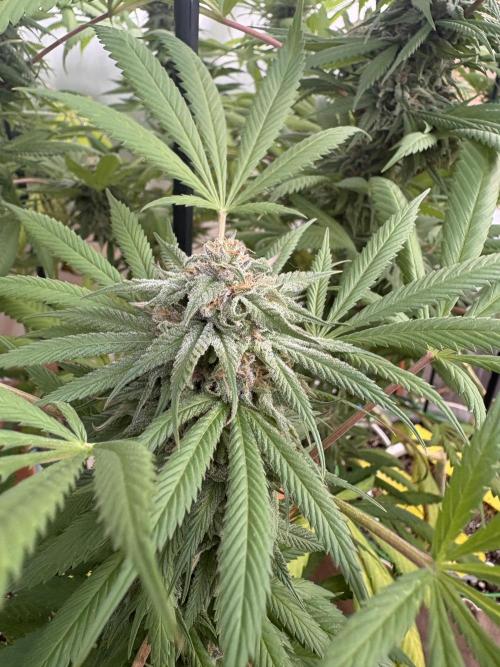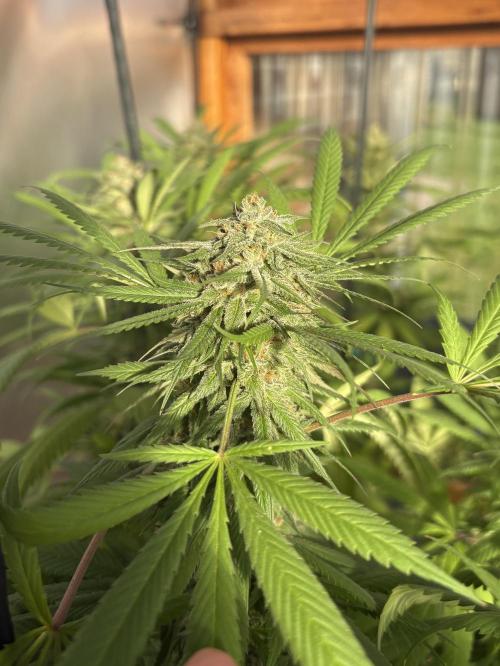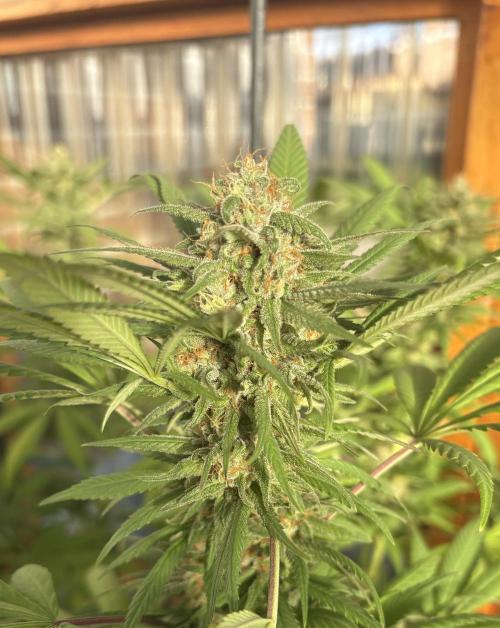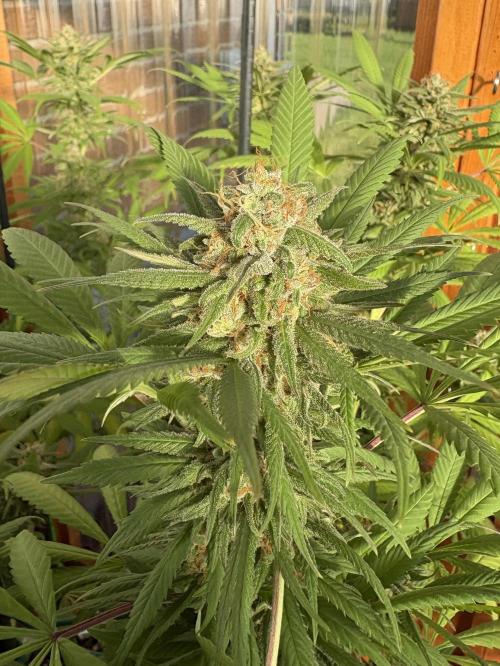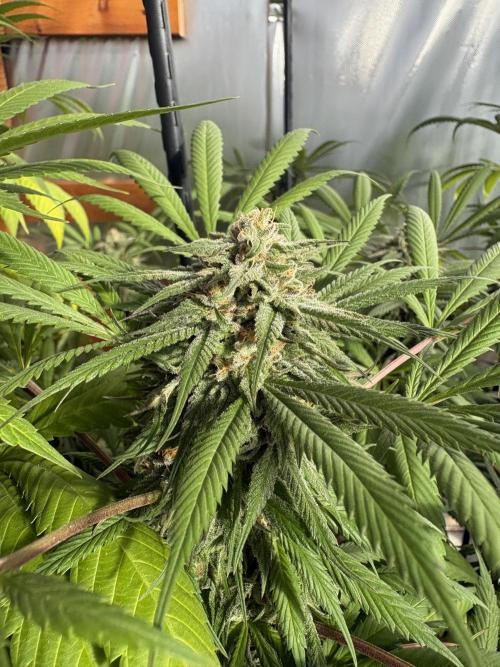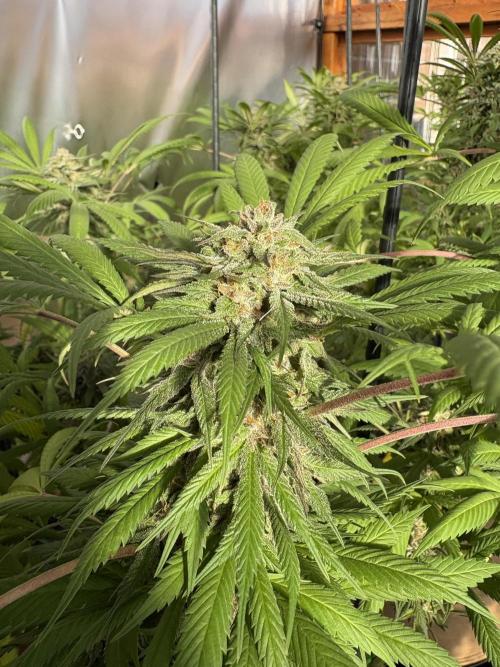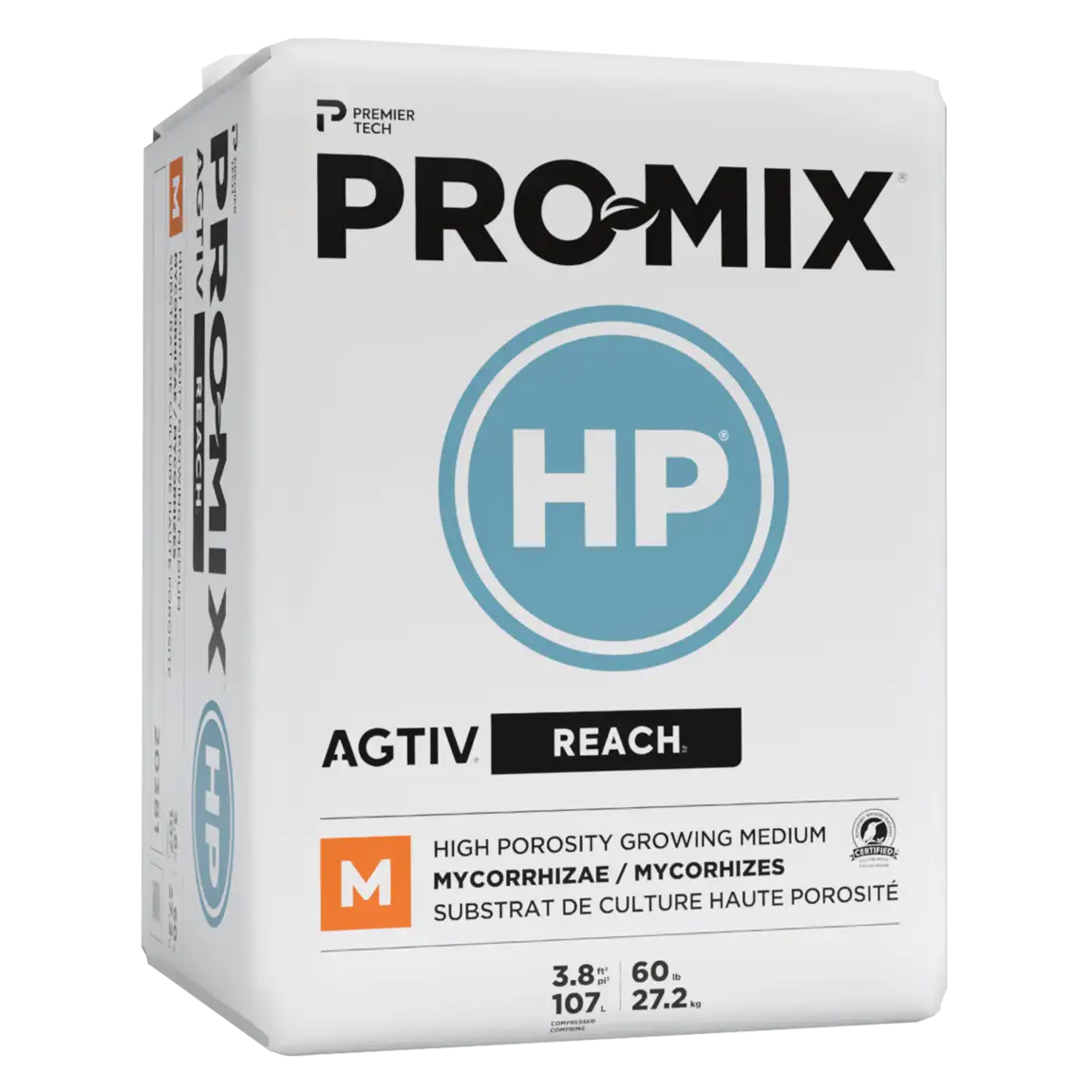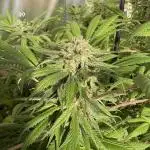The Grow Awards 2026 🏆 











Blue Dynamite (Next Generation Seeds) - Summer 2025

Blue Dynamite
Next Generation Seeds

Contr
Day/Night Temperature Controller W/Smart Differential & Remote Sensor
Plug N Grow

Contr
Day/Night Humidity Controller W/Smart Differential & Display 120V - PNG-030
Plug N Grow

Drip
Timed Demand Pump Drawing from Rain Barrel to Netafim Netbow
Custom Build
Worm Castings Other
Pure Life
Aeration Blend Other
Optimize Organics
Outdoor
Room Type
Defoliation
weeks 4-6, 9-10, 16, 19-21
LST
weeks 5-17
Manifolding
weeks 4, 6, 9
Transplantation
weeks 4, 8
Topping
weeks 4, 6, 9
38 liters
Pot Size
Start at Harvest
G
Germination7mo ago
Nutrients 3
Arbuscular Mycorrhizal Fungi
1.5 mll

All Purpose
2.5 mll

Glacial Rock Dust
1.3 mll
cultivars MAY 6, 2025
GERMINATION STRATEGY
To germinate my seeds, I follow a three-step process: 1) Seed Scarification; 2) Convection Based Lab Paper Germination Method (CannaKan: https://cannakan.com/) and, 3) Germinated Seed Sowing.
To scarify seeds, a process that softens the outer coating of the seed, I create a seed scarification solution by combining 50mL of 3% Hydrogen Peroxide (typical household H2O2) with 100mL of distilled water, then pour in CannaKan, place seeds in CannaKan strainer, then place on heat mat targeting a temperature of 26C. I soak seeds in the solution for no greater than 16 to 20 hours.
Following scarification, I remove all liquid from CannaKan and replace with 8mL of H2O2 and 16mL of distilled water. I then place the CannaKan back on heat mat and monitor for the emergence of a radical.
To undertake Seed Sowing I fill Seedling Pots (1.94L ea.) with moistened living soil and plant seeds that have an emerged radical that is approximately 6mm to 12mm in length (¼”- ½”). I utilize a custom blended living soil by preparing a mix of peat with aeration and organics as per ratios described on the Media and Containers, and the Fertigation Strategy for Dry Organic Amendments images posted to the gallery of this diary entry. To complete the living soil preparation, I set the filled containers in the propagation garden (no lights, all other systems on), inoculate each with a Soil Drench that includes Activated Beneficial Microbes (ABM) and let sit for a minimum of 5 days prior to Seed Sowing, so as to allow the biology to develop within the growing media. To sow the germinated seeds, I create a small hole in the substrate, about 6mm to 12mm (¼”- ½”) deep in the soil surface, dust the hole thoroughly with up to 3mL of Mycorrhizal Innoculant (Arbuscular Mycorrhizal Fungi Blend), then set the seed in the hole, radical pointed downward into the substrate. I cover the seeds loosely with growing media then mist the soil surface with plain distilled water adjusted to a pH of 6.5. Next I place the pots on a heat mat and under a dome, targeting a temperature range of 23C to 25C and humidity levels of 65% to 70%. Once sprouts appear, the dome is removed.
TRANSPLANT AND GROWTH STRATEGY
This crop will undergo two transplants, along with a combination of Low Stress Training (Leaf Tucking, Branch Training, Defoliation) and High Stress Training (Topping, Manifolding, Lolli-Popping and Super Cropping) to maximize the size and canopy of each specimen. Germinated seeds are planted in a 1.94L (~0.5 gallon) plastic pot and grow through seedling stage and into early vegetative stage, in an indoor environment under an LED Light Fixture. When ready (between days 29 and 35), specimens will be transplanted to an 11.3L fabric Transition Pot (~3 gallon) and once recovered (5 to 7 days), will be transitioned to the greenhouse setting over a 10-day hardening-off process. Plants will continue to grow through early to mid-vegetative stage and when ready (between days 64 and 70 or no later than approximately 4 weeks from the beginning of flowering), will undergo one more transplant to a fabric 37.7L Final Pot (~10 gallon) where the individuals will complete their life cycle through to harvest.
FERTIGATION STRATEGY
I employ a multi-faceted organic fertigation methodology that leverages only those amendments that comply with Canada’s Organic Production Systems General Principles & Management Standards and Permitted Substances Lists (CAN/CGSB-32.310-2021 CAN/CGSB-32.311-2020). I use dry organic amendments as well as compost and worm castings to amend soil, and supplement at regular intervals throughout the life-cycle with top dressings. Aerated compost teas and liquid amended soil drenches are applied bi-weekly (rotating: one week soil drench, next week compost tea), and I foliar feed through to the beginning of the flowering stage (bi-weekly).
5 likes
1 comment
Share
1
Week 1. Vegetation7mo ago
4.5 cm
Height
16 hrs
Light Schedule
26 °C
Day Air Temp
6.5
pH
25 PPM
TDS
69 %
Air Humidity
18 °C
Solution Temp
18 °C
Substrate Temp
23 °C
Night Air Temp
1.94 liters
Pot Size
0.02 liters
Watering Volume
45 cm
Lamp Distance
cultivars MAY 10 to 16, 2025
Two seeds were sown, one on May 6, one on May 12. Both have emerged from soil and are establishing themselves well enough in their environment. No real issues to report.
Day 1 - MIGRO ARAY 4 set to 45cm (18") above canopy at 40% power to create 180 PPFD and 10.37 DLI
Day 2 - Sprayed soil surface to damp with distilled water
Day 3 - Sprayed soil surface to damp with distilled water
Day 4 - LED Fixture adjusted to 43cm (17") above canopy at 40% power to create 200 PPFD and 12.0 DLI
Day 5 - Sprayed soil surface to damp; 30mL top water, 85mL bottom water with plain water pH'd to 6.5
Day 6 - Sprayed soil surface to damp.
Day 7 - LED Fixture adjusted to 41cm (16") above canopy at 40% power to create 240 PPFD and 13.82 DLI
At end of day 7, garden adjusted to Day Time High of 25C, Night Time Low of 22C, continuous leaf Vapor Pressure Deficit (VPD) of 0.8 kPa
4 likes
comments
Share
2
Week 2. Vegetation6mo ago
9 cm
Height
16 hrs
Light Schedule
25 °C
Day Air Temp
6.5
pH
25 PPM
TDS
58 %
Air Humidity
18 °C
Solution Temp
18 °C
Substrate Temp
22 °C
Night Air Temp
1.94 liters
Pot Size
0.02 liters
Watering Volume
45 cm
Lamp Distance
Nutrients 3
Grow (3-1-2)
2.5 mll
Yucca Schidigera Liquid Extract
0.12 mll
Activated Beneficial Microbes
1.25 mll
cultivars MAY 17 to 23, 2025
Both specimens growing well, without any issues to report. Blue Dynamite #2 is 1 week behind its' sister.
Day 8 - Sprayed soil surface to damp with dechlorinated water pH'd to 6.5. Propagation Garden adjusted to day-time high of 25C and night-time low of 22C. Controller set to maintain continuous VPD of 0.9kPa. LED light fixture set to 40% at 36cm (14.5") above canopy for a PPFD of 240 and a DLI of 13.82.
Day 9 - n/a
Day 10 - Provided a Soil Drench (70mL top water, 70mL bottom water) of Fulvic Acid - 2.5mL/L | North Atlantic Kelp - 0.5mL/L | Yucca - 0.25ml/L | 0.75mL Root Builder | 0.75mL of Activated EM1
Day 11 - LED fixture adjusted to 50% output, raised to 43cm above canopy to produce 270 PPFD with 15.55 DLI
Day 12 - n/a
Day 13 - n/a
Day 14 - Soil Drench (100mL top water, 100mL bottom water) with Liquid Organic Amendments described in Nutrients section of Diary Post
5 likes
2 comments
Share
3
Week 3. Vegetation6mo ago
14 cm
Height
16 hrs
Light Schedule
25 °C
Day Air Temp
6.5
pH
25 PPM
TDS
58 %
Air Humidity
18 °C
Solution Temp
18 °C
Substrate Temp
22 °C
Night Air Temp
1.94 liters
Pot Size
0.06 liters
Watering Volume
45 cm
Lamp Distance
Nutrients 2
Organic CalMag
0.75 mll
Monosilic Acid
0.25 mll
cultivars MAY 24 to 30, 2025
Specimens performing well with no issues to report
Day 15 - LED Fixture adjusted to 37cm (14.5") above canopy to produce 300 PPFD and 17.28DLI
Day 16 - n/a
Day 17 - n/a
Day 18 - 100mL top and bottom water of soil drench containing 0.75mL/L of Organic CalMag and 0.25mL/L of Monosilic Acid; LED fixture raised to 40cm (15.5") above canopy, intensity increased to 60% for 350 PPFD and a DLI of 20.16
Day 19 - n/a
Day 20 - Sprayed soil surface to damp
Day 21 - 150mL top water of plain rainwater, 100mL bottom water of plain rainwater
4 likes
2 comments
Share
4
Week 4. Vegetation6mo ago
14 cm
Height
16 hrs
Light Schedule
25 °C
Day Air Temp
6.5
pH
25 PPM
TDS
58 %
Air Humidity
18 °C
Solution Temp
18 °C
Substrate Temp
22 °C
Night Air Temp
11.3 liters
Pot Size
0.27 liters
Watering Volume
45 cm
Lamp Distance
Nutrients 3
Liquid Grow (3-1-2)
2.5 mll
Yucca Schidigera Liquid Extract
0.12 mll
Activated Effective Microbes (EM1)
2.5 mll
cultivars MAY 31 to JUNE 6
Some signs of deficiencies appearing in both specimens (purpling of petioles, "rusting" leaf margins, paling of leaf colour) indicating that soil in Seedling Pot has been spent of its nutrient. Transplant to Transition Pot should correct the issue.
Day 22 - LED Fixture set to 60% output to produce 350 PPFD and 20.16 DLI.
Day 23 - 150mL top water, 100 mL bottom water with plain rainwater (from rain barrel outdoors)
Day 24 - Blue Dynamite #1 topped to 4th node, defoliated and pruned below 4th node to produce 2 main growth shoots (Blue Dynamite #2 is a week behind and will get topped next week); 150mL top water, 100mL bottom water with plain rainwater; Had planned to increase light intensity, but to avoid stress, going to keep it at 350 PPFD
Day 25 - n/a
Day 26 - 100ml bottom water, 200mL top water with Soil Drench
Day 27 - n/a
Day 28 - Specimens transplanted to 11.3L (3 gallon) Transition Pot (transplant hole dusted with 2.5mL to 5mL of Endomycorrhizal Fungi Innoculant); Watered in with 1.1L of Soil Drench with the following components: Fulvic Acid - 2.5mL/L | North Atlantic Kelp - 0.5mL/L | Pacific Kelp - 0.5mL/L | Yucca - 0.25ml/L | 2.5mL/L Activated Beneficial Microbes
3 likes
comments
Share
Used techniques
Topping
Technique
Manifolding
Technique
Transplantation
Technique
Defoliation
Technique
5
Week 5. Vegetation6mo ago
14 cm
Height
16 hrs
Light Schedule
25 °C
Day Air Temp
6.5
pH
25 PPM
TDS
58 %
Air Humidity
18 °C
Solution Temp
18 °C
Substrate Temp
22 °C
Night Air Temp
11.3 liters
Pot Size
45 cm
Lamp Distance
cultivars JUNE 7 to 13, 2025
Specimens showing signs of deficiency, but have shown modest improvement since the transplant on Day 28. Despite the issues (discolouration of leaves) the plants have recovered from the transplant, new growth appears healthy and specimens produced 3 nodes on the new main growing shoots. Began Hardening off program on Day 35, a couple of days later that originally planned.
Day 29 - LST
Day 30 - Blue Dynamite #2 topped to produce 2 main growing shoots; LED fixture adjusted to 80% output, set to 57cm above canopy to produce 400PPFD and 27.65 DLI
Day 31 - Deficiencies on full display, likely the result of overwatering, pH problems or a combination of both; Allowing plants to dry out then will provide a top dress of worm castings and a strong flood of plain rainwater
Day 32 - n/a
Day 33 - n/a
Day 34 - Foliar feed in effort to help address deficiencies
Day 35 - Began Hardening of Program, with 2 hours of time in the Greenhouse under partial sun (11:30AM EDT to 1:30PM EDT)
3 likes
comments
Share
Used techniques
LST
Technique
Defoliation
Technique
6
Week 6. Vegetation5mo ago
14 cm
Height
16 hrs
Light Schedule
26 °C
Day Air Temp
6.5
pH
Weak
Smell
53 %
Air Humidity
18 °C
Solution Temp
18 °C
Substrate Temp
21 °C
Night Air Temp
11.3 liters
Pot Size
Nutrients 1
Worm Castings
12.5 mll
cultivars JUNE 14 to 20, 2025
Following the transplant, both specimens have recovered from the minor problems in the root zone. The mild top dress with worm castings and thorough watering with plain rainwater seemed to be of benefit.
Hardening off process continued from Day 35 and ended on Day 40. I had planned to go for a longer transition from the indoor garden under LED light to the greenhouse with the full sun exposure, but the plants responded very well and there no need to extend the transition.
This week the plants were topped for a second time (each specimen was pushing out 5th node on each of the 2 main shoots produced from first topping), back to the 3rd node on each of its two main growing shoots. Pruned away all other growing shoots, and selectively defoliated leaving as many leaves as possible to minimize stress but to also allow the plant its retain the natural regulation and energy production from the fan leaves.
DAY 36 - Top dressed with 125mL of worm castings, scratched into soil surface of each specimen, and top watered with 750mL of plain rainwater, and bottom watered with 750mL of plain rainwater. 3 hours in greenhouse as part of hardening off program, from 10:30AM to 1:30PM; Mild LST
DAY 37 - 4 hours in greenhouse as part of hardening off program, from 9:30AM to 1:30PM; Mild LST
DAY 38 - 6 hours in greenhouse as part of hardening off program, from 9:30AM to 3:30PM; Mild LST
DAY 39 - 9 hours in greenhouse as part of hardening off program, from 8:00AM to 5:00PM; Mild LST
DAY 40 - In greenhouse at 8:00AM and remained there overnight, and for remainder of lifespan; Mild LST
DAY 41 - Prepared Compost Tea and set to aerate for next 36 hours before application in morning of Day 43; Mild LST
DAY 42 - Topped specimens for a 2nd time to produce 4 main growing shoots as part of the mainlining/manifolding program; Pruned, defoliated and low stress training applied.
4 likes
comments
Share
Used techniques
Topping
Technique
LST
Technique
Manifolding
Technique
Defoliation
Technique
7
Week 7. Vegetation5mo ago
16 cm
Height
16 hrs
Light Schedule
26 °C
Day Air Temp
6.5
pH
Weak
Smell
53 %
Air Humidity
18 °C
Solution Temp
18 °C
Substrate Temp
21 °C
Night Air Temp
11.3 liters
Pot Size
Nutrients 7
Worm Castings
60 mll
Microbe Multiplier
4 mll
Wild Fish Hydrolysate
1 mll
cultivars JUNE 21 to JUNE 27, 2025
Both specimens growing with vigour. Blue Dynamite #1 is a little more compact of a phenotype, and has a blueish tinge on the underside of older fan leaves (uncertain if this was the result of prior week's deficiencies or if it is a genetic trait). Blue Dynamite #2 is more stretched out specimen. No issues to report
DAY 43 - Applied 1.2L of Aerated Compost Tea as per recipe described above in diary entry
DAY 44 - Mild low stress training to keep specimens flat.
DAY 45 - Mild low stress training
DAY 46 - Mild low stress training
DAY 47 - Applied plain rainwater 500mL to each specimen
DAY 48 - Mild low stress training
DAY 49 - Mild low stress training
3 likes
comments
Share
Used techniques
LST
Technique
8
Week 8. Vegetation5mo ago
21 cm
Height
16 hrs
Light Schedule
27 °C
Day Air Temp
6.5
pH
Weak
Smell
53 %
Air Humidity
18 °C
Solution Temp
18 °C
Substrate Temp
21 °C
Night Air Temp
38 liters
Pot Size
Nutrients 4
GROW Liquid Organic Plant Food (3-1-2)
3.75 mll
Yucca Schidigera Liquid Extract
0.19 mll
Monosilic Acid
0.38 mll
cultivars JUNE 28 to JULY 4, 2025
Each specimen growing with vigour. Continued Low Stress Training (LST) through the week. No deficiencies, foliar pests or soil dwelling pests. Blue Dynamite #1 is more compact than #2, and has purpling of petioles as the plant grows (believe it to be genetic trait). Blue Dynamite #2 is the larger of the two plants, and much stretchier (lengthy inter-nodal spacing). Each with lush green colour in their leaves, and thick rigid stems right to the tips. On transplant, it appeared that each had root balls that filled out the 11.3L pot.
DAY 50 - n/a.
DAY 51 - 1.25L Liquid Amended Soil Drench at 07:30, then departed for a fishing/canoeing trip.
DAY 52 - n/a; gone fishing.
DAY 53 - n/a; gone fishing.
DAY 54 - n/a; returned from fishing in the afternoon.
DAY 55 - Top watered in 1.0L of plain rainwater, and bottom watered 250mL at 07:00
DAY 56 - All specimens transplanted to 38L (10G) Grassroots Living Soil Fabric Pot (lined fabric pot - https://www.optimizeorganics.ca/collections/pots-trays/products/grassroots-living-soil-pots?variant=45365343256864); 2L of Transplant Formula (Fulvic Acid - 2.5mL/L | North Atlantic Kelp - 0.5mL/L | Pacific Kelp - 0.5mL/L | Yucca - 0.25ml/L | Activated Beneficial Microbes - 2.5mL/L) applied to each specimen.
4 likes
comments
Share
Used techniques
LST
Technique
Transplantation
Technique
9
Week 9. Vegetation5mo ago
23 cm
Height
16 hrs
Light Schedule
27 °C
Day Air Temp
6.5
pH
Weak
Smell
53 %
Air Humidity
18 °C
Solution Temp
18 °C
Substrate Temp
21 °C
Night Air Temp
38 liters
Pot Size
cultivars JULY 5, to JULY 11, 2025
Both specimens continue to grow well and without any issues to report. Each specimen topped for the final time to produce 8 main growing shoots along the manifold. From here on out the manipulation of the plants will be minimal, and focussed on LST to shape and control height as required.
Day 57 - Minor Low Stress Training (LST)
Day 58 - 1L bottom water of plain rainwater and some minor LST
Day 59 - Minor LST
Day 60 - Minor LST
Day 61 - Each specimen topped at each of the 4 main growing shoots back to the 3rd node to produce 8 main growing shoots. Pruned away all growing shoots below the mains (won't be keeping clones of this one this year, as it is a tester and I have 5 more seeds for a phenotype hunt).
Day 62 - Prepared Compost Tea in the evening, to be applied on Day 64 in the morning (roughly 36 hours of brew time).
Day 63 - Minor LST
6 likes
2 comments
Share
Used techniques
LST
Technique
Topping
Technique
Manifolding
Technique
Defoliation
Technique
10
Week 10. Vegetation5mo ago
26 cm
Height
16 hrs
Light Schedule
27 °C
Day Air Temp
6.5
pH
Normal
Smell
53 %
Air Humidity
18 °C
Solution Temp
18 °C
Substrate Temp
21 °C
Night Air Temp
38 liters
Pot Size
Nutrients 7
Worm Castings (2-0-0)
60 mll
Microbe Multiplier
4 mll
Humic Acid
0.5 mll
cultivars JULY 12 to 18, 2025
Both specimens are growing very well. Structurally, both are very similar, however Blue Dynamite #1 has more prominent purpling along the stem and the petioles. Blue Dynamite #2 is the larger of the two specimens, with greater distance in its inter-nodal spacing.
Provided a thorough watering with Aerated Compost Tea and some additional rainwater on Day 64, and by Day 70 substrate still measuring sufficient moisture. Taking care to not over-water, so as to mitigate the proliferation of soil dwelling pests, particularly fungus gnats. Thus far, no pests in soil or on foliage. Blue Dynamite #1 is fairly strong smelling when brushed up against, or when manipulating with Low Stress Training (LST). Grapefruit is the most dominant scent.
DAY 64 - Provided by hand-watering, 2.8L of Aerated Compost Tea (recipe comprised of additives noted above, with Activated Beneficial Microbes and Yucca added after the 36 hour brew cycle), and another 500mL top water and 500mL bottom water of plain rainwater. 2 hours later, turned on dripper system and provided another 1L of plain rainwater to ensure substrate well moistened from top to bottom. 4.5L total for each specimen in its 38L pot.
DAY 65 - Sunny beautiful day, temperatures a little high, but plants responded wonderfully to the compost tea application and the thorough watering from the day prior.
DAY 66 - Another sunny beautiful day, with temperatures creeping a little high (peak of 34C in greenhouse during the afternoon), but again, plants responded with some thick growth.
DAY 67 - Heavy rain in the morning, cloudy and cool most of the day.
DAY 68 - Cloudy day, temperatures mild. No pest presence in soil or on foliage; Soil Pest Defence application not required.
DAY 69 - Sunny, warm day. Greenhouse operated within all thresholds (temperature and humidity). Soil moisture of all pots between 5 and 9 from mid substrate depth to full depth; Debating whether to apply plain rainwater or an amended Soil Drench on Day 71/Day 72. New mains are of the size to be trained, and so continued application of LST to keep the plants flat for a while longer (5 to 7 more days), and to direct the main shoots to the area I want them to grow up from. Undertook some mild defoliation to open up the lower part of the plants.
DAY 70 - Mix of sun and cloud in the morning, mostly cloudy and light rain by late afternoon (16:00).
5 likes
comments
Share
Used techniques
LST
Technique
Defoliation
Technique
11
Week 11. Vegetation4mo ago
26 cm
Height
16 hrs
Light Schedule
27 °C
Day Air Temp
6.5
pH
Normal
Smell
53 %
Air Humidity
18 °C
Solution Temp
18 °C
Substrate Temp
21 °C
Night Air Temp
38 liters
Pot Size
Nutrients 5
Liquid Organic Grow (3-1-2)
3.75 mll
Liquid Organic Bloom (1-3-3)
1.25 mll
Yucca Extract
0.25 mll
cultivars JULY 19 to 25, 2025
Specimens growing well, and are healthy. Blue Dynamite #1 smells strongly of Grapefruit when being manipulated with Low Stress Training (LST). Blue Dynamite #2 doesn't smell as strong, but still putting off a Grapefruit scent. Received an liquid organic amended Soil Drench containing some of the bloom solution (75/25 Veg/Bloom) as it is getting close to the time where the transition to bloom will occur and I wanted to be certain there was a boost of phosphorus available. No signs of fertigation burn, pests (soil or foliar) or any other problems.
Day 71 - Soil moisture in all pots adequate, no need to feed/water.
Day 72 - No foliar pests, so Foliar Pest Defense not required. Sunny and hot today, greenhouse cresting 30C by mid-afternoon, at the upper side of thresholds; Following soil moisture tests, all pots were low moisture in the first third of substrate depth, and found that almost all had dry spots at greater than 50% depth of the substrate; At 20:00 applied 2L each of liquid amended Soil Drench (75:25 Grow to Bloom mix to give the plants a little phosphorus boost)
Day 73 - Sunny, warm day, temperatures ideal. Checked soil moisture in the morning, and all pots were at good moisture throughout substrate (a little drier near the bottom depths). Applied some LST in the evening to direct the shoots to the areas I'd prefer them to grow up from.
Day 74 - Mostly cloudy day, but some moments of sunshine; Rained in the evening, and humidity spiked with the greenhouse reading 65% at 9:00PM; Measured soil moisture, all pots in moisture range, the smaller plants.
Day 75 - Cloudy, rainy day; Humidity high (80% @ 20:30); All specimens are healthy and growing, but would certainly benefit from some sustained periods of sunshine and favourable weather over several days at this stage in their growth (trying to bulk up prior to flowering commencing); Some minor LST to get shoots to better position, but it will be time soon to let them grow upward
Day 76 - Sunny and hot day, with plants responding well; 1L bottom water with plain rainwater at 19:30; Prepared Compost Tea and began brewing for application in 36 hours
Day 77 - Drip watered 500mL of plain rainwater to ensure plants are well hydrated for another sunny hot day.
3 likes
comments
Share
Used techniques
LST
Technique
12
Week 12. Vegetation4mo ago
40 cm
Height
16 hrs
Light Schedule
27 °C
Day Air Temp
6.5
pH
Normal
Smell
53 %
Air Humidity
18 °C
Solution Temp
18 °C
Substrate Temp
21 °C
Night Air Temp
38 liters
Pot Size
Nutrients 3
Veg Grow (5-3-5)
75 mll
Flower Bloom (2-7-5)
75 mll
Worm Castings (2-0-0)
300 mll
cultivars JULY 26 to AUGUST 1, 2025
Specimens growing very well. Manifolding technique producing desired results, with 8 strong main shoots from each specimen that are well spaced out to allow for good air flow and to mitigate pest and disease. No pests present in soil or on foliage. Plants getting closer to beginning their stretch, and after loosening the tie downs, have gained some height and girth. Top dressed this week with 50/50 Veg/Bloom Dry Organic Amendments, along with Worm Castings. Watered in with Compost Tea.
Day 78 - Top dressed with dry organic amendments (50/50 veg/flower) and worm castings; Watered in with 2L of Compost Tea (except Lemon Orange #1 that got 1L). 1L bottom water of plain rainwater. Sunny hot day, clouding over in the evening with a thunderstorm. Mostly cloudy thereafter.
Day 79 - Day started sunny, hot and humid. By early afternoon a thunderstorm rolled in, and clouds lingered until 15:00; Mostly sunny through to sunset; Minor LST of plants to get them in best position for the stretch. Plants are sizeable, approaching top rung of tomato cages; At this point I have no reason to question that they will be of similar size to the plants from last season, capable of producing similar yields.
Day 80 - Sunny warm day outdoors, perhaps a little on the hot side inside the confines of the greenhouse; Plants responded well, and are growing vigourously. Indoors, clones seem fine; I mist the inside of the dome 3 or 4 times per day to keep humidity levels spiked.
Day 81 - Another sunny and warm day outdoors, with periodic cloudy breaks to keep temperatures well below high heat tolerances. All plants have shown good growth, thick and compact for its genotype. Soil moisture measures adequate for all, some showing dry spots near the top and bottom, with moisture within ranges through the middle of substrate. Good for another day, at which time will undertake another assessment to determine whether or not to provide a drip of 500mL or more of plain rainwater (note Liquid Amended Soil Drench scheduled for Day 85 or 86);
Day 82 - n/a
Day 83 - n/a
Day 84 - 750mL drip water to back row (Blue Dynamite #1 & #2, Lemon Orange #2); Mostly sunny and hot day, however there was a haze in the sky from wildfire smoke.
AERATED COMPOST TEA RECIPE (ml/L)
Worm Castings - 60mL
Microbe Multiplier - 4mL
Humic Acid - 0.5mL
Wild Fish Hydrolysate - 1.0mL
Unsulphured Sugarcane Molasses - 0.3mL
Yucca Extract - 0.25mL
Aerated for 36 hours, Yucca added following brew, and pH'd to 6.5
5 likes
comments
Share
Used techniques
LST
Technique
13
Week 13. Vegetation4mo ago
50 cm
Height
16 hrs
Light Schedule
27 °C
Day Air Temp
6.5
pH
Normal
Smell
53 %
Air Humidity
18 °C
Solution Temp
18 °C
Substrate Temp
21 °C
Night Air Temp
38 liters
Pot Size
Nutrients 5
Veg Grow Liquid Amendment (3-1-2)
1.25 mll
Bloom Liquid Amendment (1-3-3)
3.75 mll
Yucca Extract
0.25 mll
cultivars AUGUST 2 to AUGUST 8, 2025
Blue Dynamite specimens growing well, and appear to be transitioning into bloom with some vigourous upward growth over the course of the week. At the beginning of the week the plants were provided an organic liquid amended soil drench (25/75 Veg/Bloom) and drip watered plain rainwater twice during the week. Mild defoliation undertaken to open things up a bit and allow for good air-flow. Minor LST also undertaken to direct growing shoots to optimal areas and to create an even and well spaced canopy.
Not much in the way of smell as of yet, but when manipulated a strong scent of grapefruit is evident with both specimens.
DAY 85
1L bottom water plain rainwater; 2L top water Liquid Amended Soil Drench.
DAY 86
Sunny day, temperatures high but not too high.
DAY 87
Mostly sunny and warm day; plants enjoying the weather.
DAY 88
Sunny warm day, greenhouse temperatures and humidity near optimum throughout the day; Plants growing well, however fan leaves aren't as large on all specimens, as I would expect them to be at this stage. Thinking it is because they are 2 weeks younger than last year's crop, or perhaps they could use more frequent watering. Tested soil and each specimen received 1L of plain rainwater via drip system in the evening (20:00). Will check again in the morning and decided whether or not to give them more.
DAY 89
Mix of sun and cloud, temperatures cool, but within range in greenhouse.
DAY 90
Sunny, hot and humid day; Greenhouse remained within tolerable thresholds; Drip watered 1L of plain rainwater in the morning (07:30). Prepared Compost Tea to be applied on Day 92.
DAY 91
Sunny hot and humid day again. Greenhouse remained within tolerances. Plants responded well over the week, and I believe they have begun the transition to flowering as they have begun their upward stretch.
3 likes
comments
Share
Used techniques
LST
Technique
14
Week 14. Vegetation4mo ago
57 cm
Height
14 hrs
Light Schedule
27 °C
Day Air Temp
6.5
pH
Normal
Smell
53 %
Air Humidity
18 °C
Solution Temp
18 °C
Substrate Temp
21 °C
Night Air Temp
38 liters
Pot Size
Nutrients 6
Worm Castings
60 mll
Microbe Multiplier
4 mll
Humic Acid
0.5 mll
cultivars AUGUST 9 to AUGUST 15
Specimens performing well, and appear to be starting to stretch as they transition to bloom. Blue Dynamite #1 continues to show purpling in the petioles of leaves, and some purple striping on stems. I believe it to be a genetic trait.
DAY 92 - 07:00 - 1L bottom water of rainwater; 2L of compost tea (hand applied and prepared as per recipe of ingredients listed above in diary); Blue Dynamite #2 was given an additional 750mL of plain rainwater via drip to fully saturate substrate.
DAY 93 - n/a
DAY 94 - Mostly sunny day, so temperatures remained quite good in the greenhouse. Humidity a bit high at night, but not a concern at this point. Will have to monitor foliage closely, as the higher humidity and general overnight warmth, may attract pests (i.e. spider mites).
DAY 95 - n/a
DAY 96 - n/a
DAY 97 - 1L drip water of plain rainwater
DAY 98 - 500mL drip water of plain rainwater
4 likes
comments
Share
Used techniques
LST
Technique
15
Week 15. Flowering3mo ago
57 cm
Height
16 hrs
Light Schedule
27 °C
Day Air Temp
6.5
pH
Normal
Smell
53 %
Air Humidity
18 °C
Solution Temp
18 °C
Substrate Temp
21 °C
Night Air Temp
38 liters
Pot Size
Nutrients 3
Flower Bloom (2-7-5)
4 mll
Worm Castings
8 mll

Glacial Rock Dust
3.5 mll
cultivars AUGUST 16 to AUGUST 22, 2025
Insofar as fertigation, this week each specimen was provided a Top Dress of Dry Organic Amendments as described in the Nutrients section of this diary post. The top dress was watered in with a Liquid Amended Soil Drench with the following ingredients and measures (mL/L):
Bloom Liquid Plant Food (1-3-3) - 5.0mL/L of plain rainwater
Yucca Schidigera Liquid Extract - 0.25mL/L
Monosilic Acid - 0.5mL/L
Activated Beneficial Microbes - 5.0mL/L
- All products from Optimize Organics (https://www.optimizeorganics.ca/)
Both Blue Dynamite specimens are growing with vigour, and well into the transition to bloom. Pairs of pistils are evident in several locations on each plant. Sunlight hours have dropped to under 14 hours (Sunrise 07:00, sunset 20:58). I am considering this Week 1 of flower.
Considerable height gain over the week, with Blue Dynamite #2 the larger of the two specimens. Blue Dynamite #1 is the shorter of the two phenotypes, and has purpling of the petioles. Stems are sticky, and the plant smells strongly of Grapefruit when handled and manipulated.. Blue Dynamite #1 has an average height across its 8 main growing shoots of 51cm, while Blue Dynamite #2 is is near 56cm.
Fungus gnats have found a home in the garden, and for now I've deployed yellow sticky traps to control the adults. More aggressive treatments of other parts of the lifecycle will likely be needed, and I am considering acquiring nematodes to add to my living soil.
DAY 99 - Top Dressed with dry organic amendments (Bloom mix); Watered in with Bloom Soil Drench Formula; Went fishing for a couple of days.
DAY 100 - n/a
DAY 101 - n/a
DAY 102 - 1L drip of plain rainwater at 08:30 via automated irrigation system; Returned from fishing trip in early afternoon (14:00), plants looked good, if not a bit uneven as a result of not being turned 1/4 clockwise over the past 3 days.
DAY 103 - Witnessed droop under full sun in early afternoon, across all specimens on the back bench (Blue Dynamite #2, Lemon Orange #2, Blue Dynamite #1). Drip watered 1.5L of plain rainwater to that bench of plants only, as the front bench with the small plants (Lemon Orange #1 and Purple Romulan) seemed as though the substrate was sufficiently moist.
DAY 104 - Prepared Compost Tea for application on Day 106, set to aerate for 36 hours.
DAY 105 - n/a
4 likes
4 comments
Share
Used techniques
LST
Technique
16
Week 16. Flowering3mo ago
76 cm
Height
14 hrs
Light Schedule
27 °C
Day Air Temp
6.5
pH
Normal
Smell
53 %
Air Humidity
17 °C
Solution Temp
0 °C
Substrate Temp
20 °C
Night Air Temp
38 liters
Pot Size
Nutrients 7
Worm Castings
60 mll
Microbe Multiplier
4 mll
Humic Acid
0.5 mll
cultivars AUGUST 23rd to AUGUST 29th, 2025
Sunrise: 07:10 | Sunset 20:44 | Total Daylight Hours: 13:34
Overall a good week in the garden. Both Blue Dynamite specimens continue to grow well. Blue Dynamite #1 is the shorter of the two (and of the three plants on the back bench, and was given a "booster seat"), and has distinct purpling of petioles and the along the stem.
Pistils are visible at several locations along the 8 main growing shoots on each individual, but not as abundant as expected. By week's end, both plants upper-most nodes (canopy) were showing signs that they will be "crowning" soon. Height is manageable with measures as follows:
Blue Dynamite #1: 70cm
Bue Dynamite #2: 76cm
Foliar pests are not present, but fungus gnats are, and quite prevalent in Blue Dynamite #1. Will consider altering its position on the bench, getting it closer to the low level circulation fan. Currently managing the issue with Yellow Sticky Traps. I'm going to have to make a decision on introducing predatory nematodes, or some other method of attacking larvae stages of the lifecycle (ie. cycling through a neem/peppermint soap spay for soil surface, followed a few days later by diatomaceous earth applications on the soil's surface).
I undertook some defoliation and pruning of the plants, particularly in the lower parts of each specimen, as I was concerned about air-flow. Plants didn't really seem any worse for wear, and continued to grow upward without any sign of stress.
Neither Blue Dynamite Specimen has exhibited any nutrient deficiencies.
Things appear to be on-track, with an estimated 63 days left to work with before the risk of sustained cold overtakes the equipment in the greenhouse. That said, I do think this year's crop is 3 to 7 days behind last year's. Not sure if that is because of the 2 week later start (i.e. younger plants this season), or other factors such as the weather/environmental conditions.
DAY 106
At 08:00 applied 1L plain rainwater via bottom water; 2L of Compost Tea via top water, an additional 750mL of plain rainwater via drip system; Undertook some defoliation and pruning of lower part of the plant (Took everything below the top rung of the modified tomato cage, and may regret doing it at this stage, as it probably ought to have done it last week, or left on until at least day 120 - September 6).
DAY 107 - n/a
DAY 108 - n/a
DAY 109 - 1L Drip Water plain rainwater to both specimens
DAY 110 - n/a
DAY 111 - 1L Drip Water plain rainwater to both specimens
DAY 112 - n/a
3 likes
comments
Share
Used techniques
LST
Technique
Defoliation
Technique
17
Week 17. Flowering3mo ago
77 cm
Height
14 hrs
Light Schedule
21 °C
Day Air Temp
6.5
pH
Normal
Smell
45 %
Air Humidity
17 °C
Solution Temp
0 °C
Substrate Temp
14 °C
Night Air Temp
38 liters
Pot Size
Nutrients 6
BLOOM Liquid Organic Plant Food (1-3-3)
5 mll
Yucca Extract
0.25 mll
Monosilic Acid
0.5 mll
cultivars AUGUST 30th to SEPTEMBER 5, 2025
Sunrise: 7:19 | Sunset: 20:30 | Total Daylight Hours: 13:11
The first couple of days of this week, the weather was adequate (sun/partly sunny, suitable temperatures), but the last 4 days it has been much cooler than seasonal norms, and full cloud conditions. Not ideal to say the least. There was a high of 6C this week, and a recorded low of 4C. The greenhouse was able to keep temps above 14C and as high as 21C.
Plants were quite "happy" with the feeding, doing some strong "praying" in the early part of the week. Once the cold-snap set in, they stagnated slightly. I don't think they were shocked by the quite sudden substantial drop in temperatures, but they didn't take up much water either.
Flowering is overall progressing as expected, with both specimens pretty much crowned, and I don't believe they will be taking on much more height.
DAY 113
1L bottom water plain rainwater; 2L top water Liquid Amended Soil Drench with CalMag.
DAY 114
Did a deep clean of the greenhouse and opted to rearrange some of the plant locations on their respective benches . Inserted stakes to adjust location and to support the tall growing shoots on each of the Blue Dynamite specimens. Mosquito Dunks (2) added to rain barrel in effort to integrate BTI into the watering system, with hope that it knocks down fungus gnat presence. Will do a watering this week, when warranted, and soak a Dunk 24 hours in rainwater prior to the watering exercise.
Plants really responded well to the feeding yesterday, all stems on all specimens are rigid and strong (monosilic acid additive doing its part). All specimens look healthy, with good colour and large fan leaves. Plants are all large and appear on-track to be ready for harvest in late October.
DAY 115: n/a
DAY 116
Soil Moisture testing showed sufficient moisture on both specimens, however they will likely need some water over the next day or so; Pulled 10L from the rain-barrel and set 1/4 of a Mosquito Dunk to soak in it. Hoping the BTI helps with fungus gnat control.
DAY 117
Cold cloudy day; High outside of greenhouse 8C, inside 17C; Heater operated for the full day, and kept humidity in check (between 45% and 50%)
DAY 118
Another cold, dark cloudy day; High outside of greenhouse 12C, inside 21C, overnight low 4C outside, in greenhouse 14C; Heater has yet to stop operating since yesterday (need to monitor its function since it has been run so hard), but it did keep humidity in check (between 45% and 50%); Pulled water to brew an Aerated Compost Tea, and it was cold; This is likely to negatively affect the brew (will consider brewing for longer duration).
Both specimens of Blue Dynamite were within tolerances for soil moisture based on measurements, but certainly on the low side. Will continue to monitor.
DAY 119
Another very cool day with a high of 11C outside, 21C inside the greenhouse. Low of 5C outside, 14C inside the greenhouse. Had to give Blue Dynamite #2 a watering with 1L of BTI treated rain-water.
4 likes
comments
Share
Used techniques
LST
Technique
18
Week 18. Flowering3mo ago
79 cm
Height
13 hrs
Light Schedule
23 °C
Day Air Temp
6.5
pH
Normal
Smell
50 %
Air Humidity
17 °C
Solution Temp
0 °C
Substrate Temp
17 °C
Night Air Temp
38 liters
Pot Size
Nutrients 2
Flower Bloom (2-7-5)
4 mll
Worm Castings
8 mll
cultivars SEPTEMBER 6th to SEPTEMBER 12, 2025
Sunrise: 07:29 | Sunset: 20:16 | Total Daylight: 12:47
Weather conditions continue to be less than ideal. Cooler than normal seasonal temperatures coupled with long and sustained durations of deep overcast skies and/or rain has negatively impacted the environment within the greenhouse, but also photosynthesis. Humidities have been tolerable, and usually between 45% and 50%, but I have witnessed peaks of 60%. The plants have been aggressive when there has been periods of sun, noticeably pushing out pistils after the dark period.
This week the plants received a top dress of dry organic amendments (Bloom Formula as described in Nutrients section of this Diary post) that was watered in with an Aerated Compost Tea with the following additives:
Worm Castings: 60ml/L
Microbe Multiplier: 4mL/L
Humic Acid: 0.5mL/L
Wild Fish Hydrolysate: 1.0mL/L
Unsulphured Sugarcane Molasses: 0.3mL/L
Following a 36 hour brew, the following liquid amendments were also added:
Activated Beneficial Microbes: 5mL/L
Yucca Extract: 0.25mL/L
Overall, both Blue Dynamite specimens are doing well. Leaves are large, green and there’s not really any signs of fertigation burn. Each has crowned, each has purple petioles and some purple striping along stems. Both are quite beautiful plants structurally
In terms of pests, each Blue Dynamite specimen has a mild fungus gnat infection, that seems to be adequately controlled at this time by using BTI treated rainwater for feedings, along with yellow sticky traps. No foliar pests are present.
The plants aren’t particularly smelly, but when handled or rubbed up against, they smell strongly of grapefruit with a skunky background. Flowers are developing as expected, but I’m not seeing the trichome production I’d like. Blue Dynamite #1 is far behind Blue Dynamite #2.
I believe this year’s crop is a minimum of 1 week behind in their progression through bloom from what I witnessed from my crop of a year ago. Having not grown this strain before, I’m not qujte certain how quickly they will bloom, but am planning for them to ripen in late October. Hopefully weather will become more cooperative, and that I can maintain temperatures within the greenhouse that late into October (of note last year the greenhouse operated within environmental tolerances to Oct 28, and could have gone a few more days).
DAY 120
Top Dressed with dry organic amendments (Bloom mix); Watered in with 2L of Compost Tea,and then applied 1.8L of BTI treated rainwater for Blue Dynamite #1 (all top watered). Blue Dynamite #2 received only 1L of BTI treated rainwater. Pulled 10L of plain rainwater and set inside with 1/4 puck of Mosquito Dunk (BTI). Temps cool this morning, greenhouse at 16C in the AM.
DAY 121
Moved plant positions on the back-bench in the garden. Left to right (facing back wall) Lemon Orange #2, Blue Dynamite #1, Blue Dynamite #2. Installed another fan to get better air-flow in the area nearest the control hub and underneath the oscillating fan. Fungus gnat population a bit down in the Blue Dynamite #1 (based on sticky traps). Letting the plant dry out likely helped, and perhaps the BTI treated rain-water provided an assist.
DAY 122
I believe the plants are about 1 week behind when compared to last summer season's grow. Blue Dynamite #1 is quite a ways behind having not fully crowned as of yet. Trichome production not really present as of yet. I attribute all of this to the less than ideal weather conditions, particularly and overall wet and cloudy summer. The last week, and the forecasted week ahead is also quite cloudy and dark, which is not likely to help the situation.
DAY 123
Cloudy morning, cleared in the afternoon, with some good sun into the evening. Gonna need all the sun I can get.
DAY 124
n/a
DAY 125
Blue Dynamite #1 and #2 received 1L of BTI treated rainwater.
DAY 126
n/a
6 likes
comments
Share
19
Week 19. Flowering2mo ago
79 cm
Height
12 hrs
Light Schedule
25 °C
Day Air Temp
6.5
pH
Normal
Smell
50 %
Air Humidity
17 °C
Solution Temp
0 °C
Substrate Temp
19 °C
Night Air Temp
38 liters
Pot Size
Nutrients 4
Bloom Liquid Organic Plant Food (1-3-3)
5 mll
Yucca Extract
0.25 mll
Monosilic Acid
0.5 mll
cultivars SEPTEMBER 13th to SEPTEMBER 20, 2025
Sunrise: 07:39 | Sunset: 20:01 | Total Daylight: 12:22
Weather was much better this week, with plenty of sun and warmer temperatures. Plants responded very well.
Both Blue Dynamite specimens are doing well, blooming as expected, and the flowers have put on some size this week. Trichome production has improved, particularly with Blue Dynamite #2.
Still a mild fungus gnat presence, but BTI treated rainwater and yellow sticky traps have helped to keep populations at bay.
Plants received an organic liquid amendment, and responded well to it. Allowed plants to dry back to almost droop this week. Did some mild and strategic leaf defoliation to help open the plants and improve light exposure to the middle.
Both plants smell of grapefruit with Blue Dynamite #1 the stronger smelling of the two specimens. The scents are mostly noticeable upon manipulation of the plants (I rotate them 1/4 turn daily).
DAY 127
n/a
DAY 128
1L top water with Liquid Amended Soil Drench (Bloom Formula); Drip watered 600mL of plain rainwater; Some good sun later in the day.
DAY 129
Mild defoliation of all specimens; Good sunny day, plants doing well.
DAY 130
Nice sunny day; Overnight light rain.
DAY 131
Mostly sunny day, good temps, decent humidity levels; Blue Dynamite #2, received 500mL plain rainwater via drip.
DAY 132
n/a
DAY 133
Compost Tea prepared this morning, to be brewed for 24 hrs, instead of normal 36 hrs; Mid-Afternoon, plants showed some droop, indicating sufficient dry back; Applied 1L plain rainwater via drip system.
4 likes
comments
Share
Used techniques
Defoliation
Technique
20
Week 20. Flowering2mo ago
79 cm
Height
12 hrs
Light Schedule
25 °C
Day Air Temp
6.5
pH
Normal
Smell
50 %
Air Humidity
17 °C
Solution Temp
0 °C
Substrate Temp
19 °C
Night Air Temp
38 liters
Pot Size
Nutrients 6
Worm Castings (2-0-0)
60 mll
Microbe Multiplier
4 mll
Humic Acid
0.5 mll
cultivars SEPTEMBER 20th to SEPTEMBER 26, 2025
Sunrise: 07:39 | Sunset: 20:01| Total Daylight: 12:22
Overall a pretty good week of weather. Started with a couple of days of mostly cloud-cover, then it moved to a final few days of open sunny skies. Temperatures outside were great, and the greenhouse benefitted.
Blue Dynamite #1 is growing well, and the smaller of the two specimens. It is not flowering as quickly as her sister, nor is her trichome production as abundant. All the same, Blue Dynamite #1 appears healthy with nice a nice stacking bud formation with good internodal spacing. Stems are rigid, and holding up fine.
Blue Dynamite #2 is doing well, and has more abundant trichome production than her sister. Flowers and nicely shaped thus far, and a few pistils have wilted to a nice bright orange colour.
At best these plants have another 30 days to get to a state of readiness to harvest, so the next 2 weeks are pretty critical to gaining some size and mass. Fingers crossed the weather cooperates with an abundance of sun, and that I have given the plants what they need to bulk up.
DAY 134
Cloudy day, with a few sunny breaks; Temperatures were within needed ranges; 2L each top watered with Aerated Compost Tea (recipe listed in Nutrients section of this Diary Post, added in order, with Yucca added after 24 to 36hr brew); Cloudy day, with a few sunny breaks
DAY 135
Dark and cloudy day, overnight rain, and light rain throughout the day. Temps are fine, but humidity too high (55% to 65%).
DAY 136
Mix of sun and cloud, good temperatures; Humidity levels better during the day, a little high overnight
DAY 137
Nice sunny day
DAY 138
1L drip water to both specimens; The plants are drinking, but not as much as I'd expect.
DAY 139
Greenhouse held at 19C overnight without issue; 500mL to Blue Dynamite #2 in the morning; Another 500mL provided to both via drip in the early afternoon as the temps got quite warm inside the greenhouse (30C).
5 likes
2 comments
Share
Used techniques
Defoliation
Technique
21
Week 21. Flowering2mo ago
79 cm
Height
12 hrs
Light Schedule
25 °C
Day Air Temp
6.5
pH
Normal
Smell
50 %
Air Humidity
17 °C
Solution Temp
0 °C
Substrate Temp
19 °C
Night Air Temp
38 liters
Pot Size
Nutrients 6
Worm Castings
4 mll
Bloom Liquid Organic Plant Food (1-3-3)
5 mll
Yucca Extract
0.25 mll
cultivars SEPTEMBER 27th to OCTOBER 3rd
Sunrise: 07:49 | Sunset: 19:46 | Total Daylight: 11:57
Weather has been great this week, with lots of sunshine each day. There was a period of overnight rainfall that did cause a mild humidity spike in the greenhouse (up to 60%), but it wasn’t all that prolonged, and there seemed to be no ill effects. Temperatures were perhaps a little high at times, peaking just above 30C at one point during the week, but I kept the root zone moist, and the plants appeared to respond well to the sunny warm conditions. Night-time lows have held at 19C in the greenhouse, and over the coming weeks I will gradually begin to lower the trigger for the heater.
Blue Dynamite #2 is doing very well and has the larger flowers of the two specimens of this strain. Trichome production is good, and I estimate it has potential to achieve around 20% THC. Plant and flower structure are quite nice and uniform (across both specimens) however flowers aren’t overly dense with plump calyxes and are more “hairy”. Some nice bright orange colouration of wilted pistils. Plant smells of citrus and sweet berries, which is quite appealing.
Blue Dynamite #1 is doing just as well, but the flowers are slightly smaller than her sister. Trichome production is on par with her sibling and shares a similar flower structure and density. This specimen has a stronger grapefruit scent but does have a sweet berry undertone.
Weather forecast for the next two weeks appears favorable, with persistent sun and warmer daytime temperatures. That should only benefit the plants as they get closer to finishing. By my estimation, the plants have about a 24-to-28-day window remaining to ripen.
DAY 141
Sunny day, 250mL drip water of plain rainwater in the afternoon to help keep root zone cool.
DAY142
Top dressed with 75mL Gaia Green Bloom (2-8-4) and 250mL of Worm Castings, watered in with 2L Liquid Amended Bloom Formula (see recipe in Diary Nutrients Section), followed by drip water of 1L of plain rainwater. Another sunny warm day, plants seemed to do well with it; Still at least 1 week behind bloom production of last season.
DAY 143
Another beautiful full sun day. Temperatures a little high in the greenhouse, but within tolerances; Humidity levels in a good range as well, staying below 50%, but even lower (below 43%) for most of the day
DAY 144
2L hand water BTI treated rainwater (pH6.8) at 08:00 to all specimens; Another very sunny day but temps a little cooler which is nice; Plants seem to be responding well and appear to be bulking up.
DAY 145
Sunny all day, perfect for admiring the flowers
DAY 146
Gorgeous sunny day, rain overnight spiked humidity to near 60%
DAY 147
2L hand water of BTI treated rainwater (pH6.8) at 07:30 to all specimens.
7 likes
comments
Share
Used techniques
Defoliation
Technique
22
Week 22. Flowering2mo ago
79 cm
Height
11 hrs
Light Schedule
24 °C
Day Air Temp
6.5
pH
Strong
Smell
45 %
Air Humidity
17 °C
Solution Temp
0 °C
Substrate Temp
17 °C
Night Air Temp
38 liters
Pot Size
Nutrients 5
Worm Castings
4 mll
Bloom Liquid Organic Plant Food (1-3-3)
2.5 mll
Yucca Extract
0.12 mll
cultivars OCTOBER 4th to OCTOBER 10th
Sunrise: 08:09 | Sunset: 19:18 | Total Daylight: 11:09
This was another pretty good week for weather, with most days sunny and the greenhouse warming to 24C early each day. There were however two very cool evenings, including an instance of -3C temps outdoors in the morning, with the greenhouse holding at 12C. Nothing detrimental, and probably a good signal to the plants to start their end-of-life cycle. Outside of those consecutive cool overnight spells, all other nights held at the target 17C
Blue Dynamite #1 is a healthy specimen that is producing larger blooms than her sister. The flowers are dense, with smallish calyxes, and not particularly leafy. A vast majority of pistils are white, and for those that have wilted, they’ve turned a bright orange colour. Trichome production is quite good, but trichome heads are much smaller than those on the Lemon Orange specimens in the garden. Upon inspection, a larger proportion of trichome heads are clear, some cloudy, very few amber. Uniform paling of leaves from bottom to top has begun.
Blue Dynamite #2 is the larger specimen of the two seeds sown. Its’ flowers are of a good size, but airier in appearance than her sister. There are still plenty of white pistils visible, and some new emerging. Trichome production appears quite good, and upon inspection with a jeweler’s loupe, the trichome heads were predominantly clear within the field of view.
Both plants smell of grapefruit, berries, with an earthy skunk scent starting to emerge.
Weather forecast appears as though it will be adequate and manageable temperature wise for the next week, but there is some rain expected and several cloudier days. I will have to monitor humidity levels, and the flowers for any adverse effects.
DAY 148
Beautiful sunny day, with warm temps. Plants responded well.
DAY149
Top Dressed with 250mL of Worm Casting and watered in with 2L of 1/2 strength liquid organic bloom formula (pH 6.4), prepared in BTI treated rainwater; Another sunny day, however clouds rolled in late afternoon, along with strong winds.
DAY 150
Nice sunny day, cooler overall temperatures outside, but greenhouse holding at 23C to 26C; Overnight was 19C.
DAY 151
1L drip water Blue Dynamite #1; Water is cold, so it should help with pushing along senescence. Greenhouse at 15C overnight (outside 2C); Forecast is for below 0C overnight.
DAY 152
Overnight low of -3C, with greenhouse holding at 11C; Another cool night forecasted ahead, but thereafter above 0C temps; 1L drip of plain rainwater (cold) at 15:00 to each specimen.
DAY 153
Greenhouse at 12.7C in the morning (outside ~0C). I dropped daytime temperature trigger for the ventilation system from 26 to 24; Humidity has been fine, perhaps a bit low during the day but in and around 40% to 45% overnight (heater is assisting in controlling RH%). Continue to monitor as rain is expected overnight, coupled with high wind gusts that can cause some imbalances Overnight low expected to be 9C; 500mL drip of plain rainwater (cold) at 15:00 to each specimen.
DAY 154
Greenhouse held at 18C overnight and into the morning; Humidity spike to around 55% as a result of the rain event, but it dropped as the sun rose; Another wonderfully sunny and cool day where the greenhouse operated in and around 24C and 40% RH for most of the day. Overnight low outside expected to be 5C.
6 likes
comments
Share
23
Week 23. Flowering2mo ago
79 cm
Height
11 hrs
Light Schedule
21 °C
Day Air Temp
6.5
pH
Strong
Smell
45 %
Air Humidity
17 °C
Solution Temp
0 °C
Substrate Temp
13 °C
Night Air Temp
38 liters
Pot Size
cultivars OCTOBER 11h to OCTOBER 17th
Sunrise: 08:20 | Sunset: 19:03 | Total Daylight: 10:43
This was another pretty good week for weather, however the last couple of days have been cloudy with rain, causing some spikes in greenhouse humidity. Temperatures for the most part have been good, with one overnight low in the greenhouse of 13C.
Both Blue Dynamite specimens are doing well. Blue Dynamite #1 has the larger flowers and has appeared by end of week to be nearing ripeness. Blue Dynamite #2 flowers are smaller than her sister, but sizeable nonetheless, an a little further away from fully ripening.
Greenhouse is emitting very strong smells now, mostly a sweet skunk scent.
Weather forecast appears as though it will be adequate and manageable temperature wise for the next week.
DAY 155
Greenhouse 13C in the morning, with outdoor temperatures down around 3C (frost evident on rooftops in area). 500mL drip of plain rainwater to all specimens.
DAY156
1L hand water BTI treated rainwater (no additives); Greenhouse held to 18C overnight, humidity a little high (51%) but dropped as sun rose; Overcast day.
DAY 157
Beautiful sunny day, with warm temps; Greenhouse was 18C in the morning.
DAY 158
-1C in the morning outside, 13C in the greenhouse, which is fine. Nice sunny day, drip watered 500mL of plain rainwater (cold) at 12:00 to both Blue Dynamite specimens.
DAY 159
Overnight low outside 5C, 17.5C in greenhouse, which is ideal. Humidity in check, at 41%. Cloudy, overcast day, with greenhouse heater working to maintain day-time temps of 21C (no solar energy to drive heating).
DAY 160
Greenhouse 14C in the morning, 3C outside. Humidity at 41%; Clear morning, with some sun, turning cloudy with light rain in the afternoon, resulting in a humidity spike in greenhouse to 50%.
DAY 161
Lots of rain overnight, causing spike in greenhouse humidity to over 60%; Will require monitoring; Temps in the morning 18C in the greenhouse, mild outdoors.
13 likes
comments
Share
24
Week 24. Flowering1mo ago
79 cm
Height
10 hrs
Light Schedule
21 °C
Day Air Temp
6.5
pH
Strong
Smell
45 %
Air Humidity
17 °C
Solution Temp
0 °C
Substrate Temp
9 °C
Night Air Temp
38 liters
Pot Size
cultivars OCTOBER 18th to OCTOBER 24TH
Sunrise: 08:31 | Sunset: 18:50 | Total Daylight: 10:19
Weather over the past week saw several consecutive days of full cloud cover and rainy periods. Greenhouse has held temperatures during the day, and only dropped below 10C once (Day 168). Good periods of sun on Day 167 and 168, with the forecast looking sunny for the next few days. I suspect that will help along the ripening process as the plants process nutrients from the fan leaves during the fade. There hasn't really been any issues with humidity levels, as it has hovered in and around 40% to 45% RH
Both Blue Dynamite specimens are near ripe, with many trichome heads cloudy, some clear, and few amber. Suspect it is a matter of days before they are ready to be harvested.
DAY 162
2L of plain rainwater (cold) applied to each specimen.
DAY 163
n/a
DAY 164
15C in greenhouse in the morning; Cloudy and cool day overall, but greenhouse holding temperatures above 19C and plants are clearly going through senescence.
DAY 165
Steady rain overnight, with armer temperatures; Greenhouse held overnight at 17.5C and 50% RH. Cool, cloudy and rainy day (high of 9C, 97% RH, but greenhouse and the associated equipment performing as designed and holding temperatures at 19.5C with humidity ranging from 40% to 45%.
DAY 166
Cool and rainy overnight (6C intermittent light rain). Greenhouse held to 16.5C and 41% RH. Noticed some droop so provided 1L of plain rainwater (cold) via drip in the afternoon to each specimen and everyone perked up thereafter. Temperatures reached 19C for much of the day, with 43% humidity. Temperatures outdoors were a high of 7C, with 80% humidity (or more) during the day. Remained overcast for much of the day, but there was a couple of periods of increased brightness. Plants are doing well, all fading;
Blue Dynamite #1 has produced very nicely sized typical hybrid shaped flowers, that are probably the prettiest in the garden. They sparkle as a result of better than average trichome production, smell of grapefruit and sweet berries and have slight tints of pink and purple at the edges of calyxes. I really ought to have taken a cutting of this one. Trichome heads are mostly clear, some cloudy at the heart of flowers, while at the edges of sugar leaves there are a substantial number amber coloured heads visible.
Blue Dynamite #2 has produced fairly sizeable flowers, that have a bit of a sativa leaning and moderately open structure with long standing pistils. Trichome production is better than average and there are some soft pink hues beginning to show at tips of calyxes. Most pistils have wilted, but there remains a quantity of white pistils at the apex of the flowers. This plant smells of citrus and berries. Trichome heads are mostly clear with some cloudy at the heart of the flowers, while amber heads do appear near the tips of sugar leaves.
DAY 167
Overnight low of 2C, greenhouse held at 12.5C and 41% RH. After a cloudy cool morning, the sun broke through and warmed up the greenhouse shortly after the noon hour. Exhaust fan even came on intermittently to reduce temps below 24C. Humidity was ideal all day, in and around 40%.
After noting some droop, applied 1L of plain rainwater (cold) via drip to both Blue Dynamite specimens. This may be the last watering of the season. I think it will be possible to decommission the irrigation system for the winter over the coming weekend. I can pull 20L of water for use either for this crop and/or the mother tent.
DAY 168
Greenhouse 9.5C (-2C outside) in the morning with 40% RH. Sunny morning, with greenhouse warming to over 10C by 9:30AM; Exhaust fan kicked in to hold temperatures at 24C just before the noon hour. Both Blue Dynamite specimens are showing cloudy trichomes outnumbering clear ones, and outside of the margins of sugar leaves, there are few amber trichomes present. Both plants are a mere few days away from harvest.
+9-
7 likes
comments
Share
25
Week 25. Harvest1mo ago
Happy Harvest Day!

10/10
Rated
A cross between the Avalon (F4) [Afghani x Blueberry (F2)] and Dynamite (F4) [Grapefruit x (Grapefruit x unknown hybrid)], Blue Dynamite is a renowned indica dominant hybrid that was recognized as a Top 10 Strain by High Times Magazine in 2007.
The plant is easy to grow, is resilient and responds well to low and high stress training techniques. In late flower she smells strongly of grapefruit, citrus and sweet berries.
I planted two seeds from the lot of seven I received from the breeder, discovering two phenotypes with respect to flower structure. Both specimens grew similarly through to the beginning of flowering, with Blue Dynamite #1 a shorter plant with medium internodal spacing that displays flowers with a medium compact structure and moderate pistil coverage. Blue Dynamite #2 had moderately open flowers with many standing pistils. Trichome production and yields were visually adequate for each specimen, with Blue Dynamite #1 visually appearing to the more abundant producer.
This is a good strain for beginner gardeners and experts alike and grew very well under an organic feed program for soil. Purchasing seeds direct from the breeder was a seamless online transaction and I was pleased with my experience. I certainly recommend this strain to others.
(https://nextgenerationseedcompany.com/)
Show more
Translate
Spent 170 days
Ger Veg Flo Har
2
Plants
2.3 m²
Grow Room size
Normal
Difficulty
Height
Day air temperature
Air humidity
PPM
PH
Light schedule
Solution temperature
Night air temperature
Substrate temperature
Pot size
Lamp distance
cultivars OCTOBER 25th to OCTOBER 26th
Sunrise: 08:34 | Sunset: 18:47 | Total Daylight: 10:13
Nice and sunny on October 26, 2025 (Day 170), and I decided the plants needed to come down. Trichome heads on both specimens were predominantly cloudy, but I do think that Blue Dynamite #2 may have benefitted from another few days to a week of ripening. Unfortunately, it is getting quite cold, the sunlight and U/V is limited at this time of year, and even more so with the overcast skies and rain forecasted to occur on what would have been days 173 through 175. Couple those factors with some personal scheduling conflicts over the next several weeks, I decided it was time for them to hang to dry.
Both specimens of this strain grew very similarly through the germination and seedling stages stages, with Blue Dynamite #2 demonstrating it was faster growing and ultimately become a slightly larger plant at the end of the vegetative stage. The flower structure between the two specimens was quite distinct, with Blue Dynamite #2 displaying a moderately open structure with many standing pistils, and her sister showing a medium dense flower with moderate pistil coverage.
Each specimen smelled of citrus and berries, but to varying degrees between them. Blue Dynamite #1 had a much stronger and distinct grapefruit overtone, with a sweet berry and floral undertone, while #2 was less distinct on her overtone and exhibited a citrus scent with a notable undertone of sweetness and skunk.
The yield on Blue Dynamite #1, with its large and more compact was far more visually impressive than that of her sister. Purple and pink hues appeared on sugar leaves and calyxes, with abundant trichome coverage really made this specimen stand out in the garden. Trichome production on the #2 specimen was good, but notably less than that of her sister. Both specimens matured within the workable window of my greenhouse.
The harvest process was straight-forward, with removal of fan leaves and others with longer petioles exiting the flower, then each of the 8 main branches were removed from the plant. Through this pre-drying defoliation, I did note that Blue Dynamite #2 was considerably leafier than her sister.
Regrettably I did not take a cutting from either specimen, and hope that doesn’t come to bite me in the future. Based on the results, I plan to grow this strain again and hunt for something that produces flowers and trichomes like the Blue Dynamite #1 from this season.
11 likes
comments
Share
Equipment Reviews

the end.
Enjoying this diary? Follow for more updates!
Prefer the old Diary view?
Go back to the old Diary view















